








Whether
Contact us today to learn more about which

















Whether
Contact us today to learn more about which







march 3 25

Inquiring Minds bookstore owner Brian Donoghue in disguise.
Photo by David McIntyre
COMMUNITY PAGES, PAGE 42
6 On the Cover: Rebecca Conroy
The Hudson-based photographer’s work straddles the line between documentary realism and staged dreamscapes.
8 Esteemed Reader
Jason Stern on our process of continuous transformation.
9 Editor’s Note
Brian K. Mahoney learns a thing or two, and shares.
10 The Long Green Road
No one expected the roll-out of legal cannabis in New York to be easy. We check in on the industry’s progress.
20 Dispensary Locator Map
Where to buy legal weed in New York and Massachusetts.
22 Eye of the Taiga
Taiga brings Siberian wild cuisine to Hudson with everchanging, farm-to-table menus, herbal teas, and nostalgic Russian flavors in an intimate, design-forward space.
26 High on the Hogs
Tess Hogan and Raymond Hoyle found an unexpected passion: pig rescue. Their 1870s farmhouse in Ulster Park now houses a growing, oinking family.
34 Summer Camps and Programs
A guide to summer camps and programs in the Hudson Valley, Catskills, and the Berkshires, offering kids adventure, learning, and fun all season long.
38 Stronger Together
Strength training in the Hudson Valley isn’t just for bodybuilders—it’s a movement. From powerlifting to Pilates, local gyms and trainers are making strength accessible, personal, and empowering for all.
42 Saugerties: Staying the Course
Developers of Winston Farms in Saugerties scale back plans for a mixed-use site amid ongoing debate, while locals explore grassroots solutions for downtown vitality and community-building.
50 Saugerties Portraits by David McIntyre
56 A Defunded Future?
A temporary freeze on federal grants has sent shockwaves through area nonprofits, raising fears of permanent cuts. With funding uncertain, institutions scramble for alternatives while advocates warn of lasting consequences.








march 3 25
58 Music
Dan Epstein reviews The Dictators by The Dictators. Michael Eck reviews Strum and Drone by Double Celled Organism. Seth Rogovoy reviews Silver City by Amy Helm. Plus listening recommendations from Francesca Hoffman, a singer-songwriter and owner of Unicorn Bar in Kingston.
59 Books
Anne Pyburn Craig reviews Kingston 76 by Adam Snyder, a coming-of-age novel set in New York’s first capital on the cusp of the bicentennial, in the age of Schwinn banana seats. Plus short reviews of Straight Up, Without Wings: The Musical Flight of Joe McPhee by Joe McPhee, as told to Mike Faloon; The Body is a Doorway: A Journey Beyond Healing, Hope, and the Human by Sophie Strand; Many Long Years to Home: A Novel by Mary Flad; More Joy of Art by Carolyn Schlam; and Renegade Grief: A Guide to the Wild Ride of Life After Loss by Carla Fernandez.
60 Poetry
Poems by Shari Aber, Regina Bergen, Lachlan Brooks, Mikayla J. Dablan-Azony, Bob Grawi, James Croal Jackson, Mike Jurkovic, Timothy Liu, Fay L. Loomis, David Newman, Will Nixon, Alexandra Poole, Guy Reed, Jannelle Roberts, Patrick Walsh. Edited by Phillip X Levine.
62 Independent movie theaters across the region have faced multiple challenges to staying open in recent years. A handful have become nonprofits to remain viable.
65 Joe Boyd tells music stories at the Local on March 18.
66 In Memoriam: Julie Novak (1973-2024).
68 Tuvan throat singers Alash at the Local on March 15
69 Live Music: Lila Downs, Cloudbelly, and The Surfrajettes.
71 Short List: Indie Author Book Fair, Ashokan Center Maple Fest, Tom Green, and Sirens Burlesque Review.
72 The Chance opens up again for “The Dirty Dutchess” in Poughkeepsie on March 15.
73 Highlights of museum and gallery shows across the Hudson Valley, Catskills, and Berkshires.
76 Holy War and Love Bombs
Cory Nakasue reveals what the stars have in store for us.
80 Selfs Portrait
Luis Fonseca’s double self-portrait is part of the group show “So You Think I’m Too Old To...” at HVMoCA in Peekskill.
Rachel Handler training in her home gym. Photo by Joe Velez
HEALTH & WELLNESS, PAGE 38


By Mike Cobb
Hudson-based photographer Rebecca Conroy’s Laundromat is a study in time— both its slow, rhythmic passing and its ability to preserve memory. The image recalls the weekend laundromat visits of her childhood, where minutes stretched endlessly under fluorescent lights, punctuated by the steady thump of washers and dryers.
But Laundromat is more than a nostalgic snapshot. It’s an homage to 1980s fashion—an era when Laura Ashley dresses filled young girls’ closets—and a reflection on the cyclical nature of style. It also finds beauty in places often overlooked: the mundane, the humble, the forgotten. Shot in 2021 at a laundromat along the commercial strip of Fairview Avenue in Hudson, the image transforms an ordinary setting into something quietly cinematic.
“I’ve encountered so many visual gems along Fairview Avenue,” Conroy says. “It’s a place that seems stuck in another time, when things may have been better, or at least different. This laundromat was one of them.”
Conroy’s fascination with aesthetics started early. She studied sketching, sculpture, and painting at LaGuardia High School before earning a degree in film from Hampshire College.
From there, she returned to New York and built a career in the fashion industry, specializing in home design and prop styling for Calvin Klein and Ralph Lauren. Her work has appeared in the New York Times Magazine, Hunger, and Marie Claire, and she has styled for “Australia’s Next Top Model,” Sundance feature films, and national ad campaigns for Ulta Beauty and Macy’s.
Despite her extensive background in styling, Conroy’s photography remains rooted in storytelling. She gravitates toward locations with a nostalgic charge—old neon signage, midcentury strip malls, buildings with long-forgotten grandeur. Her work captures the way children see the world: full of hidden magic, where even the most ordinary places hold a sense of wonder.
“Certain places thrilled me as a child,” she says. “They left such a strong impression that I’d think about them long after we’d driven by. The sculptural details of older fonts, signage, and business facades from the ’50s through the ’80s still pull at me deeply.”
That fascination with time and memory has shaped the recent work Conroy has produced. Over the past few years, Conroy has focused her lens on girls aged 10 to 15, exploring fashion’s role in self-expression and identity.
“It’s a semi-autobiographical reflection of the outfits women wore when I was growing up,” she explains. “The combination of dressy polyesters and silks with cotton prairie dresses was a collision of styles in the late ’70s that still astounds and delights me. It felt both haphazard and intentional—like a secret language of style.”
Laundromat is one of many works featured in “Going Places,” Conroy’s solo exhibition at Basilica Hudson, the arts and performance venue housed in a 19th-century factory near Hudson waterfront. The show, which opens March 15 and continues through April 1, features Conroy’s daughter and her friends posing in surreal yet familiar locations, straddling the line between documentary realism and a staged dreamscape.
“This project was inspired by the strange emotional pull of mid-century to mid-’80s architecture and advertising sprinkled throughout the Hudson Valley,” Conroy says. “It’s also shaped by the two oldies radio stations that come in clear on my car’s radio. My kids have grown up singing along to those songs as we drive past many of the locations featured in these photos.”
On March 29, there will be a closing reception and Conroy will set up a photo booth in the space with 1980s fashion.
EDITORIAL DIRECTOR Brian K. Mahoney brian.mahoney@chronogram.com
CREATIVE DIRECTOR David C. Perry david.perry@chronogram.com
DIGITAL EDITOR Marie Doyon marie.doyon@chronogram.com
ARTS EDITOR Peter Aaron music@chronogram.com
HOME EDITOR Mary Angeles Armstrong home@chronogram.com
POETRY EDITOR Phillip X Levine poetry@chronogram.com
CONTRIBUTING EDITOR Anne Pyburn Craig apcraig@chronogram.com
contributors
Maggie Baribault, Winona Barton-Ballentine, Mike Cobb, Michael Eck, Melissa Esposito, Dan Epstein, Jamie Larson, David McIntyre, Cory Nakasue, Seth Rogovoy, Sparrow
FOUNDERS Jason Stern, Amara Projansky
PUBLISHER & CEO Amara Projansky amara.projansky@chronogram.com
EXECUTIVE VICE PRESIDENT Jan Dewey jan.dewey@chronogram.com
BOARD CHAIR David Dell
sales manager
Andrea Fliakos andrea.fliakos@chronogram.com
media specialists
Kaitlyn LeLay kaitlyn.lelay@chronogram.com
Kelin Long-Gaye kelin.long-gaye@chronogram.com
Kris Schneider kris.schneider@chronogram.com
ad operations
Jared Winslow jared.winslow@chronogram.com
marketing
MARKETING & EVENTS MANAGER
Margot Isaacs margot.isaacs@chronogram.com
BRANDED CONTENT WRITER
Xenia Ellenbogen xenia.ellenbogen@chronogram.com
administration
FINANCE MANAGER
Nicole Clanahan accounting@chronogram.com
production
PRODUCTION DIRECTOR
Kerry Tinger kerry.tinger@chronogram.com
PRODUCTION DESIGNER
Kate Brodowska kate.brodowska@chronogram.com
office
45 Pine Grove Avenue, Suite 303, Kingston, NY 12401 • (845) 334-8600
mission
Founded in 1993, Chronogram offers a colorful and nuanced chronicle of life in the Hudson Valley, inviting readers into the arts, culture, and spirit of this place.



Now enrolling pre-K through 8th grade.
Our teachers inspire independent and insightful thinking, empathy for all, and a lifelong love of learning.


Saturday, April 5, 2025
10am - 12pm 16 S Chestnut Street, New Paltz, NY 12561 mountainlaurel.org • 845-255-0033


Jason Stern
A friend asked me to visit his son, who was having a hard time. Sitting with the young man, I could see he was depressed, going through the kind of existential trial most of us experience in our late teens and early twenties. He said he felt like he was shedding his skin. I thought this was a good metaphor for the coming-of-age ordeal afforded by nature to give birth to one’s individuality.
I invited the boy to visit, to sit on my couch and share a bowl of soup.
“But what could I give in return?” he asked. “I see that I am just a taker in so many ways and I would want to do something, help out in some way.”
I could see he was worrying and assured him the invitation was given freely, without any need for payment.
“But why would you do that,” he persisted, “if there’s nothing in it for you?”
I pondered this question for a few moments, at the same time keeping some attention on him and the atmosphere between us. And then I understood.
“Because I am you,” I said.
There was a long silence. Finally, he spoke.
“I don’t believe you.”
Another long pause.
“I mean, I don’t understand that,” he said. “What do you mean, ‘I am you?’”
With a sense of the living atmosphere we shared in that moment, I knew precisely what I meant.
“We are part of the same body,” I said. “Inasmuch as I am offering something to you, I am also aware that there is a greater whole of which both of us are a part and which our lives serve. This larger body has its own economy.”
A few points of meaning and inquiry have emerged from this exchange.
In the second act of “As You Like It,” Shakespeare writes “All the world’s a stage.” This pithy formulation of course evokes the image of a theater: “All the men and women merely players: They have their exits and their entrances.” This image is itself illuminating but he goes further, saying “And one man in his time plays many parts,” which expands the meaning to point out the roles we all play in the course of life’s drama. But the next line hints at a different aspect of the meaning of the word “stage”—“His acts being seven ages.”
In this sense “all the world’s a stage” implies that whatever is arising is a stage in a process. Nothing is fixed, change is constant. But more important than this cliche is the sense that each stage represents a meaningful moment in an unfolding experiment of transformation. If the conditions are right, a process will unfold to completion and open the possibility of a new beginning. A snake will successfully shed its skin. A caterpillar will emerge as a butterfly. Flowing water will transform into a cloud. A teenager will blossom into a man who has humility, self-awareness, and a degree of genuine individuality.
These processes of transformation are continuously unfolding within and around us. Everything we call “life” is a manifestation of overlapping processes of various duration, even and including our own bodies, which are not anything fixed but are a manifestation of thousands of processes unfolding all at once. What we call “my body” is a swirling hive of smaller beings (cells and biome) and a vortex of processes, transforming food into vital and psychic energies. We are not anything fixed. We are more like tornadoes.
If the fixity of things is a hopeful projection of minds seeking to manufacture moorings in the midst of a vast and turbulent flow, how does one go about being helpful? We all want to be of use, to make things better, even if only for ourselves. How may we be of help?
First, I think, is to recognize the larger process unfolding in and through someone (including oneself) or a situation. Something is developing, and each moment or day or year is a stage in a larger process. Different forms of assistance are helpful at different stages of a process. At one point encouragement is needed. At another stage, one is ready to make use of new knowledge or new tools. And there are points in which a person or process needs to be left alone so the process can conclude with a graceful death and be born again in a new form. It is important to see that each process of transformation is sacred and it is not a small sin to interfere.
In the days following our conversation, the young man emerged from his cocoon and accepted the offer to visit. We ate together and talked. We watched the fire in the woodstove. He admired the cat, perched elegantly on the back of the couch.
by Brian K. Mahoney
You learn a lot as an editor. One of the great joys—and occasional cognitive overloads—of this job is the sheer breadth of subjects that cross my desk. In a given month, I might dive into Saugerties’s empty storefront problem (page 42), untangle the latest developments in the rollout of legal cannabis (page 10), ponder the regional effects of a mass federal defunding (page 56), and consider the art of the incarcerated (page 71). It’s an endlessly stimulating crash course in art, culture, science, and society, a reminder that curiosity is an occupational hazard.
Case in point: While putting together our weekly events newsletter in late February (subscribe here: Chronogram.com/newsletter), I wrote about Nerd Nite Hudson Valley, a bimonthly gathering at the Howland Cultural Center in Beacon. Think TED Talks, but with a stronger commitment to deep-cut esoterica and a lower tolerance for pretension. At the February conclave, Dr. Ramesh Laungani presented “Howler Monkey Testicles: Should Barry Gibb Have Sung the Theme Song to Shaft?” which unpacked the evolutionary trade-off between vocal dominance and the size of one’s package. Smaller balls, deeper voice? Science says yes. There are a couple of other Easter eggs of knowledge in our pages that I wish to share with you this month, lest you miss them. First up, speaking of testicles…
The Xapchyk Slaps
Among the many wonders I encountered while assembling this month’s issue, none shook me quite like the xapchyk. If you’re unfamiliar— and let’s be honest, you are—the xapchyk is a traditional Tuvan rattle made from the dried scrotum of a bull, filled with sheep knuckle bones. Yes, you read that correctly: a percussive instrument crafted from a once-proud bovine’s most intimate belongings. If nothing else, the xapchyk proves that rhythm can be found anywhere—sometimes in places you’d least expect, and certainly in places a bull would rather you not. Our man Sparrow previews a workshop and performance on March 15 by the Tuvan throat-singing ensemble Alash at the Local in Saugerties (page 68).
The Hudson Valley is getting swole. We put out a call on Instagram asking about local weightlifting communities, and over 50 people responded—
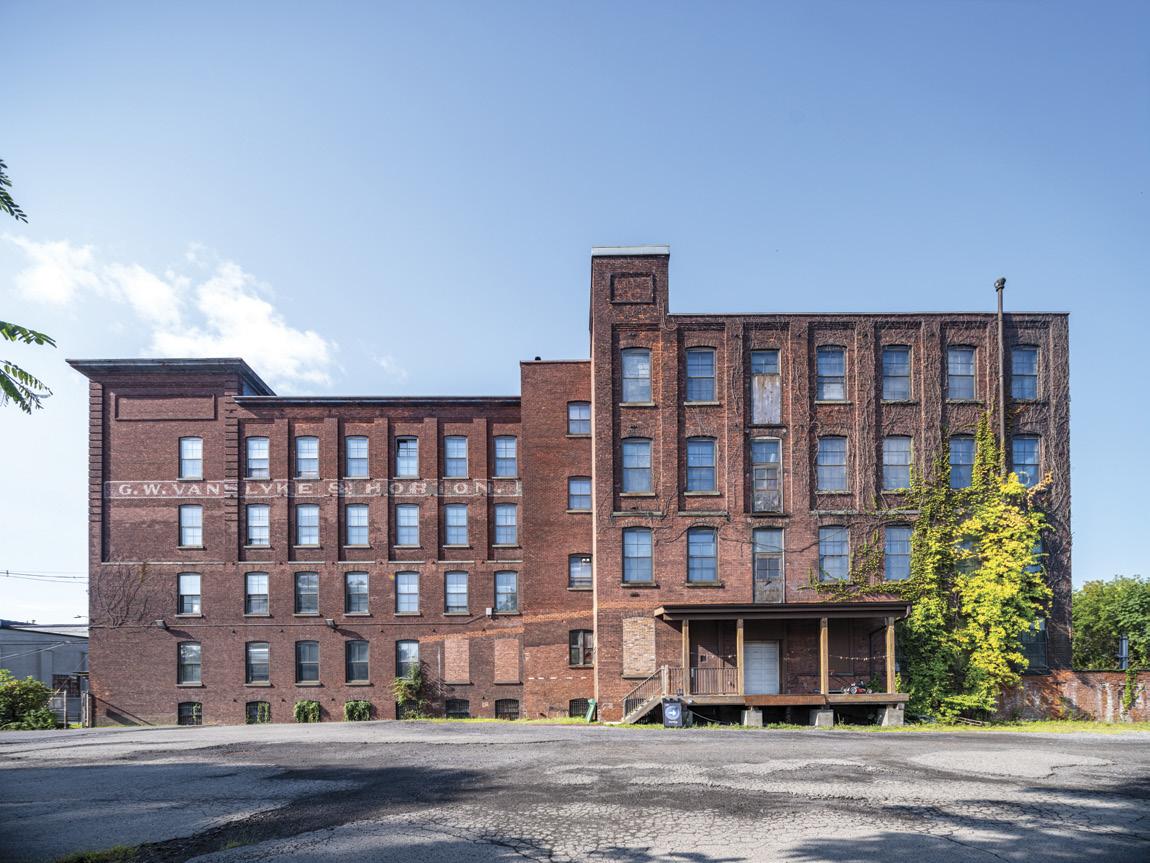
via a phone call from
credit him. Our sincere apologies to
powerlifters, CrossFitters, bodybuilders, and folks just looking to lift their groceries without pulling a hamstring. Turns out, strength training isn’t just about maxing out your squat; it’s about mobility, injury prevention, and proving to yourself that, yes, you can hoist that heavy bag of dog food. Maggie Baribault’s piece in this issue (page 38) dives into the region’s lifting boom, from community-driven gyms to trauma-informed coaching. One thing’s clear: the Hudson Valley is raising the bar—literally.
Our Home editor Mary Angeles Armstrong profiles Tess Hogan and Raymond Doyle this month (page 26), a couple who live on a farm with a couple dozen pigs—who also have the run of the house. Fine. Not for me but fine. Before moving to Ulster Park however, Hogan had a pig for a pet when she lived in Brooklyn, introducing her to a niche community of fellow porciphiles. “There are a ton of people in New York City that have pigs,” Hogan told Armstrong. “I know at
least five, and I’m sure there’s more than that. It just takes a bit of infrastructure.”
Now, I lived in Brooklyn, and I know New York City has long been a haven for eccentric pets—parrots on bicycles, ferrets in tote bags, the occasional iguana sunbathing on a fire escape. But pigs? The mind boggles at the logistics. Do they have a designated subway car, wedged between the accordion player and the guy with the pet snake? Is there an underground network of pigfriendly apartments, where landlords whisper, “We accept emotional support swine”? And what about a Take Your Pig to Work Day—do they get their own desk, or just root around in the communal snack drawer?
One imagines a city pig adjusting to urban life: Snout pressed against the glass of a bodega, longing for an oat milk cortado; sniffing out truffle fries in the Financial District; grumbling when a Williamsburg rooftop party runs past bedtime; and eventually moving up to the Hudson Valley like everybody else from Brooklyn.
By Melissa Esposito

No one expected the rollout of cannabis legalization in New York to be without incident. After all, not only is it a brand-new industry that affects multiple existing industries, from agriculture to real estate, it’s also one that’s not illegal at the federal level—a challenge that tends to snarl the nationwide green revolution with red tape.
While the journey to establishing an adult-use cannabis market in the Hudson Valley has been more of an obstacle course than an open road, it’s undeniable that progress has been made in the key areas of public awareness and economic development. In January, the NYS Office of Cannabis Management (OCM) announced that the state surpassed $1 billion in sales since the first dispensary officially opened in December 2022. (As of February 18, there were 307 dispensaries open.) This aligns with initial estimates from the state’s 2018 Legalization Impact Assessment that put the state’s pre-existing illicit marijuana market sales at a range of $1.74 billion to $3.5 billion.
However, this full-throttle market is still working through growing pains while facing the daunting task of maintaining a balance that’s fair to existing growers, processors, and retailers, as well as those still waiting in line for a license.
“Those of us who launched the industry are actually at a disadvantage to those coming in next,” says Gail Hepworth, co-owner of Hepworth Farms in Milton. In operation since 1818, Hepworth Farms had long been known for its organic produce before obtaining licensing to grow about 300 acres of hemp for CBD and one acre, per state law limitations, of THCcontaining marijuana. They also have licenses for extraction and distribution, allowing them to be a seed-to-sale, outdoor-grown cannabis producer. “We were initially told that when we started growing in 2021, the state would have 200 stores by the end of the following year. Instead, there was one, and it opened in December 2022—so we had invested a lot of capital expense up front and had a lot of product, but nowhere to sell it.”
Plus, because sales are not federally legal it’s difficult for cannabis growers to obtain loans. There are few lenders willing to work with Ythe industry and those who do often have exceptionally high interest rates. “Our business model is radical transparency and we intended to be employeeowned, but there are unexpected consequences to being employed in cannabis,” Hepworth explains. “Farmers don’t get paid until the broccoli is on the plate, so it’s common practice that farms have
March 26, 5:30pm For details, see ad on page 19.
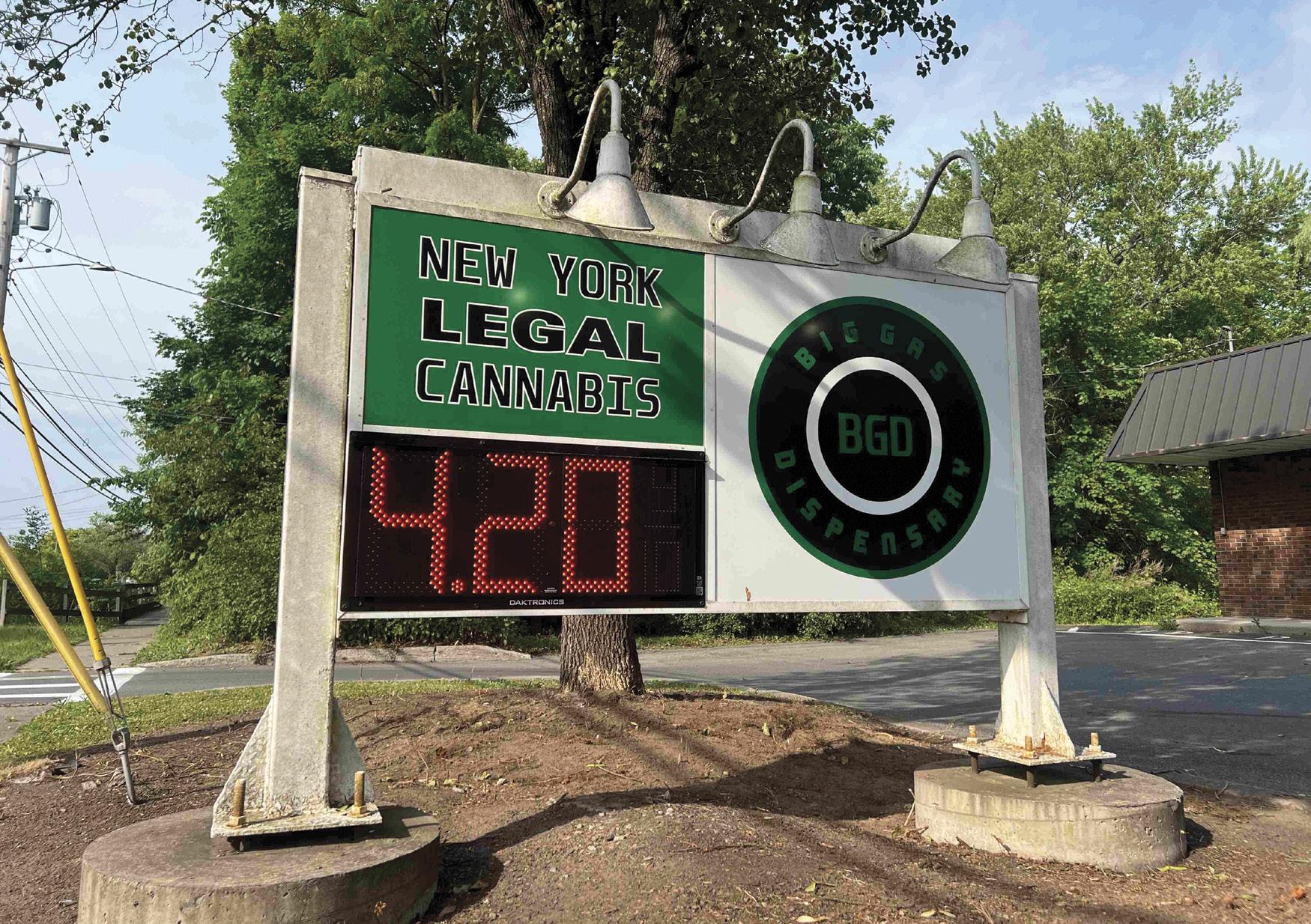
to borrow money, but banks don’t want to lend to cultivators of cannabis. Our cannabis serves our farm; we’re in cannabis to stay in business in agriculture, and serve our agricultural workers who need to have access to banking, credit, cars— so the slow rollout of the market was harmful for us, especially without the bank support.”
Although dispensaries began to spring up in 2023, by mid-summer the pace was still slower than growers anticipated with fewer than 25 retail outlets in operation, none in the Hudson Valley, and another harvest season looming. In mid-July, recognizing the potential blow to growers’ bottom lines for the second year, the OCM approved the Cannabis Growers Showcase—regulated vendor markets hosted by municipalities that could run from August through December 31. Even with the short notice, the first market opened early August in the Village of New Paltz with a few canopy-covered vendor tables outside of the former village hall.
Around the same time, the OCM was hit with a lawsuit challenging their CAURD
license distribution process. CAURD (Conditional Adult-Use Retail Dispensary) licenses are typically given to individuals with prior marijuana-related offenses, which a group of military veterans contended was a violation of the law, alleging the system was unfavorably designed to favor a small group. Because of the suit, in August 2023 the state Supreme Court blocked more than 400 CAURD licensees from opening their dispensaries until a settlement was reached in November. For those three months, retailers who had already started making payments on storefronts and stocked up on products were incurring financial losses without the ability to sell. The growers showcases became a lifeboat for cultivators, processors, and retailers. And consumers showed up.
By December, $4.8 million in sales was reported from the 60 showcases. That initial New Paltz market alone, which had grown and moved indoors, surpassed $1 million in pretax sales. According to Mayor Tim Rogers, that amount generated $30,000 in sales tax for both the Town and Village of New Paltz.
Beyond sales opportunities, the markets also became key for brand awareness. “We weren’t a part of the showcases, but we went to them to meet cultivators and get an idea of the market,” says Rudy Huston, co-owner of Riverbend Dispensary in Hudson, the first dispensary to open in Columbia County. “We received our license in February 2024 and already had an active retail store that we transformed into a dispensary. At the time, there was a real estate race because of distance requirements in certain towns, such as you can’t be within 2,000 feet of another dispensary, so we had an advantage by already having the building and opening quickly on July 1.”
Since their opening, several dispensaries have popped up nearby, one just a few blocks away. “Many have opened around us but each has a different way of doing business, so it’s not like what happened in Great Barrington, where they had one dispensary do well, and then suddenly 10 more dispensaries all opened in one medium-sized town,” Huston explains. “Despite the setbacks and the lawsuit delay, right now the state seems to be managing dispensary rollout in a way that
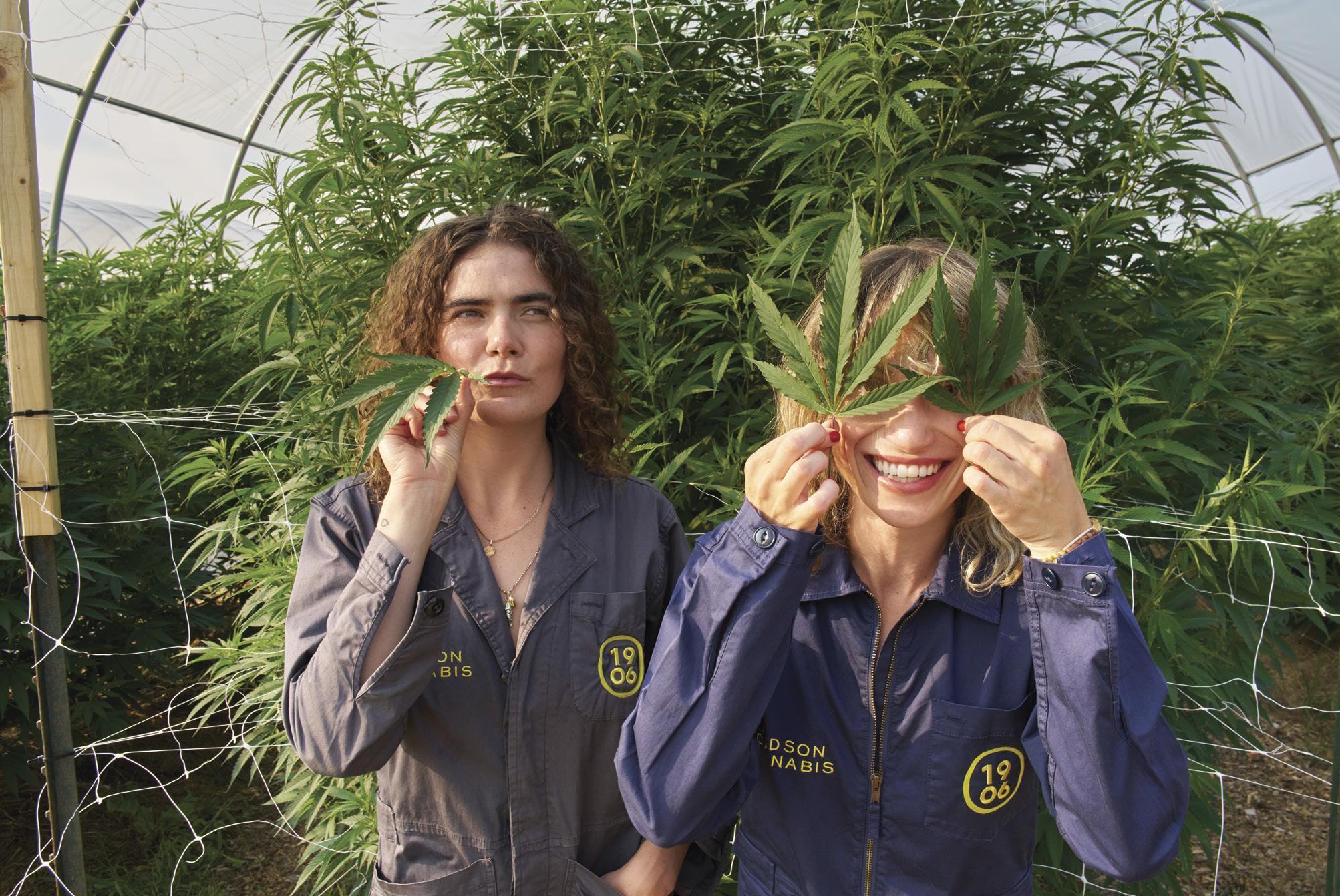
allows us to meet demand. But there has to be a continued correlation between volume that can be grown, what the average dispensary can sell, and the number of stores in a town to avoid either oversaturating the market or not meeting demand.”
Out of the current 307 dispensaries, nearly 40 are within the Hudson Valley and Albany. Because of that growing number, and the fact that 2024 was a banner year for harvests, some farmers are challenging the viability of the one-acre limit for growing THC, which allows an average of 1,500 to 3,000 plants. Hepworth says that there’s a movement to encourage the OCM to allow up to five acres of crops. “For many farmers, one acre of cannabis is very hard to earn a living off, unless it’s incorporated into an existing food farm,” she says. “There’s a lot of lobbying to increase acreage because it’s otherwise not viable for making a living, especially if there’s a wet season, which is not good for the plants.”
Although some cultivators are eager to grow more, the OCM’s calculated approach aims to meet the fluctuating needs of the entire supply chain. “Right now, the scales are balanced in a way
to ensure there’s opportunity for all areas of the New York State cannabis industry,” says Felicia A. B. Reid, acting executive director at the OCM. “Twenty twenty-four was an incredible harvest year, and folks are getting more innovative, but we want to make sure we continue to grow the industry responsibly. We’ve seen other places not manage rapid growth well and experience a devaluing of licenses, or of land, so we need to consider the whole supply chain to maintain a balance of opportunities.”
Reid has been with the agency since June 2024 and set her focus on accelerating licensing, maintaining communication opportunities with cultivators, and developing socio-economic equity opportunities, like a CAURD Grant Accelerator to fund operation costs, security needs, and increasing access to financial services for new businesses. Reid says she expects demand to continue growing across the state, and that it’s crucial to figure out how to develop the industry in a way that’s in line with equity initiatives.
“There aren’t many examples of industries that go from the black/gray market to fully regulated— except maybe alcohol in the 1920s,” she says. “Not only is it a rapidly developing industry, but
it’s centered around a plant that needs a lot of attention to grow, and is still dealing with stigma. When I was in school we had DARE, which put marijuana in the same category as crack, and historically there’s been a lot of propaganda about what cannabis is and who does it, often based in classism, racism, and marginalization. But acceptance is growing.”
While social stigmas may be easing, the issues around federal illegality persist. For instance, Hepworth Farms’ lead grower has been working at the farm for years but was recently denied citizenship directly because he works in the cannabis industry. “Even with a legitimate green card and executive job—he’s worked his way up to being our VP of Cultivation—he was denied,” Hepworth explains. “Yet, another employee who had more experience on the produce side of the farm was able to get her passport. Agriculture is a job we take great pride in; everything we grow ends up in someone’s body, so all of us here take great care of what we do. Our tomatoes have to have great flavor, high quality, and be healthy for you. So does our weed. But we need to be able to protect our employees, provide livable wages, and continue to grow the industry in a way that is fair to all.”








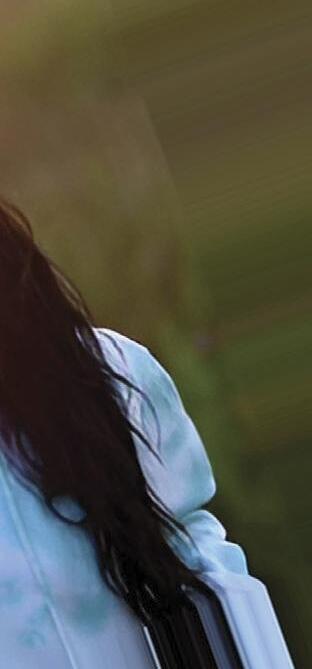




























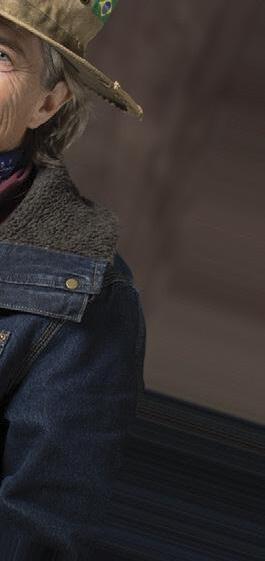









































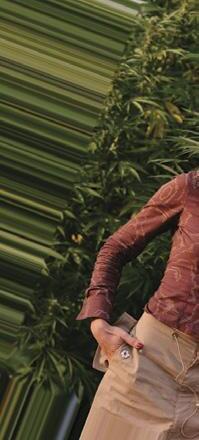


















































































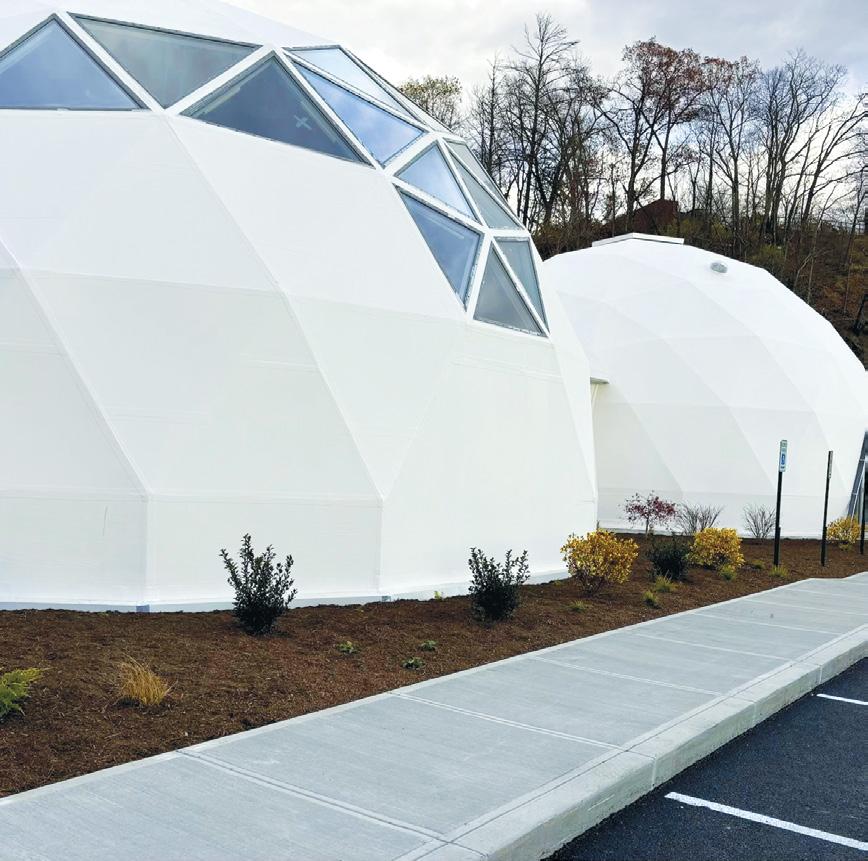
268 Forest Hill Drive, Kingston Domesdispensary.com
One of the most architecturally striking dispensaries in the Hudson Valley and perhaps all of New York, Kingston’s Domes Dispensary is impossible to miss. Two geodesic domes seem to hover in space on Route 28, just off of I-87’s exit 19, catching the eye of every passerby.
The domes were originally the brainchild of locals Valerie and Joe Stote, who dreamed of a community hub and garden center. That creative spirit lives on, with the space now doubling as a venue for after-hours music events. Under its cathedral-like ceiling, the domes’ acoustics rival a Juilliard concert hall.
Domes Dispensary officially debuted on November 27, 2024—Green Wednesday, the cannabis world’s answer to Black Friday—with neighbors gathering from nearby Hurley, Woodstock, Saugerties, Rhinebeck, and Hudson. Owners Jennifer Dundas and David Tivnan have built a dispensary that feels as curated as it is welcoming, with a skylit interior and an emphasis on supporting New York’s small farms. They go beyond just selling cannabis; they regularly host farmers and educate staff on sustainable cultivation.
The shelves are stocked with flower, pre-rolls, vaporizers, tinctures, edibles, and accessories, while knowledgeable budtenders help customers find their perfect match—whether they’re first-timers or seasoned connoisseurs looking to switch things up.
With its bold design, deep community ties, and thoughtfully sourced products, Domes Dispensary is a standout in the Hudson Valley and Catskills region’s growing cannabis scene.
Produced by the Chronogram Media Branded Content Studio.

18 Westage Drive Suite 7, Fishkill FCDISPO.com
Farmers Choice in Fishkill brings the charm of a farm stand to the world of cannabis. Inside, a vintage John Deere tractor from 1949 and vibrant market-inspired décor set a warm tone—like stepping into a Saturday morning at the farmers’ market.
Opened with a commitment to quality, Farmers Choice sources premium cannabis from top-tier New York growers and producers. Just as essential as great products is great guidance—knowledgeable staff are eager to educate customers on everything from cultivation to choosing the perfect strain.
The dispensary regularly hosts pop-ups, inviting farmers to share their stories and expertise. By prioritizing relationships with local growers, producers, and suppliers, Farmers Choice ensures every product meets the highest standards for quality and safety.
First-time dispensary visits can feel daunting, but the staff excels at making recommendations tailored to individual needs. Their goal? Every customer walks out informed, confident, and excited about their choices.
The shop carries a full range of products—edibles, beverages, vapes, pre-rolls, flower, concentrates, and accessories. Conveniently located off Route 9 and I-84 in the Hudson Valley Towne Center, Farmers Choice now offers delivery. Whether you’re a seasoned enthusiast or just canna-curious, this dispensary is a welcoming hub for all.
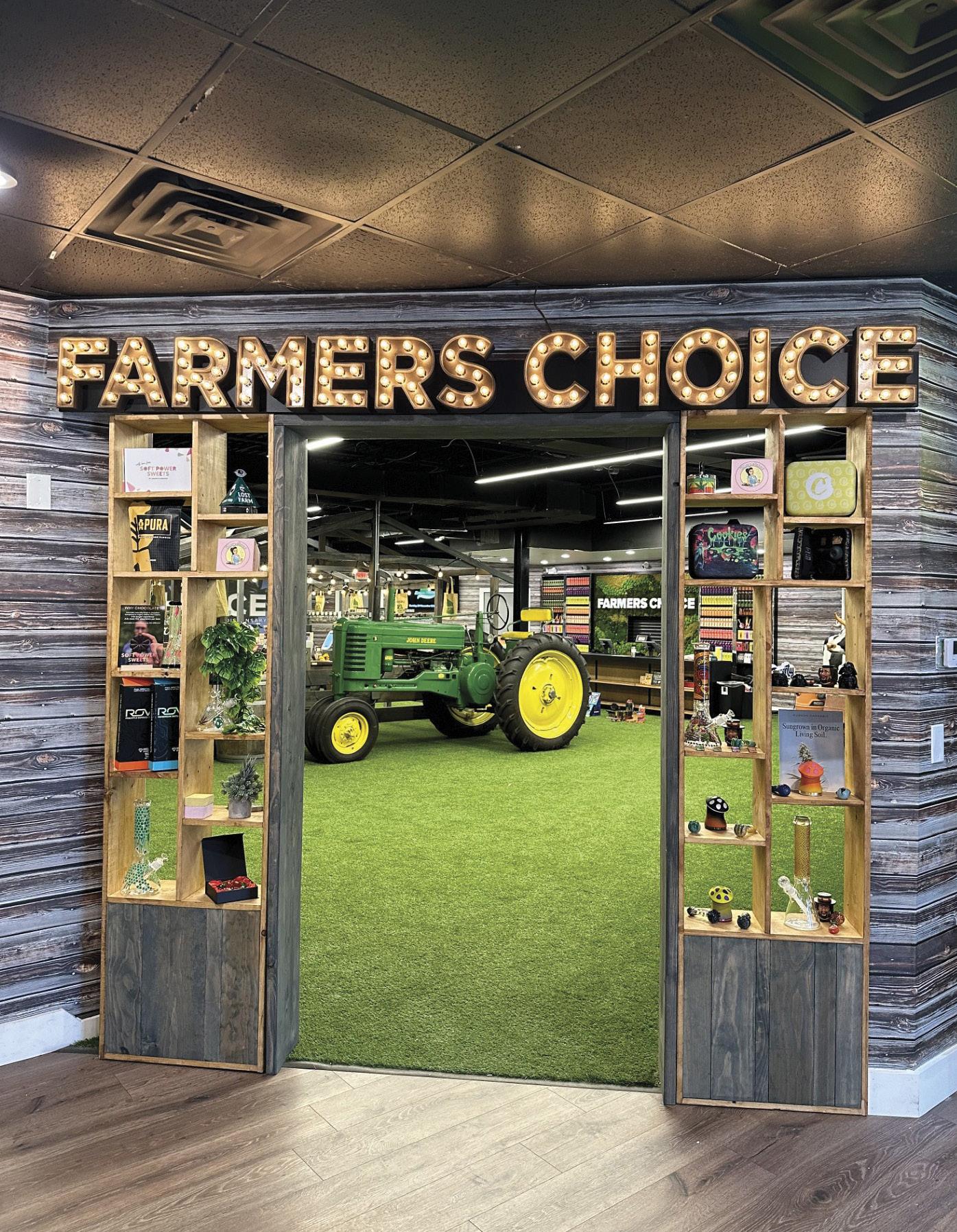


3665 Albany Post Rd, Poughkeepsie Hvgrounded.com
In the heart of Hyde Park, the recently opened Grounded Dispensary provides a holistic cannabis experience. Rooted in community, this family-owned and operated shop has taken an integrative approach to bringing high-quality, locally sourced cannabis to the area.
Opening Grounded was a labor of love. In 2022, husband and wife Frank and Stephanie Barone, along with two other couples, applied for a dispensary license, and received approval the next year. Finding the perfect property the following month on Route 9, Barone Partners LLC worked closely with the town to open shop in January.
The store itself reflects a deep connection to the Hudson Valley, from its locally crafted wood interiors to the apple tree centerpiece, a nod to the region’s agricultural heritage. Grounded focuses on smallbatch, craft cannabis products sourced predominantly from local businesses. Interactive screens provide detailed product information, making the selection process informative and accessible.
In keeping with the shop’s name, one of the standout features of Grounded is its salt cave—the only one of its kind in the world. Originally envisioned as a private consultation space, the concept evolved into a mini-retreat where customers can enjoy a brief, immersive salt therapy session while consulting with a budtender. The salt cave enhances the dispensary’s wellness experience, integrating respiratory health benefits into the cannabis retail space.
Inspired by a trip to Amsterdam, the owners envisioned a space where cannabis could be enjoyed without the stigma it has in the states. The dispensary now offers online pickup and a recently launched delivery service, serving customers from Rhinebeck to Wappingers Falls.
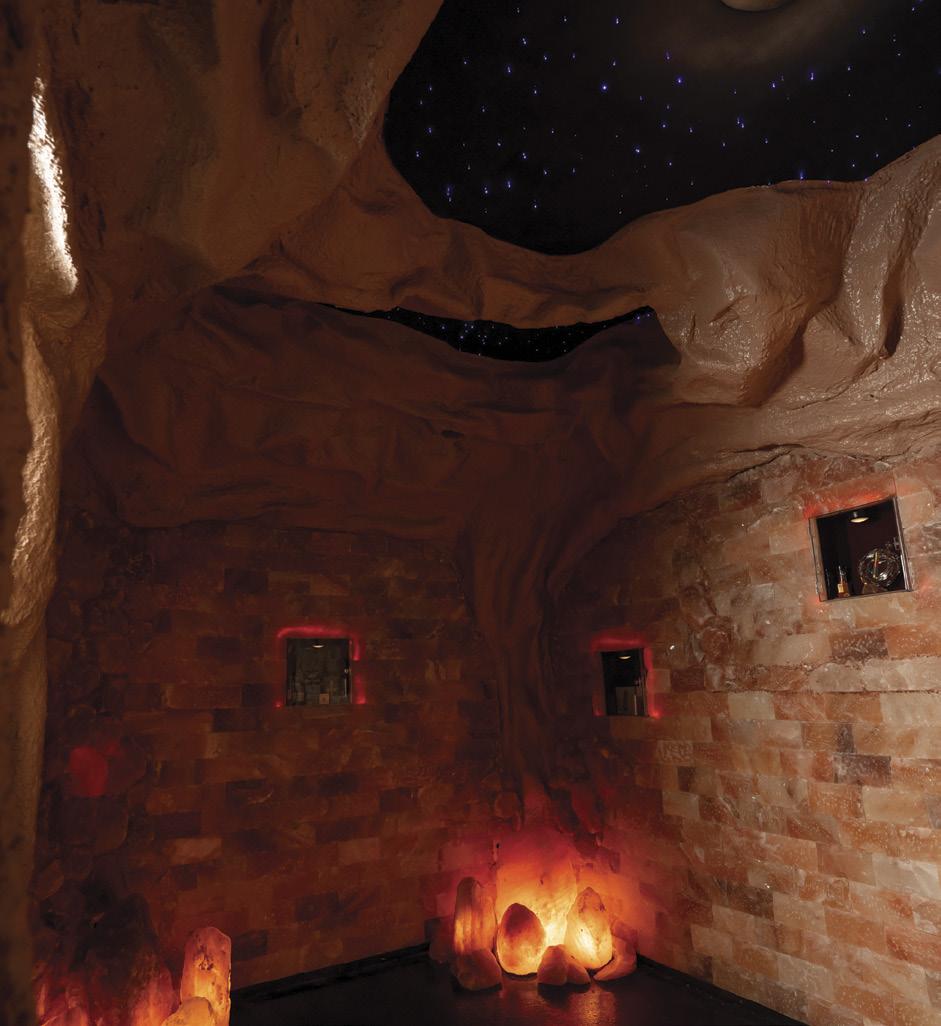
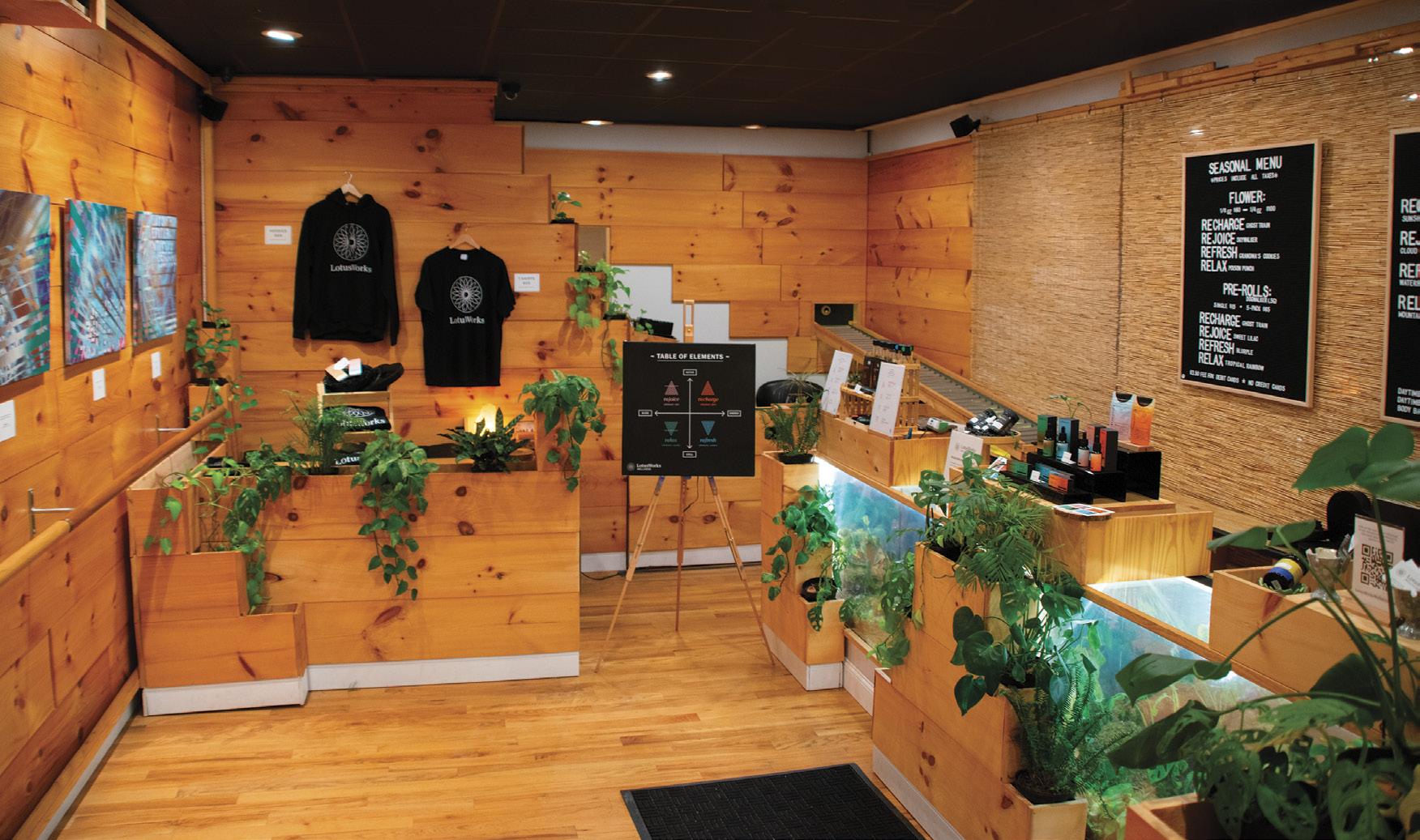
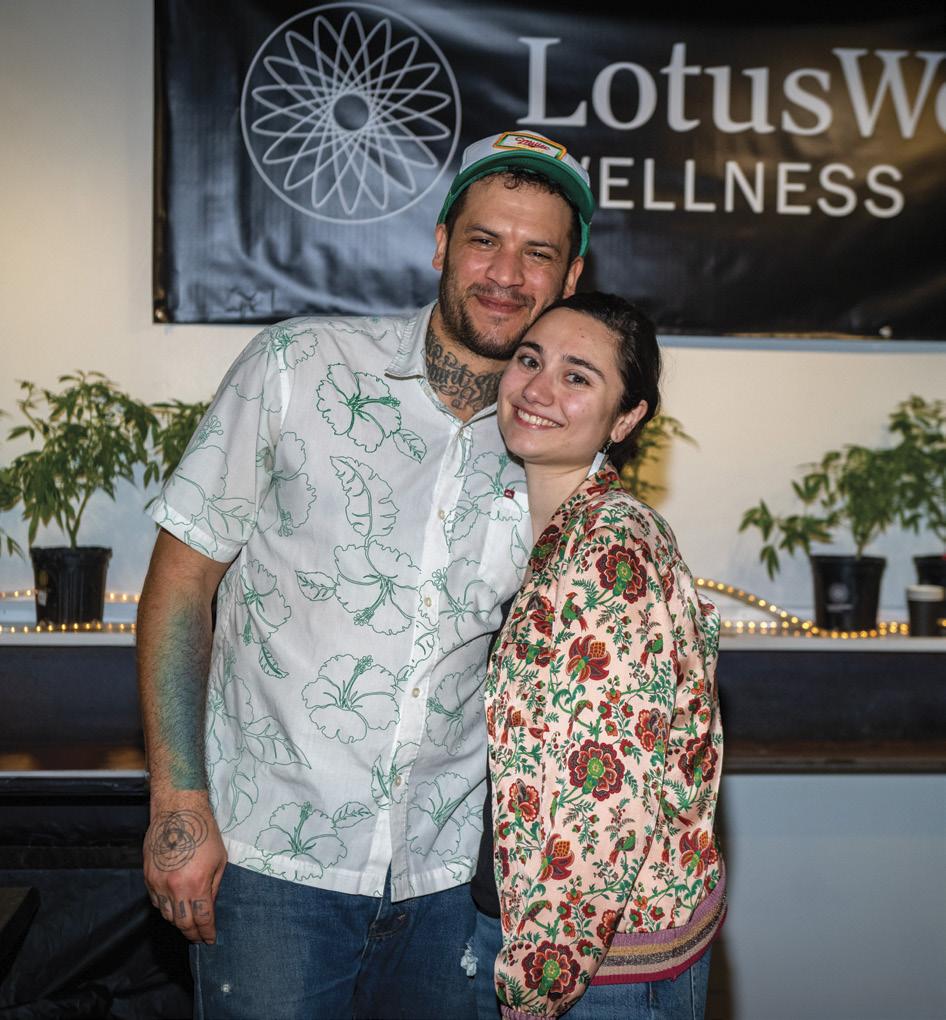
261 Main St, Beacon Lotusworkswellness.com
LotusWorks Wellness in Beacon is where cannabis, creativity, and community come together in a one-of-a-kind dispensary experience. More than just a retailer, LotusWorks is a lifestyle brand that produces a variety of events, exhibits, and workshops, blending cannabis culture with creative pursuits and holistic practices.
Enriching and supporting Hudson Valley’s deep well of talent is at the foundation of LotusWorks. Established in 2020 as a studio space for artists Skyla Schreter and Aaron Sanders, it quickly expanded into a gallery showcasing independent local artists, later adding workshops and classes. The shop’s artistic DNA runs deep. Sanders designed and built the interior, while Michelle Silver, co-owner of Beacon’s Distortion Society tattoo shop and gallery, creates its bold, bespoke packaging. Today, the shop’s ongoing events and rotating exhibitions of regional artists keep the creative energy flowing.
Growing from Sanders’ roots in Humboldt, California’s cannabis industry, LotusWorks became New York’s first state-licensed microdispensary, meaning everything from cultivation and processing to sales is done through its own label. Like a microbrewery, it exclusively retails its own craft cannabis, grown and produced in the Hudson Valley. Carefully curated effect-based product lines— Relax, Refresh, Rejoice, and Recharge—offer tailored experiences, alongside a THC-free collection of CBD products.
Alongside its flagship Main Street location, LotusWorks is expanding—soon offering curated delivery, an on-site consumption space, and distribution to select dispensaries across the state.


3056 Route 213, Stone Ridge Backhomedispensary.com
For a truly hands-on cannabis experience, Back Home Dispensary in Stone Ridge doesn’t just sell the plant— it grows and retails it. Rooted in the Hudson Valley’s agricultural and creative scene, the dispensary partners with small businesses to bring the freshest, locally crafted products to market.
Owner Will Leibee has spent 20 years cultivating organic vegetables and cannabis from Asheville to Back Home Farms in High Falls, supplying produce to the Woodstock and Union Square farmers’ markets. When New York legalized cannabis, Back Home made history by selling the state’s very first bag of recreational flower— and it continues to grow for dispensaries in Manhattan and beyond.
Staying true to its quality-first ethos, Back Home partners with Hudson Valley artisans instead of corporate suppliers. One standout collaboration is with Soft Power Sweets, the CBD caramel and edibles brand by Lagusta’s Luscious in New Paltz. The dispensary is also deeply woven into the region’s arts and music scene, making its mark at festivals like Mountain Jam and Follow the Arrow.
Open daily, Back Home Dispensary offers in-store shopping, online ordering, and pickup. Expect a selection of home-grown flower, pre-rolls, and edibles, alongside vapes and accessories—all with a hyper-local touch. Produced by the Chronogram Media Branded Content Studio.
7345 South Broadway, Red Hook Upstatepines.com
This contemporary, upbeat, locally owned and operated dispensary carrys premium cannabis products for every level of cannabis consumer. Upstate Pines focuses on the best products from local cannabis farms and distributors, which have become customer favorites. Knowledgeable bud tenders are ready to explain their wide array of products. There truly is something for everyone.
17 Tinker Street, Woodstock Herbalwoodstock.com

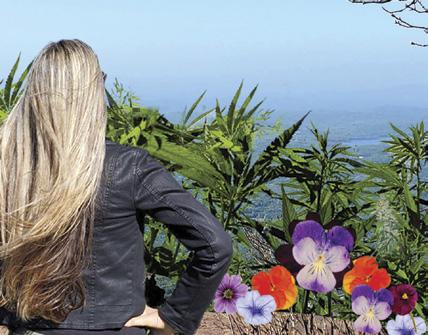
A destination cannabis dispensary that is rooted in deep plant knowledge and a legacy of community education and service. Consciously curated, supporting New York’s growers, and embracing the natural beauty of the Catskills, HERbal Woodstock reflects and celebrates the free spirit of Woodstock, their well-known hometown. Opening March 2025.
March 26, 5:30pm
Join Chronogram for an evening of discussion and networking. This panel discussion will bring together dispensary owners, cannabis farmers, and industry experts to explore the victories, setbacks, and future of

531 Warren St., Hudson Riverbenddispensary.com
Founded with a love for the region, Riverbend Dispensary in Hudson is the brainchild of longtime friends Rudy Huston and Ed Glickman. Hudson has a deep-rooted hemp history, and Riverbend embraces the chance to educate the community on all things cannabis.
As Columbia County’s first legal recreational dispensary—and one of New York’s first social equity dispensaries with a CAURD license— Riverbend prioritizes small-batch, artisan growers, many from the Hudson Valley. The farm-to-table approach means shoppers learn not just what a flower does but where it comes from, with every product reflecting craftsmanship and sustainability.
The shop offers a wide selection, from flower, pre-rolls, vapes, and tinctures to low- and no-THC options. An extension of the dispensary’s belief in the healing properties of cannabis, Wellness on Warren is a curated collection of infused and THC-free or nonpsychoactive products, offering something for everyone—whether they seek relaxation, focus, or help with sleep.
For first-timers or anyone who wants a little more of a nuanced cannabis lesson, Riverbend Dispensary offers a Coffee & Consult service, where visitors can meet with expert budtenders over coffee for tailored recommendations on products and consumption methods.

1. Back Home Cannabis Co. 3056 State Route 213 Stone Ridge, NY (732) 673-6442
Backhomedispensary.com
Back Home Dispensary is a hyper-local Cannabis Dispensary in Stone Ridge. They grow, manufacture, and source high quality products from mixed light greenhouse flower to super rich trichome indoor flower, as well as fruit for their gummies. Quality, transparency, and good energy is the foundation of Back Home's superior cannabis products.
2. Berkshire Roots 501 Dalton Avenue Pittsfield, MA
3. Big Gas Dispensary 98 North Chestnut Street New Paltz, NY
4. Black Market Canna Co LLC 89 Main Street Poughkeepsie, NY
5. Bloom Brothers 2Larch Street Pittsfield, MA
6. Budd's Dispensary 70 W Bridge Street Catskill, NY
7. Buzzsaw Cannabis Company 5044 Route 17M New Hampton, NY
8. Calyx Berkshire 307 Main Street Great Barrington, MA
9. Canna Planet Ellenville 37 North Main Street Ellenville, NY
10. Canna Planet Kingston 1221 Ulster Avenue Kingston, NY
11. Canna Provisions 220 Housatonic Street Lee, MA
12. Catskill Mountain High 308 Plaza Road Kingston, NY (845) 802-0831 Catskillmtnhigh.com
Catskill Mountain High is thrilled to announce our opening in Kingston Plaza! Come browse our carefully curated selection of quality cannabis products designed with all sorts of experiences in mind. Delivery and online ordering available.
13. Clear Sky Cannabis 221 State Road North Adams, MA
14. Cloud 914 807 Washington Street Peekskill, NY
15. County Road Cannabis 1326 County Route 12 New Hampton, NY
16. Devine 71 Main Street Egremont, MA
17. Domes Dispensary 268 Forest Hill Drive Kingston, NY (845) 768-3805
Domesdispensary.com
Housed inside two geodesic domes on the road from Kingston to Woodstock, Domes Dispensary is a must-visit. This familyowned and operated gem prioritizes local farms at great prices, all in a jawdropping, cathedral-like interior.
18. Farmers Choice Dispensary 18 Westage Drive Fishkill, NY (845) 440-3647
Farmerschoicedispensary.com Farmers Choice Dispensary in Fishkill is your go-to spot for all your cannabis needs! With a chill vibe, friendly staff, and an awesome selection of flower, edibles, and more, it’s the perfect place to elevate your day!
19. Farnsworth Fine Cannabis Company 126 Main Street Great Barrington, MA
20. Gotham Hudson 260 Warren Street, Hudson, NY
21. Gratitude Buds 814 NY-52, Fishkill, NY
22. Great Barrington Dispensary 454 Main Street Great Barrington, MA
23. Grounded Dispensary 3665 Albany Post Road Poughkeepsie, NY (845) 240-1244
Hvgrounded.com
Grounded’s nature-loving approach, combined with a commitment to holistic health, makes Grounded a unique destination with our welcoming environment, knowledgeable staff, diverse product range, and unique features like the salt cave, we provide a comprehensive wellness experience for everyone.
24. HERbal Woodstock 17 Tinker Street Woodstock, NY
Herbalwoodstock.com
HERbal Woodstock is a Mother-Owned destination dispensary that embodies the spirit of our famous hometown. Locally rooted, consciously curated, HERbal Woodstock embraces nature, lifts up New York growers
and serves the community with deep plant knowledge and a focus on wellbeing. Opening March 2025!
25. HiBrid 1317 East Street Pittsfield, MA
26. Indica, LLC. 127 Columbia Street Adams, MA
27. Jack's Cannabis Company 1021 South Street Pittsfield, MA
28. Kapha Cannabis Dispensary 439 Pittsfield Road Lenox, MA
29. Liberty Market 35 North Main Street Lanesborough, MA
30. LotusWorks Wellness 261 Main Street, Beacon, NY (845) 440-6348
Lotusworkswellness.com
LotusWorks Wellness is New York State’s first micro-dispensary, showcasing their own brand of Hudson Valley craft cannabis products. Be sure to check out their unique flagship retail location on Beacon’s bustling Main Street!
31. Orange County Cannabis 1308 Dolsontown Road Middletown, NY
32. PlatinumLeaf 196 Rock Hill Drive Rock Hill, NY
33. Rebelle 783 South Main Street Great Barrington, MA
34. Riverbend Dispensary 531 Warren Street Hudson, NY (413) 673-0103
Riverbenddispensary.com Riverbend Dispensary is locally owned, offering top-quality cannabis, edibles, and concentrates from New York’s best craft farms. Visit their welcoming Hudson shop for a curated selection, expert guidance, and a true farm-to-consumer experience rooted in quality and care.
35. Root 9 Dispensary 1546 Route 9 Wappingers Falls, NY
36. Royal Blend Dispensary 2223 State Route 32 Kingston, NY
37. Silver Therapeutics 238 Main Street Williamstown, MA
38. Sweetgrass Botanicals LLC 635 Laurel Street, Lee, MA
39. The Pass 1376 North Main Street Sheffield, MA
40. The Weedery Micro Dispensary 3 Water Street New Paltz, NY
41. THTree 12187 Route 9W West Coxsackie, NY
42. Upstate Pines 7345 South Broadway Red Hook, NY (845) 422-6914
Upstatepines.com
Located in the town of Red Hook, Upstate Pines is a contemporary, upbeat, locally owned and operated dispensary. From life long cannabis consumers to newly curious clients–everyone feels welcome and happy at Upstate Pines.
43. Valley Greens 939 Central Ave Peekskill, NY (914) 293-0231
Valleygreensny.com
Valley Greens is your retro-inspired Cannabis store where nostalgia meets modern convenience. They offer a welcoming and approachable experience for customers of all backgrounds.
44. White Atmoss 136 Lake Street, Suite 2 Newburgh, NY
45. Be. Hudson Valley 1147 US-9 Wappingers Falls, NY
46. Curaleaf NY, LLC 8 North Plank Road Newburgh, NY
47. Etain Kingston 445 State Route 28 Kingston, NY
48. Temescal Wellness 10 Callahan Drive Pittsfield, MA
49. Theory Wellness 394 Stockbridge Road Great Barrington, MA


By Melissa Esposito
Adeeper connection to nature, one plate at a time: This is the driving philosophy of Taiga, the self-proclaimed “wild kitchen of the world,” and Hudson’s new farm-to-table hot spot.
The name itself is a reference to the deep forests of high-latitude locales like Siberia. In contrast to the inhospitable climes of the taiga, the restaurant offers an elegantly welcoming environment in an intimate setting where meals are sustainably sourced, artfully plated, and ever-changing. Instead of acquiring ingredients to for signature dishes, Chef Vlad Larvin works in harmony with local farms, allowing their harvests to dictate what goes on each monthly changing menu.
“Nature has always been very important to us, as we both originally come from places with lots of mountains and lakes,” explains Waldemar Sirko, founder, and Larvin’s partner. “It’s our mission to remind people that they can fall in love with nature through food, design, and new experiences.”
Sirko was born in Poland and Larvin in Russia, but the two have lived in the Catskills for almost three years after having discovered the region.
“We fell in love with this area—the hiking, being outdoors—and eventually moved here with our four dogs,” Sirko says. “During the retreats we’ve hosted [for a former wellness business], people would always say how much they loved our food, so eventually the concept of Taiga was born.”
Taiga, opened in October of last year, is the pair’s first restaurant. Sirko and Larvin have worked on their own projects ranging from retreats to retail, but have no previous experience in the restaurant industry. But cooking has always held a special nostalgia for Larvin, who grew up in Russia making fond memories in the kitchen with his grandmother. There, he learned how to cook family recipes and grew to appreciate the heart and patience it takes to cook and bake from scratch.
Larvin utilizes many family and ancestral recipes and techniques in his kitchen, including one of his grandmother’s favorites, a Napoleon cake made with homemade butter and berries. And besides working with local farms such as Highland Farm Game Meats, the Tiny
Farm, Churchtown Dairy, and others, Larvin sources a few specific ingredients from purveyors in Russia, including spices, dried fruits, and honey from Altai, a Russian republic in southern Siberia.
The pair also obtain ingredients for homemade tea blends from the same region that they serve at the serve at the restaurant and sell on-site in a small retail pantry.
“We’re famous for our tea—it’s a mix of herbs that are very delicious, brought from the Altai and Belukha mountains,” he explains. “These are unique collections of more than 36 types of herbs, such as Sagan Doylya, which grows only one month a year; Ivan tea; thyme; mountain mint; golden root; and other rare herbs that boost immunity and do not contain caffeine. For some ingredients, we have less than three weeks per year to collect them, so these teas are very special.”
Although the menu changes monthly, this month, you’ll find an array of savory, flavor-rich options including starters like Russian herring with young potatoes ($22); roasted carrots with pear, mountain goat cheese, and pine nuts ($21); or

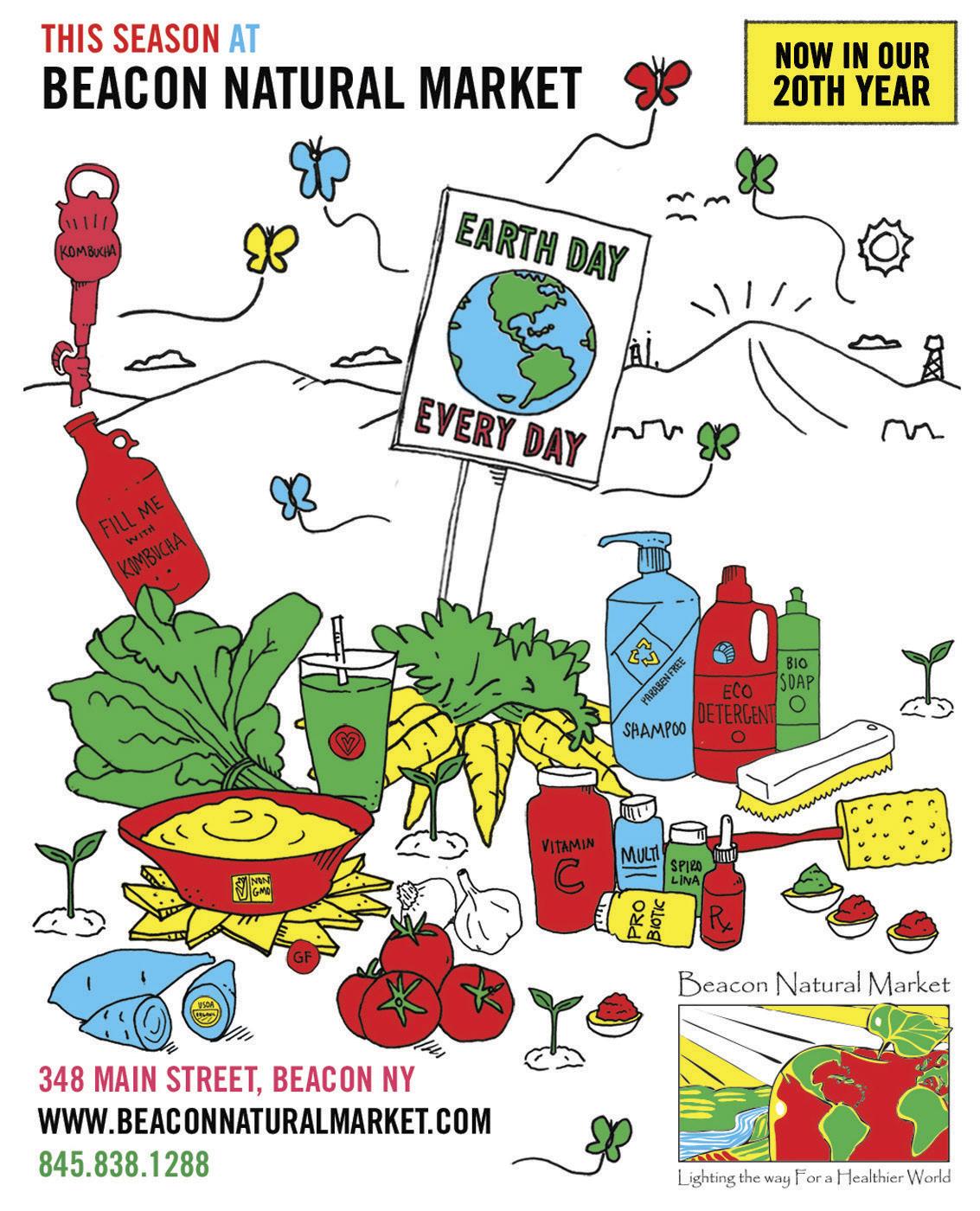
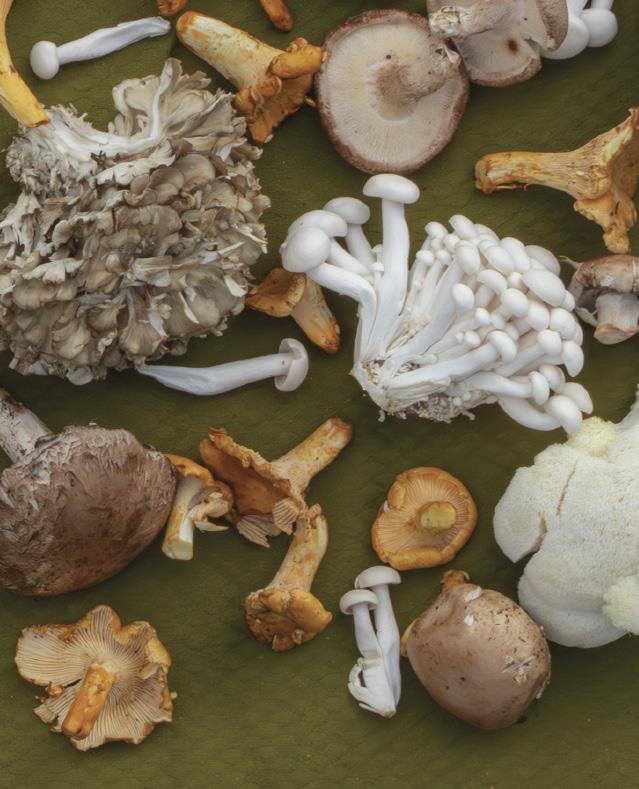











4 Park Place, Hudson (518) 697-5633 Hudsonroastery.com
Visit Columbia County’s only coffee roastery; offering single origin selections along with their proprietary signature blends. The highest quality beans are freshly roasted daily, producing their exquisite coffees which brew delicious drinks. Whether it’s Rip Van Winkle, Catskill Campfire, or Spook Rock Road, they proudly present nine coffees varieties to enjoy and take home. This is also a place where the community gathers to enjoy the best coffee, conversation, freshly baked pastry, and a chef inspired menu.
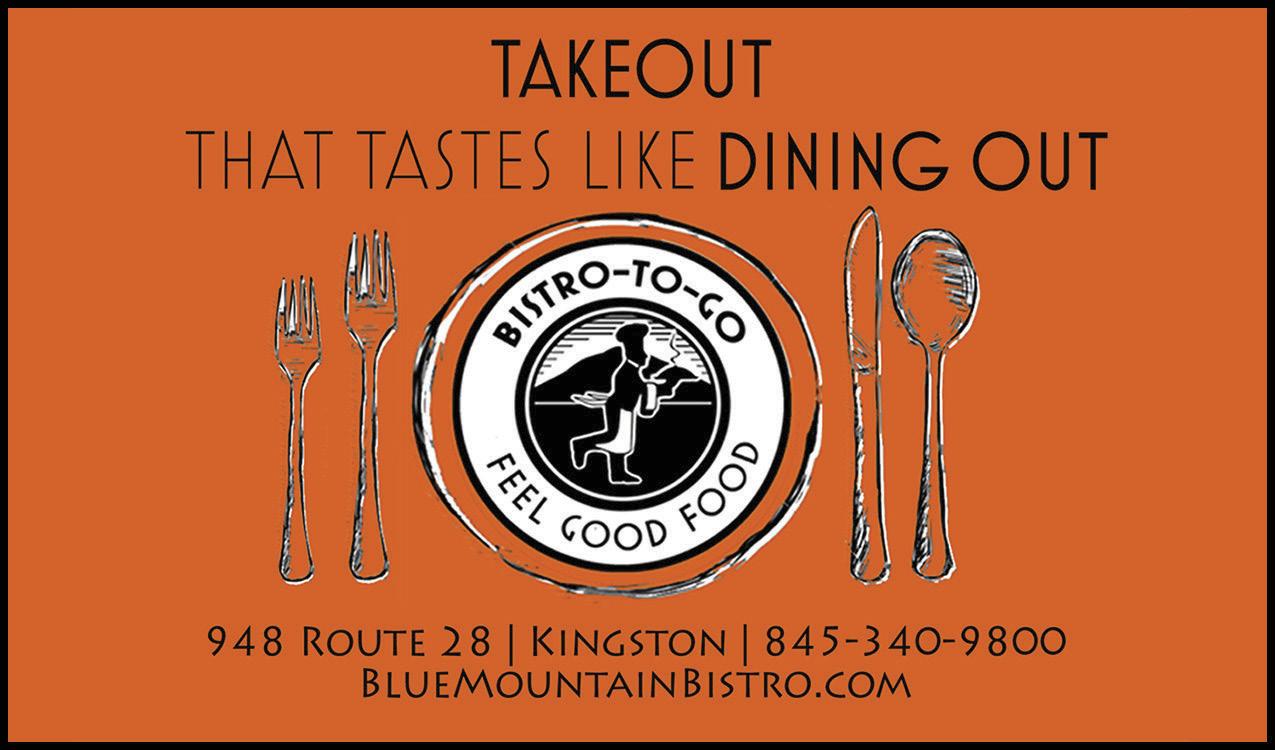



Brussels sprouts with wine sauce and Georgian pomegranate ($21).
Earthy entrees include a baked chicken breast with potatoes, wild lingonberries, mint, herbs, and olives ($28); a salmon burger on housemade bread with pineapple, tomato, cucumber, jam, and Siberian herbs and sauce ($27); or their signature dumplings, a version of pelmeni, the Russian national dish that originated in the Ural Mountains of Siberia, made with Atlantic salmon, housemade soft cheeses, green onions, and Altai herbs ($33).
“Hudson has never had anything exactly like this, and a lot of what Vlad cooks is so unique, with new dishes all the time,” Sirko says. He mentions that although they’re still waiting on a liquor license, mocktails are available, and a full bar program, along with weekly live music, is in store for the future.
The pair are also responsible for the restaurant’s interior design—dazzling enough for date night with cascading crystal chandeliers that shine against damask wallpaper over deep hunter-hued wainscoting. But the setting is tempered with a nostalgic nod to grandma’s kitchen through vintage-style white crocheted tablecloths and dried flowers, native to the Hudson Valley, hanging over the white marble bar.
“We see a pretty mixed crowd; there are a lot of people still learning about us, but we do see some of the same people coming back almost every weekend,” Sirko says. “We want people to have a full experience, whether solo, with loved ones, with family—to offer a place they can really be present and enjoy a farm-to-table experience.”
Taiga is located at 119 Warren Street and is open from Thursday through Sunday, 3-10pm. Taigarestaurant.com


Irish Hospitality in the Heart of New Paltz
Irish hospitality isn’t just a saying—it’s a tradition rooted in early Irish law, which once required households to offer food, drink, shelter, and entertainment to strangers. That same spirit of warmth and welcome runs through every inch of Garvan’s Gastropub in New Paltz.
Since opening in 2016, owner Garvan McCloskey has made it his mission to bring an authentic Irish experience to the Hudson Valley. “It’s going to be Irish in the way that it really means. I want people to feel comfortable, like they’re in my living room,” he told an interviewer when Garvan’s opened nine years ago.
Housed in a storybook 1759 house, Garvan’s blends architectural charm with hearty, crowd-pleasing fare. The menu pairs Irish classics with the fresh ingredients the Hudson Valley is known for, offering everything from Guinness lamb stew to vegetarian shepherd’s pie—plus plenty of options for gluten-free diners.
Beyond the food, Garvan’s is a gathering place. The gastropub hosts anniversaries, small weddings, and weekly Irish music sessions on Thursdays, with lively St. Patrick’s Day festivities on the horizon. And whether you’re toasting with a perfectly poured pint or a Lavender Dream mocktail (a floral mix of lemon juice, seltzer, lavender simple syrup cubes, and a rose sugar rim), the bar has something for every taste.
“Whether someone comes in for a comforting bowl of clam chowder, or a beer and some Irish music, it’s our pleasure to offer a warm and friendly space with exceptional service,” says McCloskey.

By Mary Angeles Armstrong
Photos by Winona Barton-Ballentine
Tess Hogan and Raymond Hoyle with Urban, Delilah, Mugsy, Penny, Hector, Babs, Bryan, Xavier, Tex, Jemima, Helga, Happy, Edie, and Kerosene. The couple revamped the covered porch and the front of the house especially for pig-human bonding, adding Trex decking that could stand up to pig hoof traffic, a custom bolted-down bench, a cabinet with pig-proof locks, and a fortified screen door that pigs (and dogs) can’t run through.
To Tess Hogan, living in a pigpen isn’t something to be ashamed of—in fact it ’s an architectural style more humans should aspire to. “Pigs are so intelligent, so emotional, highly sensitive, and very perceptive,” explains Hogan. “ They are empathetic creatures that are capable of deep connections with humans. Also, truth be told, they are very clean.”
Hogan’s “pigpen” is actually a charming and well kept, porcineadapted 1870s farmhouse in the shadow of the Shaupeneak Ridge. Hogan and her partner, Raymond Hoyle, share the 1,500-square foot, two-story home and surrounding six acres, once a vineyard, with a cast of four-legged companions, each with its own story and distinct personality. Over the past 10 years Hogan and Hoyle have reimagined not only the fields, barns, and overgrown vineyards, but also the entire first floor to accommodate the needs of their 21 pigs, some rescued, some born there, and a few temporary fosters waiting for the right home. With a few dogs and one adult child thrown into the mix, it is a lively, ever-evolving sanctuary that raises awareness rather than breakfast sides.

Top: After buying their farmhouse in 2015, Tess Hogan and Raymond Hoyle converted the six-acre property to accommodate their favorite species— pigs. Over the past decade they’ve adapted the first floor, a former barn, and paddocks as living spaces for their growing brood. Now “The Rise of the Pig Rescue” is home to 21 rescued pigs, two dogs, two happy swineherds, and Hoyle’s adult son.
Bottom left: A corner of the dining roomturned pig rehab-clinic-turned maternity ward features a pig print by David Shrigley. The other art and furniture was collected from Facebook Marketplace and local secondhand stores.
Bottom right: One of the couple’s fourlegged roommates. Along with their 21 permanent porcine residents, they are also fostering five pigs waiting for their forever home. “Pigs are highly emotional creatures who are capable of deep connections with humans,” says Hogan. “All my pigs know their names and most know how to sit. They all come when they’re called—my dogs don’t even do that.






Hoyle serves as head pig chef, feeding the pigs a mix of specialized grain and vegetables like “pomatos” and “poccinis” which grow from the pig manure. “Something happens in their digestive tract and all these weird hybrid vegetables grow from their waste, like butternut squash that smells and tastes like melon or these really weird, huge squash,” says Hogan. “We just feed them straight to the pigs or donate them to other pig sanctuaries.” Hoyle also oversees waste management.
Their work has yielded a symbiotic relationship between human and pigs—along with a few strange hybrid vegetables. In rescuing the pigs and reshaping their own lives to accommodate the operation, Hogan and Hoyle have transformed themselves—learning to see the world through the eyes of their companions and embracing the joys of sharing life with intelligent, complex creatures that share 98 percent of our DNA.
Hogan’s fascination with pigs didn’t start upstate—it began in the heart of Brooklyn, where she shared a Bushwick apartment with her first pig companion. I ’ve always loved pigs and wanted one,” says the Tucson native. After moving to New York City to attend Columbia University and later launching her own production design company, Fill in the Blank Productions, Hogan’s dream to own a pig became a reality when her parents gifted her a pet she named Buttercup.
While pigs can be fussy—“It ’s because they pick up on everything,” Hogan explains—she found that, with a few adjustments, Buttercup was a surprisingly city-friendly companion animal. “ This was back before Bushwick was chic, so we actually had a roof deck where she could hang out,” Hogan recalls. “Pigs are easily litter box trained and don’t really need to be walked, so I could keep her in various apartments.”
Buttercup remained a constant companion as Hogan moved from Bushwick to a three-bedroom apartment in Harlem and later to Roosevelt Island, where their routine included walks in the local park. Life with Buttercup was a master class in inter-species connection, introducing Hogan to a niche community of fellow pig enthusiasts. “ There are a ton of people in New York City that have pigs,” she explains. “I know at least five, and I’m sure there’s more than that. It just takes a bit of infrastructure.”
Hogan’s bond with Buttercup ran deeper than any connection she’d shared with other pets. “People don’t really understand pigs like they know cats and dogs,” explains Hogan. “But they are basically like three-year old humans, that ’s how they act, so they bond to you more deeply than you do with dogs.” When Buttercup eventually succumbed to cancer, the loss was profound. “It took me a very long time to get over her passing,” says Hogan. It was two years before she felt ready to welcome pigs back into her life, but when she did open her heart again, she opened it wide.
Hogan and Hoyle’s decision to move to the Hudson Valley wasn’t initially about pigs. They were simply ready for a life outside the city. “ We really wanted more space,” explains Hogan. “ We came up here in 2015 because we wanted a quieter lifestyle. Honestly, we picked the house based on the

house itself. We had no idea about the area until we went to take a drive around after we made an offer.” The couple found the red-and-green painted farmhouse on Zillow and decided to drive up and check it out in person. Their connection was immediate. “ We drove up the driveway and saw the shape of the house,” says Hogan. “I knew I could work with it.” It was not in pristine condition, but that worked to their advantage. “It was an old house and not presented well,” remembers Hogan. “ There was also old shag carpeting and wood paneling in every room.” Despite its dated elements, the couple saw the property ’s potential. “ We brought in an inspector and he told us, ‘Well everything is fine, but it’s a doll house,’” Hogan remembers. “But that was exactly what we wanted.” The house needed work, but it had character and the six-acre mix of woods, fields, and vines felt full of possibility. “It had a soul,” says Hogan. “ We could see what it could become.”
The couple’s initial renovations were human-centric. With the help of Mike Appollonia of Apologia Enterprises in Saugerties, they ripped out the wood paneling and
outdated drop ceilings, replacing them with insulation and open spaces that gave the house an airier feel. Underneath the shag carpeting, the home’s original wood floorboards were mostly salvageable. After reinforcing the foundation they restored the floor planks.
Appollonia saved the unsalvageable wood and incorporated it into the kitchen rehab, crafting new drawers and a custom wooden range hood. Because the home originally only had only one upstairs bathroom, the couple decided to capture space from a wraparound porch to create a full downstairs bathroom with a step-in shower, as well as a laundry room.
The kitchen-adjacent dining area also received a similar glow-up. “ The one thing I wanted was a beautiful, open dining room,” says Hogan. “It was set up wonderfully.” To enhance the home’s vintage vibe, they refinished the walls with skim coat plaster and added wainscoting. They also replaced dated, crooked windows throughout the home.
Originally, Hogan and Hoyle’s vision was simple: Settle in, renovate, enjoy a quieter life. But by 2018, Hogan
Since pigs can’t climb the home’s steep staircases, the second floor is a pig-free zone. In the primary bedroom, the couple bought the antique bed from the previous owners. The room includes a collection of antique carpets Hogan inherited from her grandmother. “They wouldn’t be safe downstairs with the pigs,” says Hogan.
















































338-4936 AugustineNursery.com


Monday–Saturday, 8am–5pm and Sunday, 10am–4pm
Monday–Saturday, 8am–5pm and Sunday, 10am–4pm
& Van Kleecks Lane, Kingston, NY (845) 338-4936 AugustineNursery.com Spring
& Van Kleecks Lane, Kingston, NY AugustineNursery.com
Monday–Saturday, 8am–5pm and Sunday, 10am–4pm
8am–5pm and Sunday, 10am–4pm




























The couple’s mastiff Macdougal lounges on an upstairs day bed in Hogan’s office surrounded by family photos. When she’s not rescuing pigs, Hogan runs Fill in the Blank Productions, a full-service production company.
knew she was ready to bring pigs into her life again. This time, however, she would do things differently. “I knew I wasn’t going to buy an animal,” she says. “I realized I should never get a pig from a breeder because there were so many out there in need of adoption.” Hoyle was supportive, but at that point “ he was just along for the ride,” explains Hogan.
Their first rescues, Bourbon and Delilah, came from Wayward Ranch Animal Sanctuary in Kerhonkson.
To accommodate the new arrivals, they converted old paddocks into a pen and added heat to a barn as a pig bunkhouse. In 2018, they adopted Urban, who quickly established himself as the alpha.
When Urban needed elbow surgery, they brought him inside to recover, converting the dining room into a rehab center for four months. “ The running joke has been that I made this beautiful dining room and had to turn it into a rehab zone,” says Hogan. “Once Urban got reintegrated, I thought I had my dining room back. “
It wasn’t for long. As their rescue efforts grew, so did their pig family. They took in Derek and Clive, survivors
of a failed sanctuary where 78 pigs had been crammed onto just two acres in a homeless encampment. Jolene was rescued from an elderly man and Tex soon followed. The calls kept coming and the couple kept adapting their home to meet the needs of their new rescues. They installed special kitchen storage for pig food, added Dutch doors to close off rooms, and renovated the home’s covered porch to create a shared space for both pigs and humans.
It was the rescue of Babs that finally, completely transformed Hoyle into a pig convert. “Babs was a whoopsie because she came to us pregnant,” says Hogan. Once again, the couple converted their dining room—this time into a maternity ward where Hoyle delivered piglets with the help of a veterinarian over FaceTime.
“As the pig numbers kept growing, he humored all my requests for property upgrades, sat through endless calls and forums on pig education, and sloshed through mud for rescues,” says Hogan. “But when Raymond helped deliver Babs’s babies in our dining room he was sunk, his love for the pigs was totally solidified.” Hogan adds, “ We call him grandpa Raymond now.”
Well before daffodils bloom in our gardens each spring, there’s already one item on parents’ minds: a summer camp or program that will help their little buds flourish, too. Luckily, the Hudson Valley is ripe with opportunities for exploration, imagination, and cultural enrichment for teens, tweens, and kids as young as age three. From nature-based programs to creative workshops for burgeoning artists, here are a few wonderful programs to spark the search.


Hawthorne Valley Farm Camp
Ghent (518) 672-4465 ext 203 Hawthornevalleysummercamp.org
Discover the magic of farm camp! Nestled in the picturesque Hudson Valley, Hawthorne Valley’s Farm Camp invites kids and teens ages 8-16 to an unplugged summer full of adventure, discovery, and connection. On a 900-acre organic, Biodynamic® working farm, campers dive into hands-on experiences—caring for animals, tending gardens, and harvesting fresh ingredients for farm-to-table meals. Days are brimming with classic camp fun like arts and crafts, games, archery, swimming, and exploring nature. Campers grow lasting friendships while learning the interconnected wonders of humans, plants, and animals. Whether joining for day or overnight sessions, every camper leaves with unforgettable memories, new skills, and a deeper appreciation for the world around them. Spaces fill quickly—register now for an unforgettable summer adventure!

Hudson River Maritime Museum
Kingston (845) 338-0071 Hrmm.org/youth-programs
Set sail on an unforgettable adventure with the Hudson River Maritime Museum’s Voyager Program! Perfect for ages 9-17, this hands-on, all-day summer camp blends sailing, boatbuilding, woodworking, and STEAM activities into one extraordinary experience. From July 7 to August 15, HRMM offers young Seafarers, ages 9-12, and Navigators, ages 1317, six action-packed weeks of learning from professional educators, woodworkers, and certified sailing instructors. Whether exploring the Hudson’s rich maritime history, crafting boats, or enjoying three hours of daily sailing, kids will build confidence, creativity, and lasting friendships. Don’t miss this one-of-a-kind journey—register now for one week (or more!) for a summer of discovery and fun.

Mountain Laurel Waldorf School
New Paltz (845) 255-0033 Mountainlaurel.org/summer
Conveniently located in the heart of New Paltz, this summer program offers an enriching and nurturing Waldorf-inspired environment for children ages 3-10. Both residents and summer visitors to the Hudson Valley are welcome. Mountain Laurel’s beloved and experienced lead instructors bring wonder and adventure through outdoor play, crafts, building projects using natural materials, song, games, storytelling, and water play. Rhythm and reverence will follow children throughout the day. There are eight one-week sessions from June 23 to August 15. Monday-Friday, from 9am to 3pm. One-week sessions are $450. Sibling discounts are available. Space is limited, so registering early is encouraged.
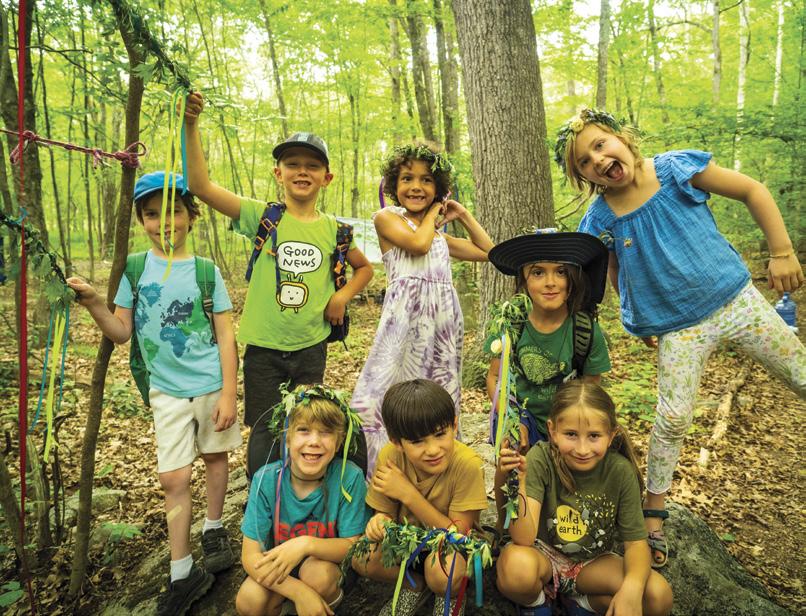
Wild Earth
High Falls (845) 256-9830 Wildearth.org
Join Wild Earth for their Spring Break and Summer Camps! Youth ages 4 to 18 are inspired to play, find community, and connect deeply with nature, discovering the resilience of all living things—especially themselves. This is achieved through activities like exploration, games, and what is referred to as earth-living skills: fire-making, natural crafting, shelter building, tool making/using, and more. With their high staff-to-camper ratio, campers are supported in learning teamwork, expressing gratitude, developing self-agency, and the joy of spending the full days outdoors.

Kildonan’s Camp Dunnabeck
476 Skiff Mountain Road, Kent, CT (845) 373-2002 Dunnabeck.org
This summer, Kildonan’s Camp Dunnabeck celebrates 70 years of empowering children with dyslexia or language-based learning differences. Nestled on the campus of Marvelwood School, this 86-acre mountaintop camp offers a life-changing experience for campers ages 8-16. At its heart is 1-to-1 Orton-Gillingham tutoring, paired with recreational activities that build self-confidence and independence. Campers thrive in a nurturing environment with modern dorms, 24/7 health care, and meals featuring locally sourced ingredients. Offering boarding, day, and half-day options, Camp Dunnabeck balances academics, personal growth, and fun. Join us June 28–August 9 for a transformative summer of learning and adventure!

Zena Recreation Park Summer Camp
Woodstock (845) 679-8098 Zenarec.com
Nestled in the heart of Woodstock, Camp Zena at Zena Rec offers kids in grades K-8 the perfect mix of outdoor adventure and classic summer fun. From June 30th to August 22nd, campers can dive into swimming, perfect their tennis game, and explore the wonders of nature in a warm, welcoming community. Whether they’re splashing in the pool, rallying on the courts, or discovering woodland trails, every day is filled with excitement and friendship. Children will have a summer to remember at Camp Zena—where adventure, learning, and laughter come together under the summer sun!
Adventures
Great Barrington, MA (413) 528-2810 ext 34
Berkshiresouth.org/aadc
From superhero training and galactic adventures to messy science experiments and magical quests, every day is an opportunity to create, play, and make new friends. Campers also enjoy local field trips and BSRCC’s onsite amenities, including playgrounds, fields, trails, and pools. Camp runs from June 23-August 21, for ages 5-14.
Vanaver Caravan
New Paltz (845) 243-4927
Vanavercaravan.org
Experience the joy of dance this summer with The Vanaver Caravan. CaravanKids, for ages 4-8, held July 7-19, and SummerDance for ages 9-18, held July 28-August 8, offer movement, music, and cultural exploration in a supportive community. A hidden gem of the Hudson Valley, these programs nurture creativity, confidence, and a lifelong love of dance.
Song Farm
Kingston (845) 383-1528
Seedsongfarm.org
Give children the gift of summer fun! Kids ages 4-16 connect with nature through farming, caring for animals, art, and outdoor adventures. Campers foster creativity, teamwork, and environmental stewardship in a supportive, hands-on environment. Flexible weekly registration.
Saugerties (845) 246-5006
Middlewayschool.org/summer
Middle Way School Summer of Wonder welcomes children ages 4-11 for outdoor adventures and inward exploration. Five incredible weeks feature splashing in the sun, collaborative games, wilderness skills, arts and crafts, meditation, and more! Each week is infused with the Buddhist-based wisdom of awareness, self-centering, confidence, and community-building.




Esopus (845) 384-6424
Horsesforachange.org
Celebrate the magic that happens when humans and horses connect in a supportive, non-competitive atmosphere. This nonprofit offers summer riding weeks for kids, with riding for all ages and levels and lots of barn fun and horse care. “We emphasize empathy and understanding of our non-verbal, but very communicative companions,” says Director Amanda Haberthier.
Saugerties (845) 246-3744
Woodstockdayschool.org/ summer-adventure

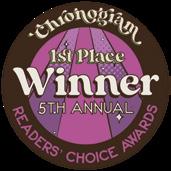

Summer Adventure 2025 is calling! Kids ages 3-11 can enjoy swimming, art, music, drumming, and nature in a full-day program. Specialty camps for ages 5-18 include Animation, Photography, Ceramics, Media Arts, Rock Jam and Theater. Week-long sessions available between June 30 and August 8.
Zena Democratic School
Kingston (347) 770-0420
Curiousjane.fun
For girls who like to make things, look no further! Programming is two weeks only during August 1115 and 18-22. Campers can enjoy project-packed themes like Fab Lab, Room Makeover, Craft Party, Carnival, and Toy Design. Choose a week, choose a theme! For girls entering K-1st, 2nd-3rd, and 4th-6th grades.
Wheelhouse Creative Education Center
Acra (518) 943-4649
Catskillwheelhouse.org
Camp at Wheelhouse Creative Education Center is all about curiosity, creativity, and quirkiness. Days are filled by exploring the land, then transforming these experiences into creative expression through visual art, performance, and conversation. Weekly themes serve as invitations to explore new topics, which evolve in myriad ways through children’s contributions.


High Meadow School
Stone Ridge (845) 687-4855
Highmeadowschool.org
One-week camp programs for ages 3.5-15 on a 10-acre, wooded campus including Wayfinder Experience, Little Animation Studio, Westchester Circus Arts, Mad Science, Robotics, and Culinary Arts, with recreational camps for younger children. Register online for summer 2025! Camps run from June 30 to August 1.
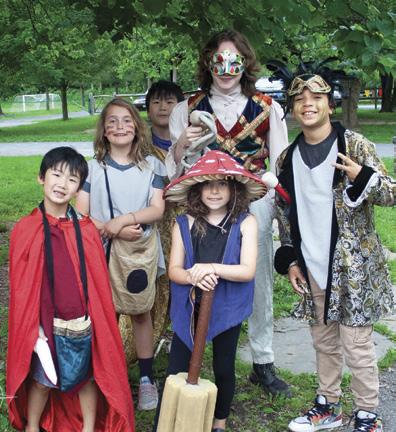
Hudson Valley Writing Project
New Paltz (845) 257-2836
Newpaltz.edu/hvwp
HVWP Young Writers
Programs give children and teens unique opportunities to make new friends, share their ideas, and discover the joy of writing. Experienced teachers create inspiring settings where writers explore many genres and follow their interests–art, nature, fantasy, comics, role play, audio storytelling, and more! Tuition assistance is available.


The Art Effect
Poughkeepsie (845) 471-7477
Thearteffect.org
The Art Effect’s summer art camps and classes allow young artists to explore fine art, digital media art, and performing arts while strengthening their self-confidence, creative thinking, and art-making techniques. Professional artists and experienced teachers lead youth ages 5-19 to imagine, discover, create, and have fun this summer. Register today!

Garrison Art Center
Garrison (845) 424-3960
Garrisonartcenter.org/summer-programs
Ignite creativity this summer at Garrison Art Center! Programs for K–12 students offer hands-on artistic exploration. High schoolers in the Summer Art Institute refine skills, build portfolios, and exhibit professionally. In August, Art a la Carte lets young artists explore diverse art forms in inspiring studios. Create, learn, and grow!
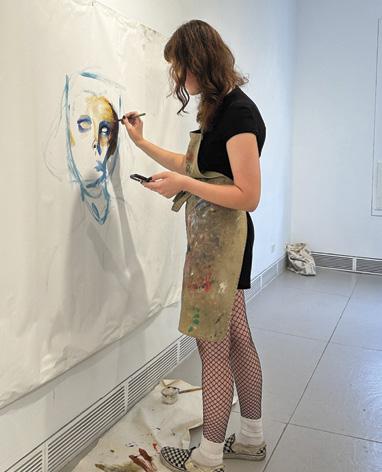



How the Hudson Valley’s strength training community is making fitness more inclusive and personal
By Maggie Baribault

Abarbell slams to the floor, chalk dust lingers in the air, and voices ring out in encouragement. Across the Hudson Valley, strength training is finding its place beyond bodybuilders and competitive powerlifters, drawing in people of all ages and abilities looking to move more freely, feel stronger, and stay healthy.
“There has been a noticeable increase in interest in strength training in the Hudson Valley,” says Mike Romano of Maximum Results Fitness in Kingston. “More people are recognizing the critical role it plays in achieving a healthy lifestyle, improving overall fitness, and reaching their personal goals.”
It isn’t just about building muscle—strength training increases metabolism, supports bone and joint health, prevents injuries, and improves coordination, posture, balance, and mental health. It’s about confidence, longevity, and the camaraderie of training alongside others with similar goals. In small, supportive gyms, coaches tailor programs to fit individual needs, whether that means lifting heavier, staying mobile, or just carrying groceries without pain. Strength, here, is personal—and for everyone.
“We are regular people working out, being sweaty and happy and lifting weights,” says Joanne Maione of the soon-to-open CrossFit Exit 19 in midtown Kingston’s Barrel Factory. “We are moms and dads, postal workers, teachers, counselors, nurses, and chefs. We come in all shapes and sizes and we value our bodies for what they can do.” Strength has many faces here, and the options to develop it are just as varied. For those seeking a more personalized and community-driven experience, independent gyms across the Valley offer specialized strength training environments that prioritize individualized coaching and support. Maximum Results Fitness and Intelligent Action Training in Red Hook provide spaces for serious lifters, whether in powerlifting, Olympic weightlifting, or functional strength development. CrossFit Exit 19 blends strength, conditioning, and agility, while virtual personal coaches like Sydney Nitzkorski and Carlene Remsenburger focus on custom programming tailored to individual needs. Meanwhile, Beacon’s Zoe Alexandra Pilates offers a lower-impact strength training alternative, emphasizing core control, flexibility, and
muscular endurance. Lava Hot Yoga and Fitness, located in Hudson and a newly opened space in Catskill, combines heated yoga and strengthbased movement classes that challenge balance, endurance, and body awareness. Wherever you are in the Hudson Valley, strength training doesn’t have to be a solitary pursuit—it’s a growing movement shaped by communities, coaches, and a shared commitment to building strength.
Strength training isn’t one-size-fits-all. Small gyms across the Hudson Valley are proving that personalized attention and individualized coaching are key to long-term success. “It’s a powerful communal experience, giving everything you have next to someone else,” Maione says. “We root for each other, push each other, and genuinely care. We celebrate accomplishments and support each other through life’s challenges.” These spaces and people are reshaping fitness culture in the Hudson Valley, fostering a supportive and empowering environment where strength is built—physically and emotionally.
“No two people are the same, nor should their programming be,” says John Morgan, a

bodybuilder and owner of Intelligent Action Training. “There are so many one-size-fitsall programs out there, but none of them take into account age, gender, medical history, range of motion issues, athletic ability, and exercise history. Sustainable program development starts with a conversation, followed by an assessment, and finally, a customized plan designed for the individual sitting in front of me.”
Morgan, who opened his gym in 2017, has seen a rise in independent gyms across the Hudson Valley. “A small fitness business will give you better instruction, care, and attention than a large box gym. The owners are usually providing the service out of passion for the profession. If you are new to fitness and want a welcoming experience, shop small.”
A structured, expert-guided approach can mean the difference between progress and plateau. A skilled trainer doesn’t just hand over a workout plan—they provide accountability, education, and real-time adjustments tailored to the individual. “Working with a coach is invaluable for those new to strength training because it accelerates
progress while ensuring safety and consistency,” Romano says.
“A coach can teach you proper form, correct breathing patterns, how to brace your body against a load, and how to safely handle heavier weights,” adds Sarah Dukler, a powerlifting coach in Kingston and 261 Fearless Club director for Greater New York. “They will meet you where you are, help you build confidence, and show you that you’re more capable than you think.”
Different training styles cater to different needs, and “the type of training you focus on should be linked to your goals,” says Nitzkorski, a registered dietitian and online personal trainer. “It’s crucial to take an individualized approach.”
Functional strength training, like CrossFit, enhances practical strength and endurance by focusing on compound movements that engage many muscle groups at once. Powerlifting, with its focus on heavy compound lifts, is ideal for those who want to build raw strength and muscle density. Olympic weightlifting emphasizes explosive power and technical skill, while bodybuilding targets aesthetics and muscle
definition. Each style varies considerably in its focus, end goals, and training approach.
“Determining the best training approach starts with a thorough assessment,” Romano says. “This includes evaluating their current fitness level, age, training history, injury history, lifestyle factors, such as their work schedule, stress levels, sleep and daily activities, and their specific goals. A well-structured program isn’t one-size-fits-all.”
Strength training isn’t just about aesthetics—it’s about functionality and overall well-being. The ability to move through life with strength and ease can be life-changing. Rachel Handler, an actor and writer in Dutchess County, discovered this firsthand. After an infection in her leg led to surgery, she turned to strength training as part of her recovery. “For so long, I thought of working out as a punishment for eating, and something you only do to get skinny, but strength training shifted my perspective entirely,” Handler says. “Working out now is a way to get strong and stay healthy. Strength training is something I look forward to— it gives me confidence in myself and my body.”

For others, strength training offers relief from chronic pain and a renewed sense of independence. Pilates instructor Zoe Thomas, who began practicing to manage her scoliosis, believes in the power of detailed, core-focused training that integrates resistance training, proprioceptive exercises to enhance body awareness and improve coordination, yoga, and fascial release work. “Pilates is accessible for all conditions and fitness levels,” she says. “Even with major injuries, there is work that can be done to keep you active. My goal is that our Hudson Valley community starts to understand the importance of preventative care— take care of your body before it breaks down. Everything is connected.”
For those navigating trauma, strength training— especially powerlifting—can be a reclamation of power. “Folks who deal with trauma often feel disconnected from their bodies, says Remsenburger, a trauma-informed powerlifting
coach. “Through modalities like powerlifting, we find ways to reconnect and listen to our bodies.” The slow, deliberate act of lifting— feeling strength build rep by rep—can become a grounding tool, a way to regain control.
Remsenburger believes traditional fitness spaces often reinforce disconnection. “The way our culture presents movement, fitness, and gym spaces to us is generally centered around Western, white, heteronormative, and cis-gendered ideas,” she says. “It’s my job to question those ideas and create a space for anyone who doesn’t fit into those categories.” In her coaching, there are no weigh-ins, no body measurements, no pushing until failure. “Some of the best powerlifters in the world don’t look ‘conventionally’ strong,” she says. “Your shape or size does not inhibit you from achieving your goals.” But perhaps the greatest impact of strength training is on confidence. “Powerlifting gives people the opportunity to prove they can do more than they believe,” Remsenburger says. “Accomplishing small feats—a personal record, one more push-up—translates into daily life. If
we can deadlift something we never thought we could, who’s to say we can’t try something else we never thought possible?”
Ultimately, strength training goes beyond building muscle. “Strength training has never been about physical benefit alone,” Morgan says. “It translates into being a better partner, parent, provider, and role model. Give yourself a fighting chance to live a full, capable, and able-bodied life. It is never too late to start. Being strong means a better life.”
Strength training offers something for everyone—it’s about movement, longevity, and resilience. “Training enhances your quality of life, confidence, and mental health,” Morgan adds. “The ability to move through life with ease, limited pain, and mobility at any age is priceless.”
“Everyone starts somewhere,” Romano says. “The gym is a place for progress, not perfection. Confidence comes with consistency, so start small, stay patient, and celebrate every bit of progress along the way.”



























By Anne Pyburn Craig
Photos by David McIntyre
Last August, as Saugerties celebrated the 30th anniversary of Woodstock ’94, three longtime locals were presenting the town board with a draft generic environmental impact statement, predicting that their multi-use plan for the festival’s site, Winston Farms, could generate $62 million in annual economic impact. This plan, which includes housing, a 5,000-seat arts center, a boutique hotel, a campground, and light manufacturing, is scaled back considerably from one rejected by the town in 2022 and attempts to mitigate impact with larger buffer zones and smaller footprints. The town board, to the relief of some and the chagrin of others, was not quite convinced.
“The board deemed the initial submission incomplete, which is not extraordinary for something of that scale,” says supervisor Fred Costello. “We sent it back to the developers, they’re collecting further data, and we expect them to come back before us shortly. If we’re advised that the amended document is complete, we’ll accept it, and that will become the foundation for a zoning change moving forward.”
Opposite


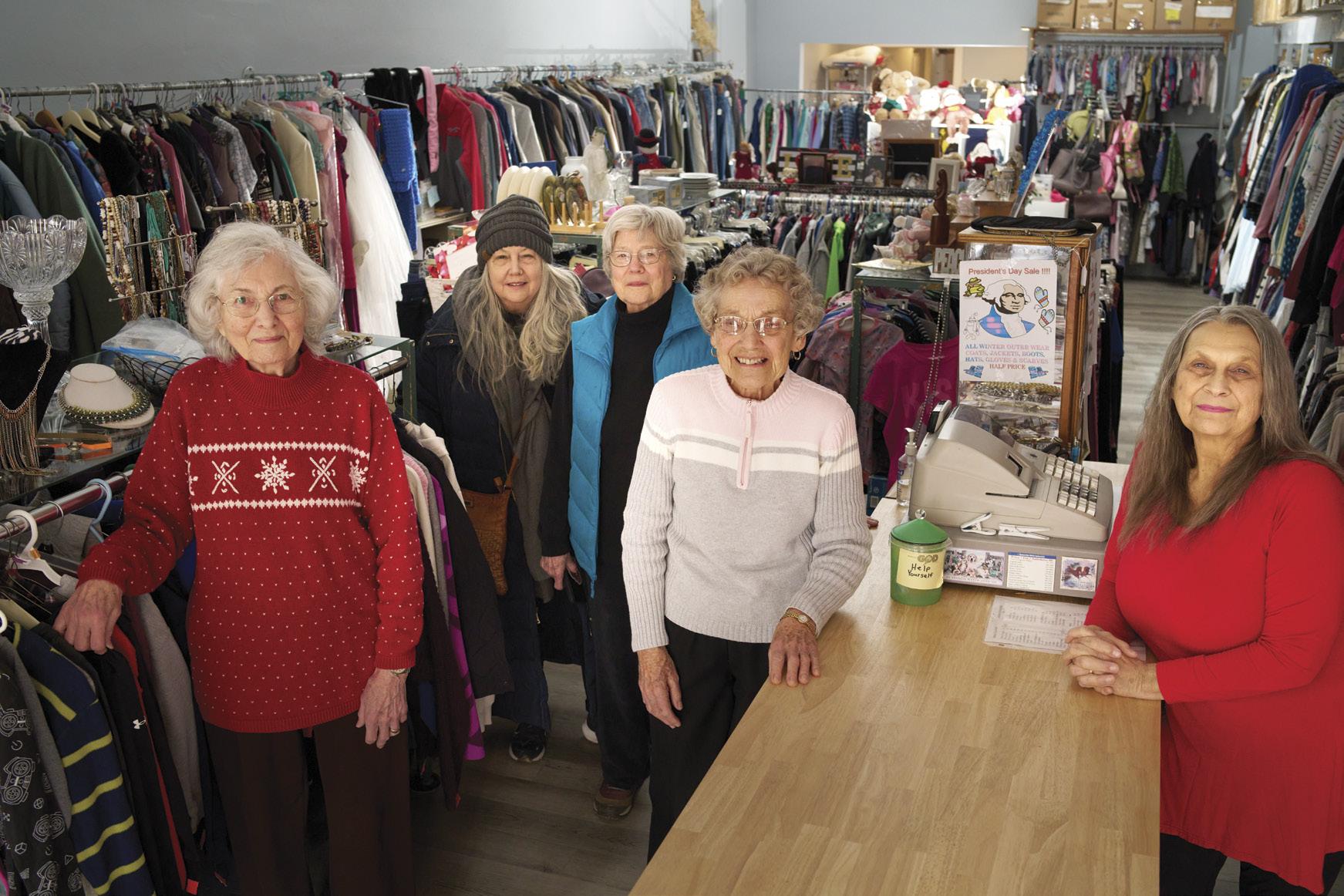
The proposal requires the creation of a Planned Development District, and Costello says that would be an improvement over the current situation. “The current zoning would allow a very dense, 1960s-style subdivision. We all agree, including the developers, that that does not represent the highest and best use. A zoning change that would meet the goals of our comprehensive plan is the goal, and I’m optimistic that we can get there.”
Should the zoning change happen, specific site uses would still need to be signed off on by the planning board. Opponents, organized under the banner Citizens for a Beautiful Saugerties, advocate for “the lightest possible footprint and the greenest available technology,” as several members wrote in a joint letter to the media last November, calling the scaled-down proposal “massive overdevelopment.”
Nevertheless, Costello believes resolution is not just possible but probable. “I think the folks that have spent a fair amount of time defending that property understand that the current zoning is not in our community’s best interests, and in that vein, they are giving this process a chance,” he says. “If the process does not yield an improved project, I’m sure we will hear from them.”
Andy Cowan, a cofounder of Beautiful Saugerties who’s no longer affiliated with the group, says he has come to accept that the site won’t stay forever wild, and the town board, he believes, is “doing their due diligence.” Still, he fears outside interests could gain too much control. “The
zoning change would allow a wide variety of development to happen, and we don’t know who they’re going to bring in to do that,” he says. “If it were local people doing the actual building, I think everybody would probably feel more confident, if the zoning could somehow be written to protect the wetlands and aquifers and include senior and affordable housing, that would help. It could be a great opportunity. All I’m hoping and asking for is that it be shaped into something that’s reflective of the community, the geography, the culture, the long term, and the lovely heart of this place.”
In the heart of the village, at the Orpheum Theatre, Saugerties residents have been gathering monthly to consider wider questions about the town’s prospects. Calling their effort Balanced Growth, they’re exploring possibilities for the local retail economy, housing issues, public transportation, and pedestrian safety (21-year-old Starllie Swonyoung was killed in a hit-and-run last January) through a lens of creative placemaking.
“Town and village board meetings aren’t really set up for the kind of active conversation we believe is needed, especially now that our weekly newspaper [the Saugerties Times] is gone,” says Suzanne Bennett, a cofounder of roving arts group Shout Out Saugerties. “We’re focused mainly on the village and the area near it, Barclay Heights. What are our assets, and how do we build on them? We’re inviting







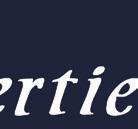








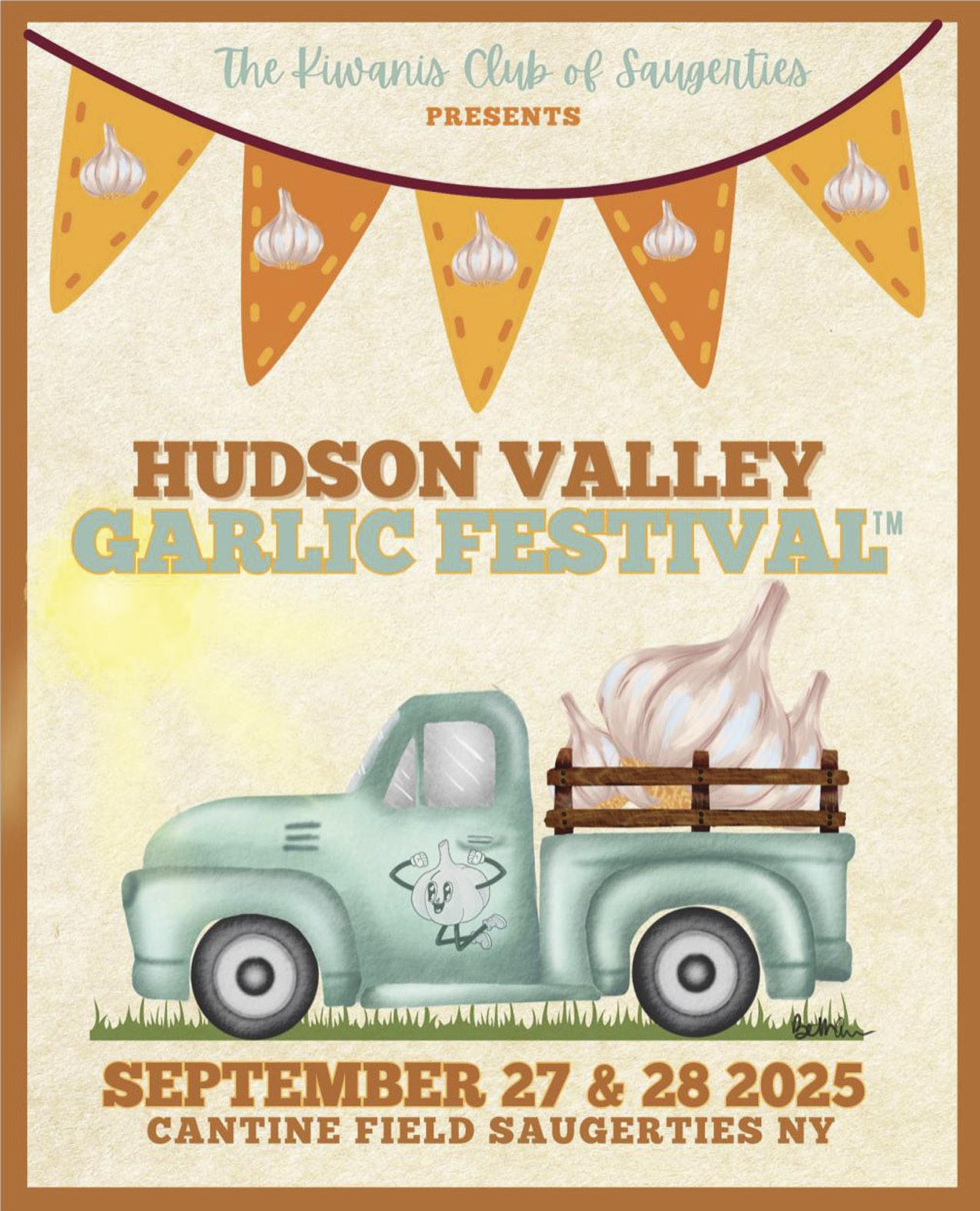










Come check out the Kiwanis Ice Arena’s hybrid and energy efficient facility that is family-friendly, for all ages, for all levels of skating. One of the top ice skating rinks according to I Love NY. From Learn-to-Skate Clinics to our Skating School to Youth & Adult Hockey Leagues, our dedicated and talented team of instructors & coaches are ready to assist all ages & abilities. General public ice-skating sessions run daily for one-&-half hours each. Now offering cosmic skate sessions. No skates? No problem. We offer skate rentals, along with helmets, sticks & training aides. Hope to see you soon!
ICE ARENA

































placemaking experts and activists, and we’ve had two meetings so far, and people want to keep talking—they have to gently kick us out of the theater.”
One topic that came up at the group’s February meeting was the shared desire for more gathering spaces. This would seem to be borne out by the success of the Local, a cultural venue in an 1800s Dutch chapel that’s been presenting world music and more to capacity crowds since 2023, but citizens would like to see more spots, indoors and out, where they can meet for the spontaneous interactions so important to village-building.
There are a dozen empty storefronts in the village right now, and Balanced Growth advocates would like to see new occupants set up for success. “We have new, young business owners who are very invested, as stakeholders, in the conversation about downtown,” says Bennett. “And many of the property owners are willing to work with prospective tenants on rent and perks, but the places stay vacant. Part of it is analyzing what will work here; if you want to come in and open, say, a specialty shop that sells nothing but hats and scarves, you might do okay in summer when foot traffic’s high, but is that going to be sustainable in the long run?
We want to avoid people coming in, putting their energy into something that fails, and having to close.” There may be an opportunity for the right health food store; a branch of Mother Earth’s Storehouse closed not long ago. Bennett has convinced the owner of the Speedy Mart on Main Street to bring in some healthy local products, but doesn’t expect he’ll be ripping out the beer cooler to replace it with bulk granola anytime soon. Books, antiques, and galleries continue to thrive, as does a relatively new Korean market, Enoki, on Main Street.
One business that opened with high hopes yet failed to get a foothold was Upriver Studios, a 101,000-square-foot film production space opened by Mary Stuart Masterson that was hit in rapid succession by pandemic lockdowns and industry strikes. Masterson told the Albany Times-Union in September that she still holds high hopes for the region’s film industry, but that it had been the wrong moment; out of 48 months, there were 27 when work was impossible.
The Orpheum Theater, purchased by Upstate Films in 2021, has added a state-of-the-art screening room with Dolby Atmos sound. Blue Velvet and March of the Penguins are just two of this month’s coming attractions.



Out on Route 212, White Feather Farm has been up and running since 2020, maintaining a 66-acre spread that hosts around 2,000 visitors each season for its flagship events, Maple Fest (coming March 8 this year and featuring a Native storyteller), a May celebration welcoming the community back to its farm market with tours and music, and Soil Fest every July, which celebrates the farm’s research projects. “Our vision is to be an active resource for people,” says the farm’s executive director Marcos Stafne. “And our space is really gorgeous and just a really comfortable, safe place to come and experience and think about these topics.” White Feather hosts workshops, plant walks, performances in the renovated 18th-century Dutch barn, and a farmstand with very reasonable prices. “We take SNAP and EBT, and you can get great organic food here,” says farm manager and creative director Celia Brubaker. “We have a monthly early childhood program for families, a lot of hands-on regenerative growing programs for backyard gardeners, and we’re just starting to make the barn available for events. We had our first wedding in January, and it was lovely.”
At Mountaintop School up on Band Camp Road, founder Wendy Weinrich has been raising her own crops of sprouts, offering Waldorf preschool education. Founded 18 years ago in a farmhouse with 12 families, the school now serves 45 families and employs 12 teachers. “I think we’ve gotten a very good reputation for treating children with care, reverence, and love,” says Weinrich. “And we work closely with our families, helping them navigate all that comes with having young children. A community helps.”
Weinrich’s grandchildren are in Minnesota; she’s looking to retire and get some more time with them, and has a succession plan in place for Mountaintop. “One of my teachers is stepping up, and she has a daughter who teaches here too, so I foresee Mountaintop being here for a long time,” she says. “We’re a state-licensed daycare, and Ulster County is considered a childcare desert, so being able to offer quality care to as many families as we can fit in is very important.”
Cowan, a musician and consultant who moved here in 2014, says that no matter the outcome of any given controversy, he’s thrilled to be a Saugertesian. “There’s an openness, friendliness, and connectedness here that we’ve never had before, when we lived in bedroom communities and people didn’t know their neighbors. So that’s been such a huge change for the better. I love the interconnectedness. I love that I can call Fred Costello and get a call back.”
“It’s impossible to capture the emotions of 19,500 people on any given issue,” says Costello. “But I think we have the tension set right between community goals and aspirations and the art of the possible, and that’ll set our compass in the right direction.”
azz
Jazz • Blues Rock

Indie
• Gnaw
• Amer Indie
Sacred Chan Bugaloo • P Gypsy
Sacred Bugaloo P Gypsy
Music
Jazz
• Zydeco icana a Funk ts op + , azil, a, India +
Ireland, Armenia, Br Africa, Kore workshops &
Music from Ireland, Tuva Armenia, Br Africa, Kore workshops & more

















by David McIntyre

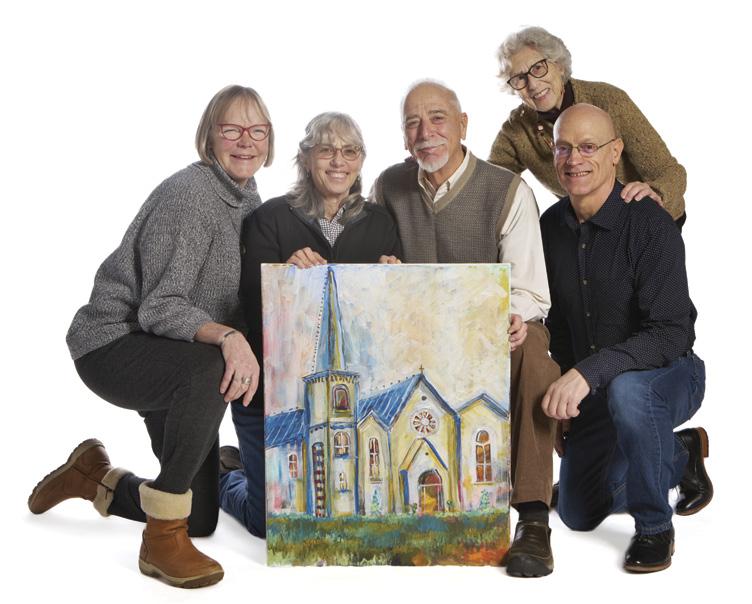
We set up in the former Dutch Reformed Church chapel that now houses performance space the Local for our Saugerties portrait shoot on Super Bowl Sunday. Thanks to Isabel Soffer and the Local for hosting us. And big love to the residents of Saugerties who dug out of the snowstorm to represent their town.

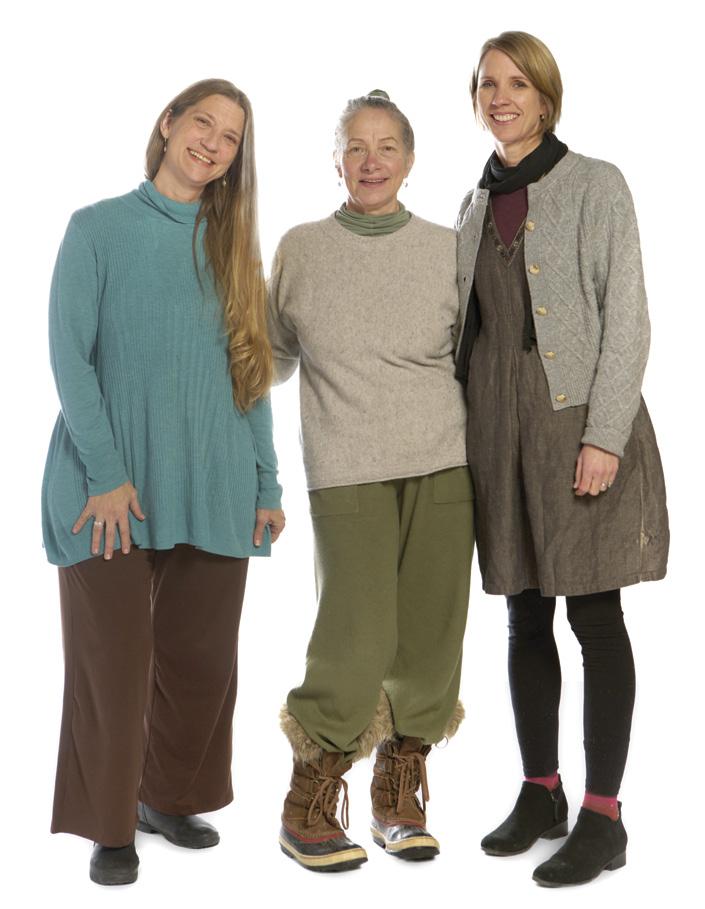
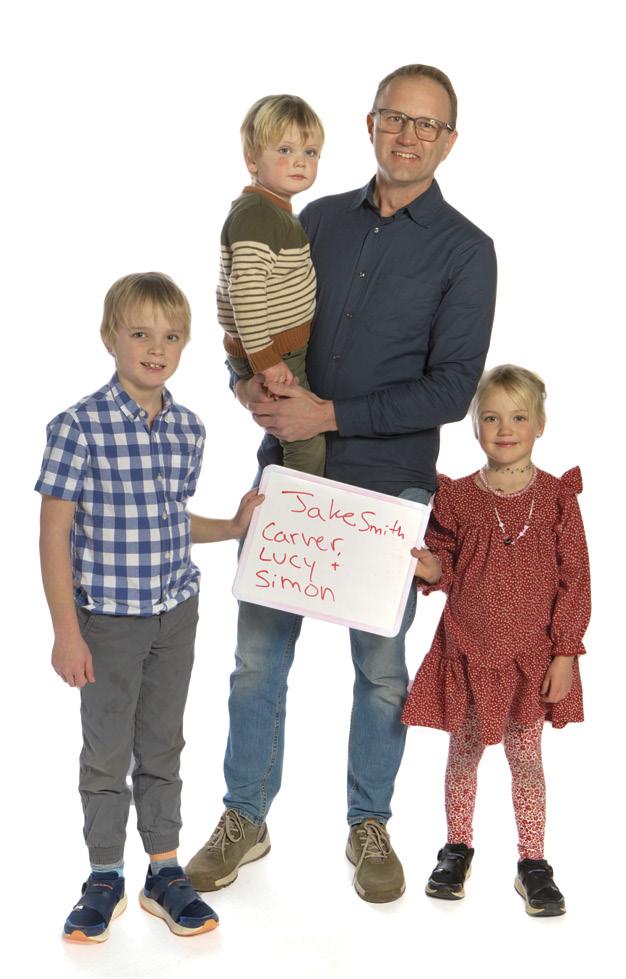




Join us for the March issue launch party on Wednesday, March 5, from 5:30-7:30pm at AutoCamp Catskills at 882 Route 212 in Saugerties.
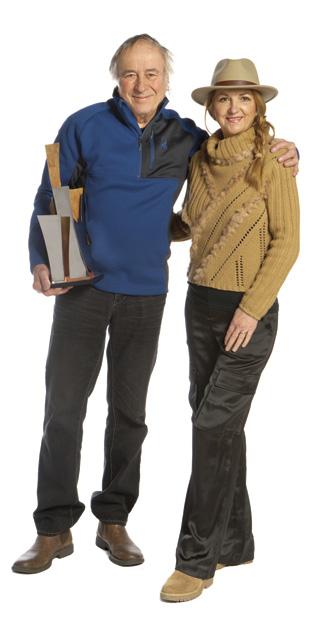
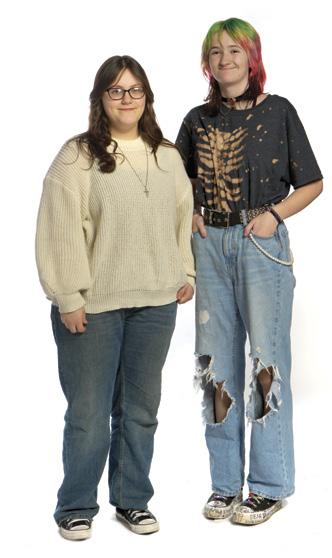






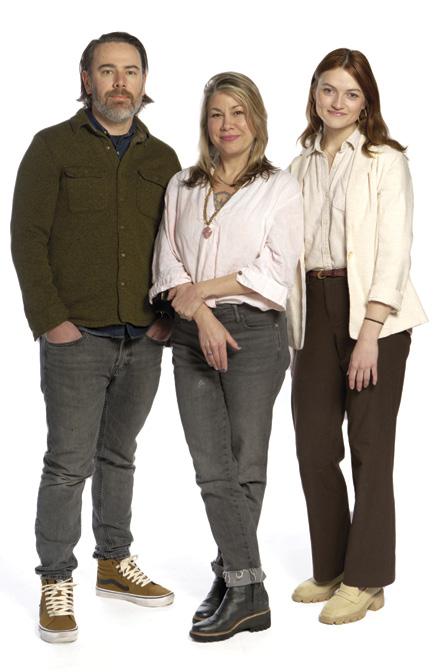






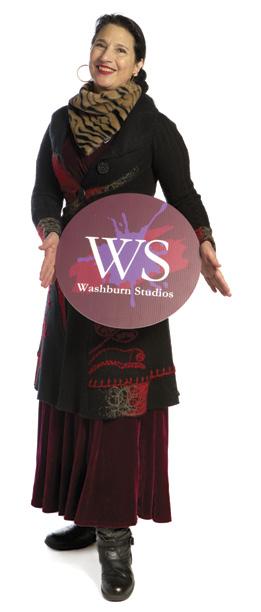







Top row: Farzan Nadim, college professor, NJIT and Isabel Soffer, The Local; Phyllis Clark and Gerri Ryan, cofounders Saugerties Sings; Jennifer Ayala, singersongwriter, astrologer, intuitive guide, James K. Yang, Bear and Meeka; Jay B. Ballesteros, photographer and graphic designer, Jay B Photography and Kate Murray, owner Quick Brown Fox Letterpress; Jennifer Mangione, licensed real estate broker and owner of Grist Mill Real Estate, Henry Mangione, Frank J. Mangione Inc.

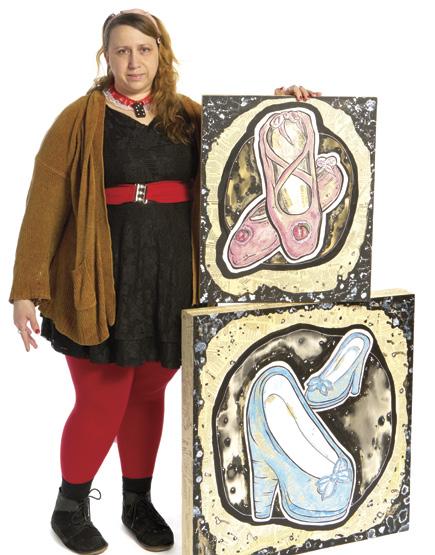
Middle row: Jennifer Tsakis, owner of Pop Vintage Antiques; Balanced Growth Saugerties: Katie Cokinos, senior programmer and outreach at Upstate Films and ShoutOut Saugerties, Suzanne Bennett, executive director ShoutOut Saugerties, Stephanie Bassler, Architect and certified Passive House consultant; Kevin Anthony, Ulster County Rotary, Ulster County Regional Chamber of Commerce ambassador; Lisa Bruno, semi-retired; William Greenwood, Greenwood Designs, jewelry design and manufacturing; Carolyn Marosy, musician.
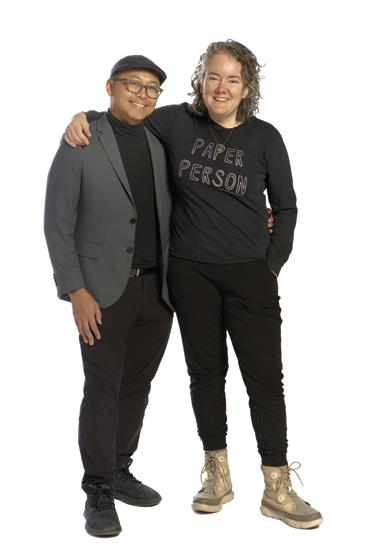





Botton row: Michael Doyle and Kirsten Doyle, artists; Kristen Thorne, writer/ photographer and operations specialist; Sui Jenneris, visual artist; John T. Beckert, volunteer fireman, lifelong Saugerties resident; Mark Smith, chair, Saugerties Chamber of Commerce, Peggy Schwartz, vice-chair, Saugerties Chamber of Commerce, owner of Town and Country Liquors.
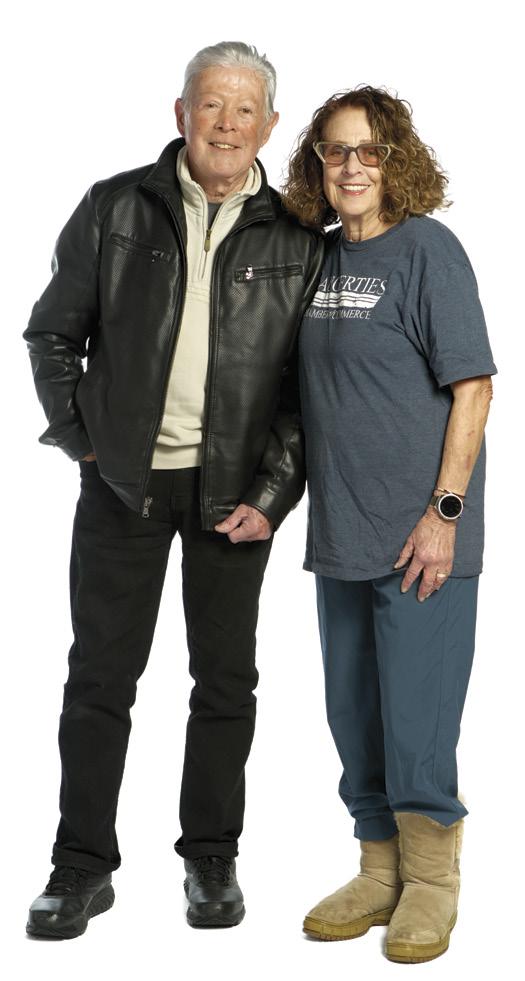
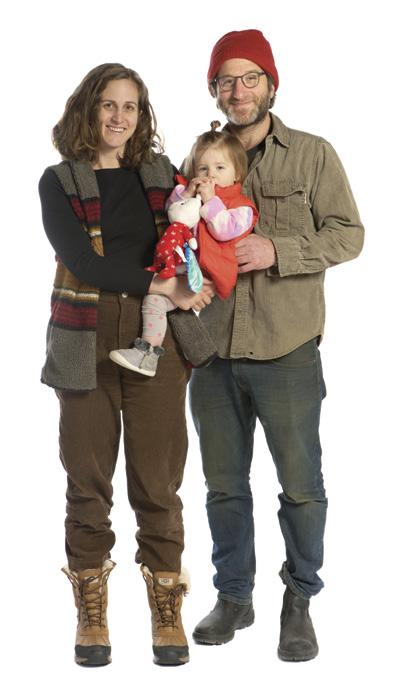


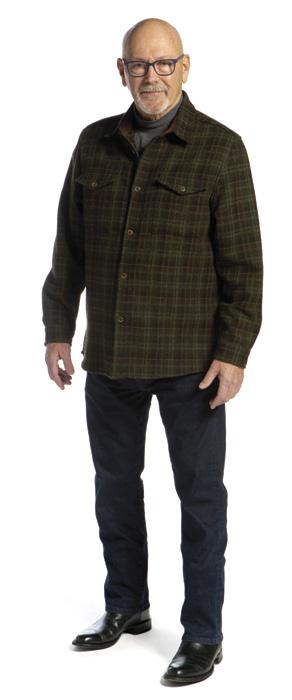

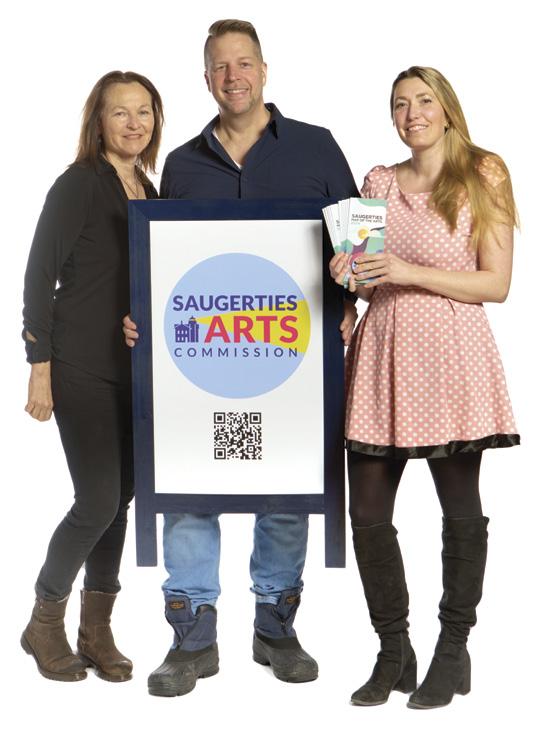
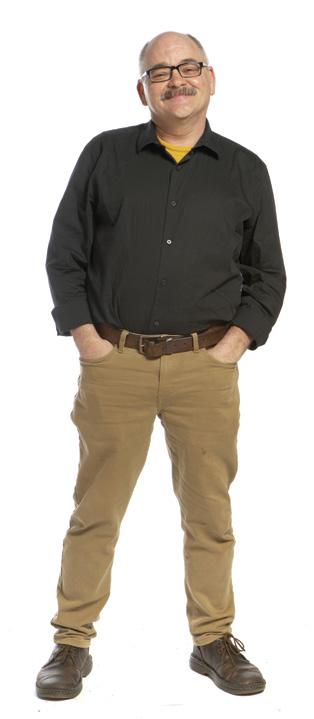



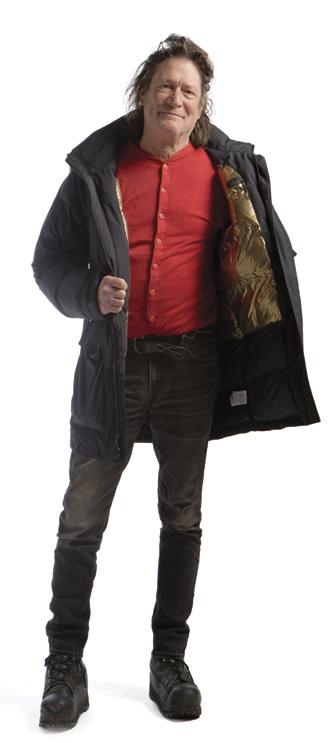

Top row: Leah Feder, audio journalist and Mark Stern, professor, Colgate University with Orly Stern; Michael Flanigan, retired business owner, retired police officer; Justine Snihur, Saugerties Ballet Center owner, with John Snihur, Danyelle Bagnall, Sawyer Bagnall, Reagan Bagnall; Michael Wardell, Wardell Pottery and Metalwork, Lorrie Wardell.
Middle row: Sae Hoon Sohn, retired and Molly Mackaman, artist; Lisa Nicholas, Andrew Rein, and Nina Schmidbaur of the Saugerties Arts Commission; Ze’ev Willy Neumann, artist with Primo Neumann and Lola Neumann; Patrick Hammer, Jr., cofounder of the Blue Stone Poets.
Bottom row: Michael Cronin, cook; Robert Langdon, cofounder of the Blue Stone Poets and program director at Woodstock Byrdcliffe Guild; Emily Li Mandri, MLE, Will Nainis of Sundae Projects, Sophie the poodle; Robert George, sculptor/fixer.
Across its nearly 500 square miles, Westchester County is a hub for creatives and arts aficionados. With its abundance of museums, theaters, cultural festivals, and performance spaces held in historic locations, the 19-town county’s artistic allure enriches the experiences of passers-through.

149 Girdle Ridge Road, Katonah (914) 232-1252 Caramoor.org
Caramoor Center for Music and the Arts in Katonah is the destination for music and art exhibited on its five distinct stages, lush gardens, and wide-open fields. The 80th Summer Season features a wide range of world class musical performances. Genres include Orchestral, Chamber Music, Jazz, American Roots, Opera, Broadway, Global Music, and Dance. Audiences are invited to come early to explore the expansive grounds, experience the outdoor Sonic Innovations sound art installations, tour the historic Rosen House, and enjoy a pre-concert picnic. The full schedule for the Summer Season will be announced on March 11.
KinoSaito
115 7th Street, Verplanck (914)293-7468 Kinosaito.org
KinoSaito, a nonprofit art center located in Verplanck, reopens March 8th with solo shows by painter Kikuo Saito, sculptor Reuven Israel, and an immersive sound installation by Bruce Odland and Soli Pierce, in addition to an outdoor installation by Alice Mizrachi. Open Friday–Sunday, free admission.

2467 Quaker Church Road, Yorktown (914) 844-8540
Thecapaspace.org
The Capa Space is an education and exhibition center created to foster the belief that documentary photography can inspire the community to advance concepts of peace, equality and justice.

Faces of Exodus: Photographs by John Moore through March 23rd. Witness: Gerda Taro’s Spanish Civil War opening April 5th.

ArtsWestchester Gallery
31 Mamaroneck Avenue, White Plains Artsw.org
For more than 60 years, ArtsWestchester has been enriching the greater Westchester County region with music and art. Through education, public programming, and a calendar of exhibitions, the gallery and arts council has created a rich creative community for all to experience.
ArtsWestchester’s historic building features a two-story art gallery in downtown White Plains. The gallery hosts rotating art exhibitions and intimate music events throughout the year, and is open five days a week. Housed in a renovated bank building, the 4,800-square-foot space is a portal into the realm of contemporary art featuring Hudson Valley artists.
On view this spring through April 13, 2025, a group show entitled “The Arts Exchange | Open Call 2025”, features the work of 46 local artists. As observers of time and place, participating artists created works responding to the challenges and triumphs of the moment, illuminating complex issues, and inspiring dialogue around local and global events.
“Legendary Looks” opens May 31 through July 20, 2025, an exhibition that explores the art of effects and costume design in New York’s Black and Latinx LGBTQIA+ house and ballroom communities.
Beyond exhibitions, ArtsWestchester offers numerous educational programs, including workshops, lectures, and artist residencies. These initiatives bring art into local schools, community centers, and public spaces, ensuring accessibility to creative experiences for people of all ages.
To support the transformative power of more creativity in communities and for upcoming exhibitions, visit ArtsWestchester’s website.


By Jamie Larson
On January 27, the Trump administration issued a memorandum that temporarily froze all federal grant spending. Though the plan has been paused for now through legislative and legal injunctions, the move signals Washington’s intent to significantly reduce aid programs moving forward. The situation has cast a shadow over Hudson Valley and Berkshires cultural institutions and nonprofits, many of which rely on national grants.
A high-ranking regional education official, speaking on condition of anonymity, expressed concern. “This wasn’t just an oversight or an ill-formed policy,” they say. “The initial freeze was a stress test—to see where the opposition would come from and how the legal arguments would be structured. Now that they’ve seen the reaction, they can come back and target institutions more surgically.”
The official emphasized they are worried not just for the education system but for the fundamental structure of regional life. “The economy of this entire region depends on federally supported institutions. If this funding is permanently cut, it’s not just programs that
disappear—it’s jobs, it’s economic stability, it’s the future of these communities.”
Liana Toscanini, founder and executive director of the Nonprofit Center of the Berkshires (which provides resources, programming and technical assistance to local nonprofits) acknowledged that organizations are going to have to adapt and highlighted the importance of not relying on just one funding stream during uncertainty. “While this doesn’t work for everyone, revenue diversification is very helpful in times like this,” she says. “I’ve lived through multiple economic downturns, the crash of 2008, Covid, and who knows what going forward.”
The region receives substantial federal grant support across many sectors—from agriculture and community services to education and the arts. While not all grants are major sums, they diffuse across the community. In 2024, for example, the Berkshire Taconic Community Foundation awarded over $1.09 million in federal CARES Act funding to 10 Berkshire County nonprofits to enhance food security. These Community Development Block Grants
were allocated to organizations serving lowand moderate-income individuals. The South Community Food Pantry in Pittsfield was awarded two federal grants totaling $15,562, enhancing its capacity.
Toscanini stressed that organizations fortunate enough to receive strong community support through donations should prioritize maintaining communication with those funders. However, Toscanini reports that her organization has recently heard from historically reliable local donors who are concerned that they will not be able to shoulder the number of new requests coming their way
Toscanini added that the Nonprofit Center will continue to support the sector through networking, workshops, and other programs. “We are currently sharing information about webinars targeting advocacy, and understanding the new executive orders,” she says. “Our state association, the MA Nonprofit Network, is on top of all the policy issues, and the National Council of Nonprofits is another great source of information. It’s also important to uplift folks during trying times.”
Pete Lopez, Scenic Hudson director for policy, advocacy and science, says federal funding impacts both environmental and public health. “A reduction or freezing of funding would impact environmental and public health in the same breath,” says Lopez, who served as a Republican member of the New York State Assembly for over a decade before joining Scenic Hudson three years ago.
Lopez also cautioned that environmental cleanup efforts, such as PCB removal from the Hudson River, could be significantly delayed if federal agencies face staff and resource reductions. “If enforcement resources are curtailed, it’s more challenging to secure compliance and drive consent orders. That would have a material impact on the environment,” he says.
While Lopez acknowledged potential challenges ahead, pulling from his extensive experience in Albany, he pointed to broader political dynamics that might mitigate the impact of cuts. He explained that funding decisions are often moderated by bureaucratic inertia and public backlash. “With the executive branch—there’s power, but the challenge is, what does that look like once it’s immersed into a broader system that inherently has a number of checks and balances?” He added that while federal cuts may be directed at the national level, local and state politicians often bear the brunt of public frustration when popular and essential programs face financial shortfalls.
“This is where things get complicated,” Lopez continues. “If you’re a member of Congress in a district where your margins are thin, and you see a wave of public concern coming at you, you may be more attentive to determining where you go with that information and how it bears on your decision-making.”
In the Berkshires, a long-envisioned project, the Adventure to Ashuwillticook Trail (A2A) trail, received $17 million in federal funding on January 10, just days before the initial funding freeze.
Laura Brennan, assistant director of the Berkshire Regional Planning Commission (BRPC), remains hopeful the project won’t be defunded. “This is an example of regional thinking and how it can really be worth it,” says Brennan.
BRPC is slated to coordinate and manage the funding received from a US Department of Transportation program, which the Trump administration recently rebranded from the Rebuilding American Infrastructure with Sustainability and Equity (RAISE) program to the Better Utilizing Investments to Leverage Development (BUILD) program. This change offers a glimmer of hope to Brennan.
“That name change is, to me, a positive sign the program will continue,” she says, figuring why bother renaming something if you’re just going to eliminate it. “This particular funding has been around for a long time, and we have no indication that this grant will go away.”
With the future uncertain, institutions are scrambling to prepare. Nonprofits are seeking private donors; schools are considering tuition hikes or program cuts; community leaders are urging grassroots efforts to fill the gaps left by federal cuts.
Lopez underscores the importance of continued advocacy and engagement with decision-makers. “We’re staying close to our colleagues, keeping an ear to the ground, and making sure we’re in communication with key stakeholders. We can’t control the broader shifts in policy, but we can continue advocating for technical assistance, funding, and enforcement resources.”
In the meantime, public institutions are left waiting, uncertain whether the funds they’ve relied on will still be there tomorrow. While the initial freeze may have been lifted, it has already sent a message: In the Hudson Valley and the Berkshires, federal support can no longer be taken for granted.



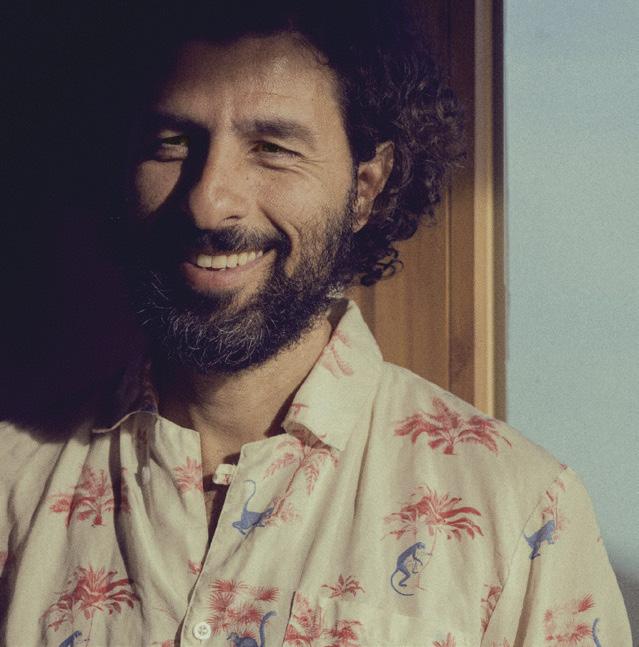




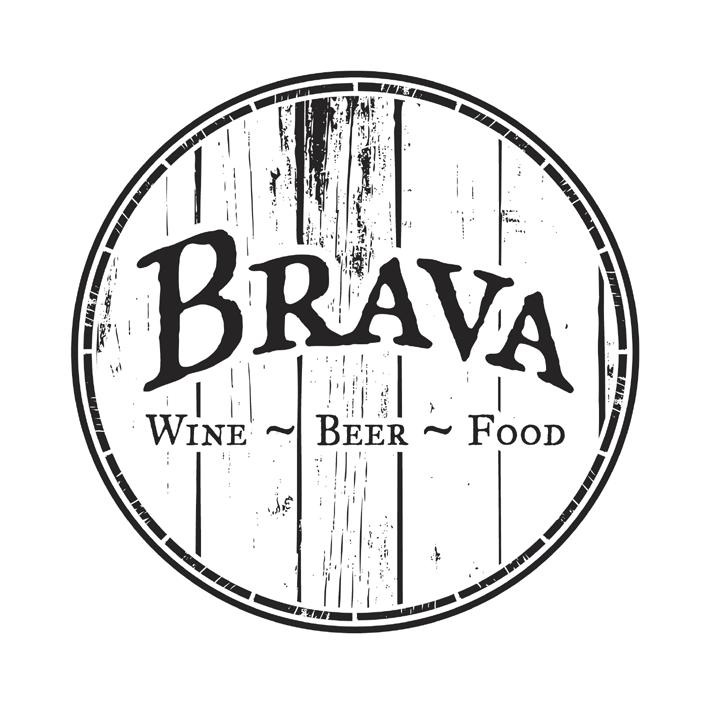
Tapas & Pizza Award Winning Wine List
65 Church Street
Lenox, MA 01240
413-637-9171
Tapas & Pizza Award Winning Wine List 65 Church Street Lenox, MA 01240 413-637-9171
www.bravalenox.com
www.bravalenox.com


(Valley Entertainment, Inc.)
Proto-punk legends the Dictators are justifiably viewed as one of the great New York City bands, but their roots are actually in the Hudson Valley. Bassist/vocalist Andy “Adny” Shernoff and lead guitarist Ross “the Boss” Friedman formed the band in 1972 while Shernoff was attending SUNY New Paltz, and their initial woodshedding with original rhythm guitarist Scott “Top Ten” Kempner took place in a rented house in Kerhonkson. With Shernoff now a Mount Tremper resident, the band has returned to their local roots—but their first studio album since 2001’s D.F.F.D. brims with just as much ballbusting Big Apple bravado as ever.
Now down to two original members (Shernoff and Friedman) plus Blue Oyster Cult drummer Albert Bouchard and guitarist/vocalist Keith Roth, the Dictators nonetheless come roaring out of the gate with the exuberant “Let’s Get the Band Back Together,” which happily demonstrates that Shernoff’s wiseass humor and Friedman’s dead-serious leads are both still razor sharp. “God Damn New York,” a love/hate letter to Fun City, is likewise cut from classic Dictators cloth, as is the raucous kiss-off “Thank You and Have a Nice Day.” Other standouts include “Sweet Joey,” a heartfelt tribute to their old Bowery running buddy Joey Ramone, and the ripping cover of “Transmaniacon MC” is a nice nod to the long-running brotherhood between the Dictators and BOC. But the whole thing is “Really Good” (to quote another of the album’s song titles) and should definitely delight any diehard Dictators fan—not to mention anyone else who could do with a dose of classic Noo Yawk rawk ’n’ roll.
—Dan Epstein
Amy Helm Silver City (Sun Record Company)
Amy Helm’s fourth solo album is her most intimate and personal to date, as well as being a long-overdue showcase for her dynamic, soulful vocals. Much ink has been spilled about Helm’s father’s influence on her, but on Silver City one can especially hear the influence of her mother, the unheralded 1970s folk-pop singer-songwriter and Woodstock native Libby Titus. That being said, references to “rock of ages” and “my father’s voice” remind one of her lineage as the daughter of the late, great drummer-singer Levon Helm of The Band. (The effort was recorded at the Woodstock studio bearing his name.) Helm views the 10 songs she wrote or cowrote here as letters to real and imagined women—an abused teen mother (based on the plight of her great-grandmother), a struggling single parent, a woman managing post-divorce grief. Producer Josh Kaufman sets these “letter-songs” in sparse, delicate arrangements that support Helm’s dazzling, sinuous vocals.
Seth Rogovoy
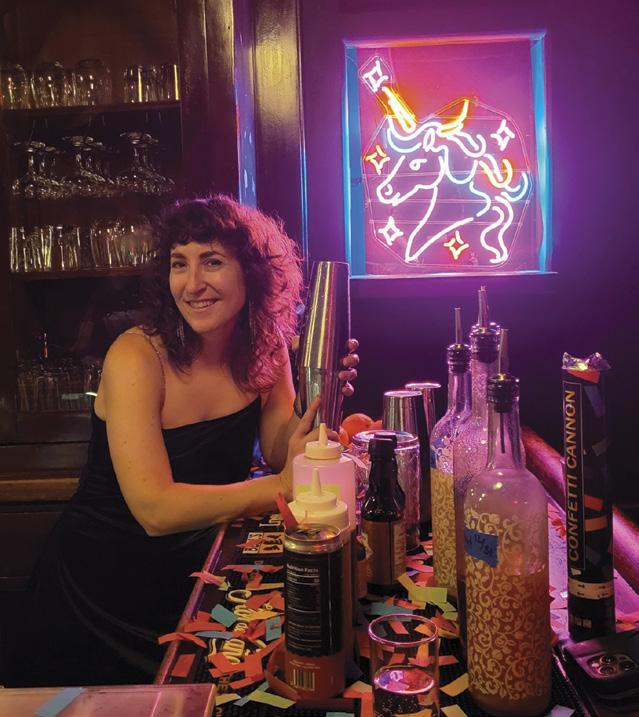

Strum and Drone (Oystertones Records)
A few months ago, I went to see Nine Inch Nails guitarist Alessandro Cortini perform an improvised concert of electronic music at the Egg in Albany. Videos were projected, but the artist was left mostly in the dark. In nearly 50 years of concert going, it was the first time I felt completely comfortable closing my eyes while someone worked onstage. I feel the same way with Strum and Drone, a massive, two-disc effort from Double Celled Organism, the Hudson Valley duo of Bill Brovold and Richard Carr. I feel more in service to the music shutting off my other senses and diving deep into the ambience of the sound. Some inorganic blips blossom on “Bloom Jam,” but essentially this is acoustic Brian Eno. Overall, Strum is just as challenging, hypnotic, and human as Kohachiro Miyata’s masterful work on the 1977 Nonesuch Records LP Shakuhachi: The Japanese Flute. Obscure, yes, but, trust me, that’s a compliment.
—Michael Eck
Each month we ask a member of the community to tell us what music they’ve been digging.
The older I get the harder I find it to dig into new music, but there are still a few new albums that make it to my ears and stay there. One is Aurora, the soundtrack for “Daisy Jones and the Six,” a Prime show that was nominated for several awards last year. Loosely based on the dramatics of my favorite band, Fleetwood Mac (if you haven’t listened deeply to Tusk and Mirage, do it now!), and featuring the singing debut of Riley Keough (Elvis Presley’s granddaughter), these catchy throwback tunes are well worth the listen. My favorite is “Let Me Down Easy.”
If you’ve met me, you’ve probably heard me talk about my love for Balkan music and dancing. I’m fresh off the return of Zlatne Uste Goldenfest in New York, the largest Balkan and Eastern European music festival in the country, which this year had over 2,000 attendees. I stayed up until 2am to catch one of my favorites, Balkan punk brass project Undertow
Brass Band (the wait was worth it for the crowd surfing alone), and was also pretty blown away by Slavic Soul Party, Conical Cacophony, and the Novi Hitovi Brass Band, a musical project born at the Eastern European Folklife Center’s Balkan Camp that reunites to play each year. Now that I’ve attended the camp for a couple of summers, I understand and can appreciate firsthand the work that has gone into building this tight-knit, multi-generational community centered around a shared love of this music. We’ve got a little, burgeoning Balkan scene of our own here in the Hudson Valley. At Unicorn we host a regular Balkan dancing night with the local Mac & Cheeze Balkan Power Trio. Check our calendar and come dance with us!
Francesca Hoffman is the owner of Unicorn bar in Kingston and a recording singer-songwriter whose album The Aftermath is out now. Unicornkingston.com; Francescahoffman.com.




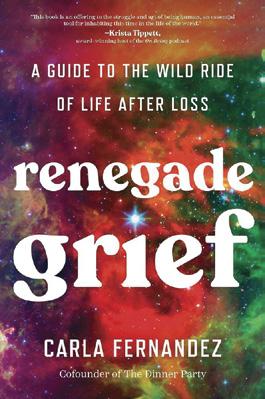
Straight Up, Without Wings: The Musical Flight of Joe McPhee
Joe McPhee, as told to Mike Faloon CORBETT VS. DEMPSEY, 2025, $30
Joe McPhee’s sonic explorations have spanned free jazz, electronic experimentation, and beyond for over six decades. Straight Up Without Wings charts the Hudson Valley-based multi-instrumentalist’s journey from his early days in Poughkeepsie to his international acclaim as an avant-garde jazz pioneer. With interviews, archival materials, and McPhee’s own words, the book captures his restless creativity and deep-rooted connection to the region’s musical landscape. A must-read for jazz heads and local music historians alike, it solidifies McPhee’s legacy as one of the most innovative voices to emerge from the Hudson Valley.
The Body Is a Doorway: A Journey Beyond Healing, Hope, and the Human
Sophie Strand RUNNING PRESS ADULT, 2025, $29.99
Sophie Strand’s second book The Body is a Doorway is both a personal odyssey and a love letter to resilience. From her home in Kingston, Strand weaves a story of chronic illness, medical misdiagnosis, and the hard-won path to healing through somatic therapy, ancestral wisdom, and self-discovery. With raw honesty and poetic clarity, she charts her transformation from suffering to selfempowerment, offering insights that resonate far beyond the personal. A vital read for anyone navigating illness or seeking deeper connection to body and spirit, Strand’s memoir is a testament to the power of healing.
On March 2 at 2pm, Strand will read at St. Gregory’s Church in Woodstock, presented by the Golden Notebook.
Many Long Years to Home: A Novel
Mary M. Flad
EPIGRAPH PRESS, 2024, $17.95
Margaret Fogarty’s journey starts in 19th-century Ireland, at the abrupt end of her childhood when she loses several family members to the cholera epidemic of 1832 which killed tens of thousands. She leaves her home in the southernmost reaches of the island and travels to Dublin, where she trains to be a nurse. Then, like millions of others from her homeland, she leaves Ireland in the 1840s and travels to North America, where she settles in New Haven, Connecticut, finding work at the local hospital. This tale centers the story of a female immigrant to the US and her heroism in the face of life’s challenges.
More Joy of Art
Carolyn Schlam
ALLWORTH PRESS, 2025, $50
Woodstock-based artist Carolyn Schlam offers an inviting guide to deepening one’s appreciation of visual art in this sequel to The Joy of Art. Blending art history, practical advice, and personal insight, Schlam breaks down the fundamentals—color, composition, technique—while encouraging readers to engage with art more thoughtfully and emotionally. Whether you’re a museumgoer, a budding artist, or simply curious about what makes a painting sing, this beautifully illustrated volume is both accessible and illuminating. Rooted in Schlam’s lifelong passion for creativity, More Joy of Art is a perfect companion for anyone looking to see—and feel—art with fresh eyes.
Renegade Grief: A Guide to the Wild Ride of Life After Loss
Carla Fernandez
SIMON AND SCHUSTER, 2025, $28.99
Cold Spring-based writer Carla Fernández redefines the grieving process in Renegade Grief: Hardcore Healing for People Who Love Big and Lose Big. Drawing from her own experience with profound loss, Fernandez rejects the sanitized, step-by-step grief narratives in favor of a raw, honest, and deeply compassionate approach. Blending personal storytelling with practical guidance, she offers a path for those navigating heartbreak on their own terms— messy, nonlinear, and unapologetically real. A powerful read for anyone reeling from loss, Renegade Grief is a fierce and tender companion for the hardest moments, written with wit, wisdom, and unflinching truth.
—Brian K. Mahoney

Adam Snyder
WHEELIE PRESS, 2024, $16
Ten is a suspenseful age. You can feel puberty looming. You’re just starting to untangle the mysterious ways of the grownups and you’re finally old enough to be granted a bit of independence and freedom. Life and the world are opening up wide, or at least that’s how it felt in the analog era, when kids were trusted to practice their navigation sans helicopter adults.
That time is lavishly and lovingly recreated in Adam Snyder’s genre-blending novel Kingston 76
Ten-year-old longhair Timothy Miller is thoughtful, feisty, and, like every kid, living in a world he never made: Dad’s gone, Mom and her girlfriend are running a women’s consciousnessraising group in the pink living room, and there’s a bit of a social gulf between his blue-collar uptown neighborhood and the kids in the upscale development whose parents work for International Photocopy Machines, the 800-pound gorilla in the local economy.
When we meet Timothy he feels acute embarrassment at his mom’s rustmobile, the Calico Chrysler; her porch couch covered in a batik tapestry makes his skin crawl, especially in contrast to the neighbor’s patriotic Bicentennial decor. He’s annoyed when his teacher disregards the national importance of the burning of their very own city by the British in 1777. He’s curious about the humans living in the scruffy apartment house next to the vacant lot where the kids play pickup baseball. He’s got a copy of The Real Men’s Guidebook, mail-ordered from the back of a comic book, and is working his way through recommended skills such as making an escape rope from bed sheets, improvising explosive devices, and creating a DIY crime lab.
Sometimes you need your own crime lab, especially when you notice that there’s weird bright green foam in the creek beside the vacant lot and the pleasant gay man who tells you he’s testing the water to find out what it is turns up dead. Timothy immediately gets to work, assembling water tests and photographs.
The junior high kids swing by the vacant lot, and one tries bullying Timothy, only to be brought up short by Charles Lambeau Jr., the adopted Black son of the city’s late, revered police detective, a smooth-as-silk kid who gives Timothy his calling card. When the two join forces, natural friends despite the slight age gap, the detective work gets serious—and possibly dangerous.
Snyder lives in Woodstock now, but he grew up in Kingston knowing every gap in the bluestone sidewalks from his perch on a banana seat, and it shows. This is mid-‘70s Kingston, Bicentennial Kingston, a scruffy company town with a mostly good-hearted and intelligent citizenry. The analog world of the ‘70s—when 10-year-olds could free-range and phones were tethered to walls, photos had to be developed, and you did your detecting with sneaker-rubber, bulletin boards, and library microfiche—is so vivid you can smell it.
The bond that forms between the two boys is organic and beautifully drawn, starting with vacant-lot politics. Though there’s an age gap, Charles, whose exquisite manners and moral core should be required detecting equipment at any age, clearly recognizes in Timothy a kindred spirit and an intellectual, and finding a friend like that is balm to Timothy’s angsty soul, the beginning of a great widening of his worldview.
The suspense builds to a fever pitch as the plot blends environmental crime and possibly deep-rooted corruption with a homophobic hate-murder and the boys attempt to unravel both and find connections. They go on dangerous missions that would daunt and amaze even the most battle-hardened internet sleuths of our century, leading them to some complicated truths about the adult world that even Charles hadn’t quite reckoned with.
This is Snyder’s first published novel, and one devoutly hopes there will be more. The interwoven mysteries, the coming-of-age epic, the subplot in which Timothy’s mom and her allies rescue an abused prostitute from the apartments from her pimp, and the satisfying resolution are just some of its delights. The rendering of the inner landscape of early puberty is achingly spot-on. The racial, social, gender, and economic realities of the `70s, such a hopeful time despite its inequities and awkwardness, and the intimate grit of a vivid little city make an intricate backdrop for the plot, from a 10-year-old’s first nervous but passionate attempts at detecting, to a conclusion that will impact the whole community. Has Timothy’s world changed completely, or has Timothy just learned to decipher it? Possibly both.
—Anne Pyburn Craig
Words Matter
Call it welfare and think dark men hanging on stoops, rolling dice, drinking from beer cans in brown paper bags, standing on street corners whistling at women walking home from office jobs, jeering, smirking, sneering, all the while giving each other macho high fives and smiles and bro hugs.
Call it a safety net and think ragtag children huddled around a fire in a one-room schoolhouse, think a barefoot farmer in overalls sandy-haired, sitting on a doorstep, his daughter, eyes blank, seated in a chair, passive, hard, staring at the camera, think job lost, the Great Depression.
Call them aliens and think invaders from a distant world hostile and green, the color of vomit, with long sinewy arms eyes with an epicanthal fold, forked tongue, devil’s tail, spying for an eastern emperor, sowing discord leaving chaos in their wake.
Call them migrants and think strangers wandering in the arid desert exhausted from the sojourn and the heat, from the planning and the walking, from the pleading and the talking and the begging and the beatings craving water, food, kindness, grace.
Call it an awkward gesture and think an adolescent boy concealing a pimple ripe with pus or perhaps placing his arm across his friend’s younger sister’s shoulder, trying to scooch close enough to smell her hair, to accidentally touch her breast, the awkwardness of pubescent sex.
Call it what it was, what it is, an embrace of nazism, fascism, apartheid, a salute to the brownshirts, the ku klux klan, proud boys, oath keepers, to bormann, to goebbels, bolsonaro, netanyahu, orban, to adolf eichmann, adolf hitler. Call it a call to arms, a negation of kindness, a denial of justice, an abnegation of mercy.
—Shari Aber
And Larkin said it will happen soon: the annulment of nature. It must be seen to be believed, and that is the disaster: When it is—at last—visible, it is—at last—past all hope.
—Lachlan Brooks
A Barbaric Yawp for Robert Milby (Robert Milby 1970-2024)
You’re not welcome in their propaganda chateaus not with your gloating over caskets & corpses, your elocution driving angels back to the rafters. You recite Poe’s “Coliseum” proud as the President reminding us everything’s better after falling into ruin. Your attaché carries a well-thumbed library of consumptives, suicides, & syphilitics, the old masters of poisoned friendships bedded together at last. You disguise yourself like a boarding school teacher who parts his hair in the center as if to preserve 1912 & wears corduroy jackets rubbed raw at the elbows by bachelorhood. Your Amish beard comes & goes. Coffee alone keeps you alive. You begin each reading with a pirate yelp & a few words for your favorite suicides.
Onion dirt is your native soil. Florida, New York, your carnival burlesque as well as your haunted grounds. Baudelaire schooled you in phantoms. Van Gogh’s ear lets you hear the maternal abyss singing its anthems. You can’t watch rain bead on a windshield without thinking of Sylvia’s tears. Ted taught you the hunger of crows.
You survived forty days in the desert by drinking the mirage. You’re the descendant of castle squatters, the ringleader of the demented circus, the conductor of dry lightning overtures. Donald Trump is lucky not to have you as a bastard son.
You’re too busy for an epitaph, but here goes:
You will not wear $1,000 alligator shit kickers nor drive a harridan home from a car show. You will not grace university halls nor be feted by our contagious empire. But you, yes, you, who still regrets not being born under the Sign of Syphilis, your sick flowers will stand as poetry.
—Will Nixon
Summer to Spring
Sadness is a chewable tablet in the fall. The riptide returns with a little less
water in the hourglass than yesterday. There is a bottle with your name on it, a plastic
orange, pills you don’t believe in but I believe in you and your barebranch will. Every year it all ends
and each time, leaves appear again.
—James Croal Jackson
Love Poem: Rumi
You stood on the bank of a river where a fur coat was floating by—
You dove in, not knowing how a bear would
end up wearing you—
—Timothy Liu
bury us / they don’t know terror rage like fever dance along my cheeks hot & bothered as the sun at midday
on a friday, let them pray instead, rip them out by roots, crush bloody flower petals between fingers feels like pulling my heart out of the earth, sprout tendrils like grape vines hold onto me
silence in the empty, echoes loud enough to be prayer i can take the sting out let them pray
let me help you wash the stains out they try and bury us they don’t know we are seeds
—Mikayla J. Dablan-Azony
Papers strewn across the room, I tried to write the perfect poem... But I got lost somewhere between the words I wanted to say and the ones I thought you would want to see written across the page. Now, it seems we’re at an impasse, and this is all I have to show for it.
—Regina Bergen
I Shall Write
I shall dip my pen in gold and write with the dust of stars
I shall write of ethereal heights and abysmal depths
I shall write of you and me
—Fay L. Loomis
Useless
My lazy cat Kudzu is an invaluable aid to meditation...
—Bob Grawi
From the mountain top I saw vast across the landscape, slopes, flats, rises, and other overlooks less than where I stood. The road’s curve disappears far below. No borders other than river. Does that hawk which spirals above the overlook make a bend in the thermals that carry wishes for peace? Can something simple as a song contribute to that long arc through the universe? There is no way to know what bestows grace where or when. All we can do is climb (declination more arduous than ascent) somewhere to get a better view for as long as we can. So, when we do what we do every day, dry our hands, gaze through a window, stretch, scratch, stare at a screen, there is some vision back of our eyes which daily isn’t in our sight.
—Guy Reed
I don’t know how most things work not you not me not the dryer in the laundry room I go about the days a bubble of ignorance around me as I dissect my love for you I want to see it splayed pinned on the table get close to it safely I want to understand it how it got here what it wants what it can do how it makes me move why it makes me cry
—Jannelle Roberts
Cahill
By 20, Eggy had lost all his hair, Hence his nom de guerre, Had a dome like a baby’s shiny bottom— Going bald was no biggie for Eggy, It wasn’t his coif or a lack thereof that got him
In the door at The Quilted Giraffe: He was the best pastry chef they’d ever seen. Besides, half the time his pasty bean Was crowned with a toque. No, Sean Cahill’s battle was coke. Those 80s Manhattan kitchens ran on blow And Eggy, well, he just couldn’t say “No.”
—Patrick Walsh
I remember / I forget
The forgetting comes first, then the remembering Worry at the empty side of the bed, then remembering Panic at the phantom aura on my ring finger, then remembering The urge to tell you first, then remembering This is the worst part I think a part of my brain hasn’t read the morning news Why didn’t you come home?
Where’s my ring? Why can’t you tell me?
On the first day of therapy I told my analyst I identify as a widow Sometimes it seems worse that you’re still out there and I’ve already mourned you Where did you go?
I forget, then
I remember
—Alexandra Poole
oh my why should I be surprised everyone’s just doing what they always do in the middle of a nightmare night under a blood moon
I’ve been looking for you all along like you’ve been looking for me nothing you believed in is what it appears to be the particular sand was a brutal sculptor it’s all because of the butterfly, oh the heartbreak of christmas trees and puppy dogs as the setting sun turns on the sunny moon the night breeze feels warm in my throat please never forget today something came across the screen and disappeared an imitation ovation played, oh my! and everything made me cry
—David Newman
Switchback Memory (towne historian)
There’s a changing fold a lost migration and a deli on Dire to die for Charlie who came from a good home but veered left at the ley lines Carla on Kenneth and the ruckus she caused Trixie from fourth during riot week where anarchists argue and pause the moon Bill who gets giddy whenever an ambulance passes Annie w/one blue eye Kiki teases but doesn’t mean it Serenades burn in small river towns
—Mike Jurkovic

By Peter Aaron Photos by David McIntyre
For decades, the movie theater was the cultural heart of many rural communities across America. The 1920s and ’30s were the peak period for the proliferation of local movie palaces built to offer cheap, entertaining escape to residents in towns where there was often nothing else to do on a weekend other than enjoy a magical night out at the pictures. Even in the depths of the Depression movie houses thrived, with hundreds opening between 1925 and 1930 to become the artistic anchors of the small, agriculturally dominated towns they served.
But with the advent of television in the 1950s and the rise of cable and multiplex cinemas in the 1980s and ’90s, many of them shuttered or recalibrated to attract an alternative audience by reinventing themselves as arthouse cinemas. With today’s dominance of streaming movie services, however, surviving independently run, unconventional outlets have had their work cut
out for them when it comes to making their bottom lines while keeping their doors open and their screens lit.
In the Hudson Valley, there’s the pioneering Upstate Films, which opened as a nonprofit in 1972 and acquired the Orpheum Theater in Saugerties in 2021; Denizen Theatre in New Paltz; multi-arts institution Time and Space Limited in Hudson; the Moviehouse in Millerton; Tinker Street Cinema in Woodstock; and the Jacob Burns Film Center in Pleasantville. (The Community Theater in Catskill, which closed in 2020, will reopen in May as a film and live performance venue under new ownership.) And a handful have been able to keep their projectors rolling in the faces of the hydra-headed mall multiplexes and the streaming monoliths by adapting to become nonprofits that present non-mainstream programming. This month, we decided to check in with a few of the bold nonprofit theaters in the region to see how they’ve been faring.
Built in 1905 as the Rosendale Casino, the building that houses the Rosendale Theater was briefly the town’s firehouse before becoming a full-time movie house in 1920 and adding a stage for vaudeville and burlesque performances in 1930. In 1949 the theater was taken over by the Cacchio family, who ran it until 2009, when their surviving members announced their plans to sell the business. In response to fears of losing their beloved local landmark to ever-looming thoughtless development, a group of concerned area movie lovers banded together to form the Rosendale Theater Collective with the goal of purchasing and preserving the theater; the RTC’s board of advisors includes actors Aidan Quinn, David Strathairn, Melissa Leo, Denny Dillon, and Mandy Patinkin, radio personality Bruce “Cousin Brucie” Morrow, screenwriter Ron Nyswaner, and author Kim Wozencraft. Through dozens of small fundraising efforts—potluck dinners, live-music

benefit events, an online auction—the group was able to buy the facility. A 2010 grant of $50,000 from the Pepsi Refresh Project covered muchneeded renovation costs, and the theater attained its 501(c) (3) status the same year. Despite the Rosendale Theater’s success on those fronts, though, its existential efforts remain ongoing.
“Covid definitely hurt us,” says Rob Leitner, the theater’s managing director. “And, of course, streaming services, people binge watching at home, have meant falling ticket sales. We only have one screen, and we can’t get new big releases the first week they’re out—we don’t really do blockbusters or Marvel movies—so we try to find programming that appeals to broad audiences while also offering something different. We do newer indie films along with our themed retro film series, all of which have been greatly successful: classic films, music documentaries, spaghetti westerns, ‘Sunday Creature Features,’ our ‘WTF Wednesdays’ series of quirky films, silent films with live piano accompaniment. But ticket sales only account for about 30 percent of our gross revenue, and you can only make so much from selling popcorn and soda. So we’ve renovated to make it a more flexible arts space, taking out four rows of seats to open up a dance floor and expand into doing more live events.” (March 14 promises a concert by finger-style guitarist Henry Ferland.)
Next year, the Crandell Theatre in Chatham will mark its 100th anniversary. “Right now, we’re closed while we work with an architect to do some renovations ahead of the centennial,” says the Crandell’s director, Brian Leach. “Since the property was built in 1926, there were some pressing repairs that we had to do, like updating the boiler, and the roof needed to be redone. We’re also expanding the lobby; restoring some of the original lighting fixtures; putting in a retractable screen and all-new, ADA-compliant seats; and
converting the storefronts in the front of the building to spaces where customers can gather to wait for screenings instead of lining up outside when the weather is bad.” A major line maker at the theater is the annual FilmColumbia festival, which was initiated in 1999 to screen upcoming domestic and international films for 10 days in late October.
“With all of the competing movie-viewing options today, I think it’s rare for a historic onescreen movie theater to still be in existence and not have gone the nonprofit route and be multifaceted with their programming,” says Leach about the site, which became a nonprofit in 2010 and is the largest and oldest single-screen theater in Columbia County, and was added to the state and national registers of historic places in 2017. It runs community outreach programming that includes its Crandell Kid Flicks series and Farm Film Festival, which benefits the local food pantry. “We’re always looking for new revenue streams, new ways to raise funds. And we’re always looking for ways we can expand our offerings within our mission by adding to our facility and expanding our programming.
In the end, our ‘product’ is the movie-going experience, which is something you can only get at an actual theater like this one.” While the renovations are taking place at the Crandell, it’s keeping its presence in the area aloft via sponsored screenings at nearby multi-arts center PS21.
“It was originally a roller rink,” says Gail Lansky, a preschool teacher who serves as vice president of the Triplex Cinema about the architecturally modern complex in Great Barrington, Massachusetts. “In 2022, about 20 years after he’d opened it as a movie theater, the original owner decided to get out of the business and sell the building. An outside developer with a reputation for buying up older cinemas and shuttering them was interested in buying it, and when people in
the community got wind of that in March 2023 they formed Save the Triplex, a grassroots group, to buy it and reopen it as a nonprofit. I’d just moved to the area, and I’d worked in indie cinema before, doing outreach for an organization in Amherst. I read about what was happening with the theater in the Berkshire Eagle, so I got in touch with the organizers and told them, ‘I don’t have money to help out, but I can offer my time.’” Save the Triplex swiftly lived up to its name, raising seed money through individual donors and taking ownership of the operation and reopening in November 2023.
Also helping to sustain the theater is its membership program, which Lansky says now numbers more than 500 individuals. “Members get free movie tickets on their birthdays, discounted and early access tickets, free popcorn, and other perks,” she explains. “When the Triplex first opened two decades ago it was a seminal moment for Great Barrington, and it really became the nexus of nightlife here. We’re lucky to have the Mahaiwe Performing Arts Center two blocks away, but it’s not open every night. People here really feel strongly about the need to continue to have a movie theater in town and they’ve really stepped up.” Belying the cinema’s name, the building has a fourth movie-screening space, for which it has recently obtained a grant earmarked for renovations to get the additional outlet operable.
“A big moment for us was when Bill Murray came to speak at the screening of The Life Aquatic with Steve Zissou that we did after we’d reopened,” Lansky recalls about the 2023 guest-speaker film series that also included Leonard Bernstein’s daughter Jamie Bernstein for a showing of Maestro and director Susan Seidelman for Desperately Seeking Susan. “Murray said, ‘I don’t watch movies on TV. There’s nothing that can take the place of seeing a movie in an actual movie theater.’”
Kevin Mosca
Matthew Bede Murphy
Sue Muskat
Erik Daniel White
17





JOE BOYD AT THE LOCAL IN SAUGERTIES
March 18 at 7pm
Thelocalsaugerties.com
If you threw it hard enough, you could probably stop a tank with a copy of Joe Boyd’s new book about music from around the planet, And the Roots of Rhythm Remain. At over 900 pages, the epic volume, subtitled “A Journey Through Global Music,” has some serious heft. But, of course, tossing the weighty tome would mean letting go of it. And as it’s utterly fascinating throughout—the book’s pages are alive with the riveting stories of exotic, colorful musics and their makers—the mere thought of doing that would be a nonstarter for most curious music lovers. To discuss the volume and its subjects, the author, one of modernity’s most legendary record producers, musical explorers, and respected raconteurs, will pay a rare visit to the Hudson Valley to host a multimedia presentation at the Local on March 18 at 7pm. Admission is free.
“Writing the book took a lot longer than I thought it would,” says the Boston-born Boyd, whose preceding book, 2011’s acclaimed White Bicycles, is a memoir of his years as a prime mover in the eye of the musicdriven, Technicolor cultural hurricane of the 1960s. “I wanted to write about world music because most other world music books are too academic. Ninety-five percent of the people who listen to music want it to be the soundtrack to their lives—they want the music
they hear to reflect them. It’s mainly been us ‘decadent cosmopolitans’ who are open to hearing music from other cultures. [Laughs.] But thankfully that’s been changing because of the internet; more people are getting exposed to music from other parts of the world.”
There was certainly no internet in 1964, when Boyd, a Harvard grad, got a job with renowned music promoter George Wein, who took him along to Europe to help with tours there by Muddy Waters, Coleman Hawkins, Sister Rosetta Tharpe, and other blues and jazz greats.
While under Wein’s wing he assisted with the live sound at the 1965 Newport Folk Festival, which was famously the occasion of Bob Dylan’s epochal “electric” set. What did Boyd think of his depiction during that heated scene in the recent Dylan biopic A Complete Unknown? “I thought the movie was fantastic,” he says via Zoom. “Although they credited me as ‘sound engineer’ when it was actually [future Doors and Janis Joplin producer] Paul Rothchild who was running the sound. Really, I just moved some microphones around on stage.”
By 1966 Boyd was based in London and had cofounded pivotal psychedelic venue the UFO Club, where the house bands were Pink Floyd and Soft Machine, two acts whose earliest recordings he produced. As a producer he went on to work with Nick Drake, Fairport Convention, the Incredible String Band, John Martyn, Vashti Bunyan, and others, while as a soundtrack collaborator he worked with Stanley Kubrick on 1971’s A Clockwork Orange and supervised the recording of “Dueling Banjos” for 1972’s Deliverance. He also produced and codirected the 1973 documentary Jimi Hendrix, and his further music production credits
include records by R.E.M., Maria Muldaur, Kate and Ann McGarrigle, 10,000 Maniacs, and Billy Bragg. Throughout it all has been Boyd’s undying obsession with music from outside the Anglo-American axis, and in a sense the sprawling And the Roots of Rhythm Remain—called “the War and Peace of world music” by MOJO magazine, who rated it five out of five stars—is the culmination of his life’s work in that realm. Diving into the rich tapestry of indigenous and more recent strains of ethnic styles from such diverse regions as Africa, Cuba, South America, the Caribbean, Eastern and Western Europe, Southeast Asia, Russia, and elsewhere around the globe, the book is compelling not just for its discussions of the music itself and the history that shaped it, but also for its tales of the unique personalities of its architects.“[Fela Kuti drummer] Tony Allen, who I got to know here in England, is one of my favorites,” Boyd enthuses. “He told me about how he heard [American jazz drummer] Max Roach and was influenced by him to incorporate the high-hat cymbals into his own playing, which basically led to the Afrobeat drum style. Another is [Brazilian guitarist, singer, and composer] Joao Gilberto, who created bossa nova by developing a new, softer way of playing and singing by practicing in his sister’s tiled bathroom.”
In these dark times of isolationism, perhaps the book can serve as an antidote. “I hope people enjoy it and that it gets them more interested in different cultures and their history,” says Boyd. “And that it opens up their listening habits and they’re more able to appreciate all of this other wonderful music.”
—Peter Aaron

There are over four million podcasts in the world and well over 500 million people listening to them. Over half the US population between age 12 and age 85 listened to at least one in the past month.. Since their inception in 2020, the Ambies—the annual awards for podcast excellence— have seen submissions increase exponentially each year, well into the thousands. And when this year’s contenders were announced on Valentine’s Day, two of the Podcast Academy’s 198 nominations—Best Indie and Best Personal Growth/Spirituality—went to the Rosendalebased TMI Project Story Hour.
“Who cares if we win? Being included is win enough for me,” wrote TMI cofounder and executive director Eva Tenuto on Facebook. “Happy Valentine’s Day, Julie.”
It’s a bittersweet season for Tenuto. The nonprofit TMI Project was born 15 years ago last month. And it was during that first “transformative memoir” performance that Tenuto and her collaborator, Julie Novak, fully realized they were destined to be much more than friends. Novak died last August after a two-year struggle with breast cancer, leaving a huge rip in the cultural cosmos for the many who’d relished her comedic gifts and been bolstered by her friendship. In her 15-year career as a standup comic and storyteller, she was a marvel at the microphone, joyfully and defiantly queer, skewering human foibles with a crystal-edged saber of wit and timing. Besides codirecting TMI, she helmed the Future Perfect Project, a national arts initiative that empowers
LGBTQIA+ youth to share their visions and stories. Having found some magic that worked, Novak—who grew up closeted in the 1980s—was fearless and tireless in sharing it.
Still in deep mourning over the loss of her wife’s physical presence, Tenuto finds some relief in her sense that their collaboration will never truly end. “I really don’t experience our relationship in the past tense,” she says. “It’s a lot to adjust to on this plane, and also, I can still feel us working and creating, being in communication. I hope I don’t sound too crazy, but it feels more real than I ever expected. It’s been quite a comfort.”
Something that Tenuto believes Novak would want us all to remember is that showing up as so relentlessly real took work. “One of so many things I loved about her was how dedicated she was to doing whatever work was necessary to be able to hold onto her light,” she says. “It wasn’t effortless. Julie was in therapy, she was in recovery, she did a lot of things to be able to be the person that she was, and she really admired other people who were willing to work that hard to be who they were. If you just knew her post-TMI, you’d never believe that this was once somebody with no confidence.”
In its 15 years of existence, the TMI Project, a workshop in which Novak, Tenuto, and their collaborators guide participants in turning their most cringe-inducing memories into standup routines, has helped 3,000 storytellers speak truth to 300,000
audience members in over 250 performances. The award-winning podcast version has listeners in 167 countries, two acclaimed documentary films have been released, and a docu-short, One Story at a Time with Trevor Project cofounder Celeste Lecesne, is currently at film festivals. “It all continues to unfold in ways that baffle me,” says Tenuto. “We’re doing a lot of work with young people right now, and we’ve got a lot of big plans for that.” Novak, who in her own youth yearned to meet a confident, reassuring lesbian with a beautiful lady on her arm who’d tell her it would be okay, leaves a living legacy that embodies that role.
Artist and educator Jacinta Bunnell, a close friend of Novak’s for 25 years, says losing Novak felt like “the best carnival I’ve ever been to has suddenly packed up in the middle of a cloudy day. I look around the empty lot where the games and bandstand and funnel cakes and enormous stuffed orange bears were, not knowing what I expect to find. I begin to notice wisps of cotton candy gently gliding across the empty gravel parking lot, alighting on one glistening stone after another before eventually floating up to the clouds and mixing in with one of those sunsets that leaves you awestruck. It is then that I understand that she has left pocket-sized pieces of herself for us to find everywhere. And those pieces can be scooped out of each one of us whenever the moment calls for it.”
—Anne Pyburn Craig

Tuvan group Alash performs at the Local in Saugerties on March 15. The show will be preceeded by a throat-singing workshop.
Throat Culture
ALASH AT THE LOCAL IN SAUGERTIES
March 15 at 8pm
Thelocalsaugerties.com
When my editor asked me to write about “Tuvan throat singers,” I worried it was guys from Long Island who’d studied the method on YouTube. But no, this is the real deal; the Alash Ensemble are three citizens of Tuva (officially the Republic of Tyva), a part of Russia in southern Siberia. The group will perform at the Local in Saugerties on Saturday, March 15. For those interested in diving deeper into throat singing, there will be a workshop before the performance at 6:45pm.
“Throat singing” is a misnomer, though it’s the translation of a Tuvan word, khoomei. Musical notes typically reverberate in the head or chest, allowing the singer to produce overtones—usually two or three harmonics can be heard above the original note. In a sense, a single person can sing a chord. In addition, there are guttural growls, and a style called sygyt, which means “whistling,” and produces a sound like the high notes of a flute. Ethnomusicologists connect overtone
singing with traditional animist religion. Vocalists often travel widely until they find the perfect river or mountain to sing to. The lyrics are difficult to translate, but often involve the speed of horses, the beauty of women, the benevolence of the night sky.
Throat singing is an ancient tradition, appearing in cultures around the world, including those of the Inuit, the Xosha of South Africa, the Bashkirs of eastern Russia. The effect is also heard in Sardinian folk music and Tibetan Buddhist chanting.
For some, the fascination of throat singing is purely musical. For others, it’s biological. How can the human body produce such tones? How can a person sound like a giant insect? One reason Tuvan songs are popular now is that some of their effects resemble elements of techno music and hip-hop. The latest sonic technology has allowed us to imitate the musicality of our tribal ancestors. Not surprisingly, Alash has performed with the rapper Rahzel, from the Roots.
The ensemble formed at the Kyzyl Arts College in 1999; it’s named after the Alash River in Tuva. The group began touring internationally in 2006. Alash has toured the US every year since. In 2008 they appeared on Jingle All the Way , an album by Bela Fleck and the Flecktones; later they joined that band
on the road. Alash has also teamed up with the Sun Ra Arkestra.
This is acoustic music, with instruments rarely heard in Saugerties. The igil is a two-stringed, leaf-shaped chamber held between the legs and bowed like a cello. Often the scroll on its headstock is carved into the shape of a horse’s head. The three-stringed doshpuluur has been compared to the banjo. The xapchyk is a rattle fashioned from the dried scrotum of a bull. Inside are sheep knuckle bones that rattle when the instrument is shaken. The duyuglar are two horse’s hooves, clapped together to produce the sound of a galloping stallion. The amyrga is a wooden flute covered with animal gut, which imitates the call of the male red deer during mating season. Songs that extol nature are played on instruments made from trees and scrotums.
Though the method is ancient, it was first brought to the West fairly recently, by the documentary Genghis Blues (1999), in which the blues singer Paul Pena discovers Tuvan music on a shortwave radio, teaches himself throat singing, and eventually visits Tuva.
Alash’s music is associated with shamanic healing, so if your sinus condition improves after the concert, please send them a grateful email!
—Sparrow


































































































































Lila Downs plays UPAC in Kingston on March 22.
March 7 at the Colony in Woodstock
Four cool women in cool retro outfits playing cool surf instrumentals? Sign us up. Ho-dad-ing down from Toronto, the beehive-bedecked Surfrajettes were launched in 2015 by guitarists McKenzie “Shermy” Freeman and Nicole. The band became online sensations via their 2018 version of Britney Spears’s “Toxic” and their ace adaptations of other hits, but their originals are sharp as well: Check their new sophomore album, Easy as Pie. Black Widows open. (Robbie Fulks sings March 8; Ted Leo and the Pharmacists rock out March 22.) 7pm. $23.37 advance: $29.02 day of show.
March 7 at the Palace Theatre in Albany
Led by Andrii Novatorov, the Ukranian symphonic orchestra Lords of the Sound will roll through our region for their first American tour. For the ensemble’s 10-date debut, the program is made up of prime selections from the award-winning film composer Hans Zimmer’s storied oeuvre: scores from such beloved blockbusters as Dune, The Lion King, The Dark Knight, Pirates of the Caribbean, Interstellar, Sherlock Holmes, Man of Steel, and many more. (Charles Wesley Godwin sings March 15; the Albany Symphony Orchestra with Reena Esmail plays April 5.) 7pm. $58-$143.
March 15 at the Park Theater in Hudson
Western Mass indie rock band Cloudbelly is fronted by singer-songwriter Corey Laitman, who made her name on the New York anti-folk scene. With that background, it’s easy to see where her current project gets its strong acoustic-centered, melodic, harmony-rich elements; the quartet’s lush, electro-psych, dream-pop side is more reminiscent of Deerhunter, Galaxie 500, or the Cocteau Twins. Their full-length debut, i know i know i know, was named by the Boston Globe as one of the best records of 2024. (Habbina Habbina returns March 1; HushUp sneaks in March 7.) 8pm. See website for ticket prices.
March 19 at Daryl’s House in Pawling
Presented with the Blues Foundation’s 2009 B. B. King Entertainer of the Year Award by no less than King himself and Bonnie Raitt, Detroit-born singer Janiva Magness has also earned seven Blues Music Awards, a Canadian Maple Blues Award, and several Grammy nominations. Her 17th studio album, Back for Me, will be released this month. To celebrate its appearance, she’s bringing her steamy brand of red-hot modern blues and soul to Dutchess County. Cimarron 615 opens. (Ana Popovic pops by March 13; Poppa Chubby sits in April 2.) 7pm. $32.85-$44.17.
March 22 at UPAC in Kingston
Described as “a Mexican American Laurie Anderson or if Frida Kahlo were a musician instead of a visual artist” by All Music, multiple-Grammy-winning singer Lila Downs is a true cultural treasure. Topped with her powerful, emotion-rich voice, Downs’s deep, moving music draws from traditional Mexican roots and indigenous styles—she studied anthropology at the University of Minnesota—and bears elements of blues, jazz, soul, and pop and themes of social activism. (Jazzreach jams at the Bardavon March 6; Angelique Kidjo comes back to Kingston March 27.) 8pm. $25-$85.
March 23 at Tubby’s in Kingston
Formed in 1979, Scream is known to Nirvana fans as the main alma mater of Dave Grohl, but the legendary Washington, DC, hardcore band was already an established name well before his late 1980s tenure. In 2023, the year original drummer Kent Stax succumbed to cancer, Scream released their sixth studio album, DC Special, on Dischord Records, the band’s initial home label. Now, with new drummer Jerry Busher, the influential group is once again kicking ass on tour. (Ivan Julian rocks March 1; Jeremy Bradley Earl and Daniel Higgs play March 20-21.) 7pm. $24.72.
—Peter Aaron



“THE DIRTY DUTCHESS” AT THE EMPIRE TRAINING CENTER FOR THE ARTS IN POUGHKEEPSIE March 15 Empirearts.org
The Chance Theater in Poughkeepsie has seen some things. For decades, the scrappy little venue has been a proving ground for rock gods and punks alike, with everyone from the Police to David Bowie, Bob Dylan to the Ramones, and Metallica to Mudvayne gracing its stage. If you came of age around here, chances are you caught a show here—maybe even got a little beer spilled on you in the process. The floor has been sticky for as long as anyone can remember, but that’s part of the charm.
These days, however, the Chance is becoming more than just a hallowed hall of rock ‘n’ roll memories. The Empire Training Center for the Arts (ETCA) has moved in, transforming the venue into something much more than a music club. Their mission: to train the next generation of theater professionals—stagehands, lighting designers, sound engineers, producers, and performers—by giving them hands-on experience in a real, working venue. Instead of tearing tickets at some black-box theater in a college basement, students at ETCA will be running a space that has hosted some of
the biggest names in music history.
And on March 15, ETCA is throwing a party to prove it. “The Dirty Dutchess” is more than just a fundraiser, the evening will be a showcase of what’s to come: a night of live performances, behind-the-scenes demonstrations, and a glimpse into how the venue’s transformation is taking shape. There will be music (of course), but also theater and dance, a show that’s part concert, part immersive experience. Pop-up performances will take over unexpected corners of the theater, blurring the lines between audience and artist with burlesque performers, singers, dancers, and street performers of many stripes, including vocalist Andrea Burns, burlesque artist Qualms Galore, juggler Justin Weber, harmonica virtuoso Jiaya He, and hula hooper Pinkie Special. The evening will be hosted by actress Kaitlin Hopkins and Frank Castella Jr., president and CEO of the Dutchess County Regional Chamber of Commerce.
“The Dirty Dutchess” moniker references the venue’s pre-rock history as a vaudeville house. “One of the first stories somebody told me when I got here was about it having a reputation for being a little saucy because of it being a vaudeville and burlesque house that the community referred to as the ‘dirty dutchess,’” says Santini. “And we thought, going back to the very first chapter and celebrating that seemed like a night that could be really fun and entertaining and not like anything else.”
But this night isn’t just about nostalgia—it’s about ensuring The Chance has a future. ETCA’s goal
isn’t just to keep the venue alive but to turn it into a training ground for the next wave of performing arts professionals. In an era where arts education is constantly on the chopping block, ETCA is building something rare: A place where people can learn the ropes of the industry in a (legendary) real-world setting, not just a classroom.
Peter Flynn, a seasoned theater director and ETCA board member who is the artistic director of “The Dirty Dutchess,” sees this event as the first step in a longterm project to put the venue’s future in the hands of the students themselves. “My personal hope is that a year from now, we’re doing this evening again and it’s completely managed, curated, and run by the students,” Flynn says.
For those who have ever moshed, swayed, or screamed along to a song at the Chance, this is an opportunity to ensure the next generation gets its moment in the spotlight—whether they’re onstage, working the boards, or running the show from behind the scenes. The venue may have been built on rock 'n' roll, but thanks to ETCA, its next chapter is about more than just the music. It’s about passing the torch to the next generation of creators, ensuring that The Chance remains not just a place to see a show, but a place to build a future.
“The Dirty Dutchess” takes place on March 15 from 8:30-10:30pm. Tickets are $81.88.
—Brian K. Mahoney

March 8 at Nightswim, Kingston Burlesque: where satire meets seduction, and the art of undress is elevated to a winking, rhinestone-studded rebellion. From its bawdy Victorian roots to the neoburlesque revival, the form has always been about more than just skin—it’s a celebration of presence, control, and the tease as high art. Cosmic Cherry Productions brings this tradition to Nightswim in Kingston with Sirens Burlesque Revue, a lineup of dazzling performers including Ginger Maraschino, Kate Beyond, and Susie Dahl. Expect shimmy, song, and stagecraft honed to a tantalizing edge. 8pm.
March 8 at the Ashokan Center in Olivebridge
At the Ashokan Center—where history, nature, and music intertwine—March means maple season. Maple Fest is a daylong celebration of sugaring, sustainability, and seasonal delights. Visitors can tour the center’s working sugar shack, see tree-tapping demos, and enjoy fresh maple syrup over pancakes. Traditional music and blacksmithing demos add to the rustic revelry, while guided hikes showcase the Ashokan Center’s 385 acres of preserved land. As a hub for environmental education and folk arts, the center makes Maple Fest more than just a sweet treat—it’s a hands-on lesson in heritage and the natural world.
March 8 at the Rosendale Theater
The Rosendale Theater will host a special screening of Borderland, a compelling documentary by acclaimed filmmakers Pamela Yates and Paco de Onis. This event, part of Amnesty Mid-Hudson’s 11th Annual Human Rights Film series, serves as a fundraiser for the Ulster Immigrant Defense Network (UIDN). The film delves into the pervasive impact of US immigration policies, highlighting the resilience of immigrant communities. Following the screening, attendees can engage in a panel discussion with the filmmakers. The afternoon also features live music by Livia and Bill Vanaver and a silent auction. Proceeds benefit UIDN. 1pm.
Southbound Writers Round Tour
March 9 at the Common Good in Ellenville
This intimate evening at Ellenville’s new bookstore/ bar promises a blend of soulful performances and
storytelling, offering a glimpse into the creative processes of the singer-songwriters Ian Flanigan, Jim Ranger, and Randall Fowler. Flanigan, a Saugerties native, gained national recognition as a finalist on season 19 of “The Voice,” captivating audiences with his distinctive, gravelly voice. Jim Ranger, hailing from Bakersfield, California, was the runner-up that season, and is known for his heartfelt delivery and rich, soulful tones. Charleston’s Randall Fowler brings a Southern rock flair, complementing the trio with his dynamic stage presence. 7pm.
Sam Morril
March 13 at the Egg in Albany
Sam Morril, one of New York City’s most incisive standup comedians, brings his The Errors Tour to the Egg in Albany. Known for his sharp wit and masterful joke crafting, Morril has been a fixture on Comedy Central’s “This Week at the Comedy Cellar” and has graced stages nationwide. His television appearances span “The Late Show with Stephen Colbert,” “The Late Late Show with James Corden,” and “Conan.” Beyond stand-up, Morril co-hosts the podcast “We Might Be Drunk” with Mark Normand and has a cameo in the Academy Awardnominated film Joker. 7:30pm.
Linda Montano: Laugh/Cry with the Chakras
March 15 at Kleinert/James Center for the Arts, Woodstock
Linda Montano doesn’t just make art—she lives it. A pioneering force in performance art, Montano has spent decades exploring endurance, transformation, and the blurred line between art and life. In “Laugh/Cry with the Chakras,” she invites participants to tap into deep emotional currents through sound, movement, and interactive performance, drawing from her “14 Years of Living Art” project. Whether you need catharsis or cosmic realignment, Montano’s practice offers a space to let it all out. 12-2pm.
Ulster County Fiber and Cider Tour
March 22, various locations in Ulster County
The Ulster County Fiber and Cider Tour invites enthusiasts to explore local fiber farms and yarn shops, culminating in a lively honky-tonk after party at Twin Star Orchards. This event offers a one-of-a-kind opportunity
to witness sheep shearing, engage with artisans, and celebrate the region’s rich fiber arts and cider-making traditions at eight farms across the county. Whether you’re a seasoned fiber artist or simply curious, join fellow enthusiasts for a day of creativity and community. 10am-3pm.
Cellblock Visions
March 9 at the Spencertown Academy Arts Center
“Almost everyone in prison is either making art or buying it,” notes Phyllis Kornfeld in Cellblock Visions: Set Free in the Penitentiary, her 1999 survey of prison art. For over four decades, Kornfeld, an educator and author, has led art workshops in jails and prisons across the country, from county lockups to death row. Her slide lecture offers a rare glimpse into the creativity that flourishes behind bars—revealing an unseen subculture where selfexpression defies confinement. 2pm.
Indie Author Book Fair
March 22 at the Kingston Public Library
The Hudson Valley’s literary scene thrives on community and collaboration, and the inaugural Indie Author Book Fair is a testament to that spirit. Organized by Valley Girls Media, the dynamic duo behind the “Valley Girls” podcast, this event offers local independent authors and booksellers a platform to showcase their work. Cofounders Jenny Leifer and Jennifer Santiago, both lifelong residents of the region, are passionate about amplifying the voices of Hudson Valley creatives. Join them at the Kingston Public Library to discover new reads, engage with authors, and support local talent. 10am-4pm.
Tom Green
March 28-29 at Laugh It Up Comedy Club in Poughkeepsie
Tom Green, the original agent of absurdity, is taking his comedy off-road on his “Home to the Country” tour
The man who once baffled a generation with “The Tom Green Show”—a surrealist fever dream of pranks, provocations, and pure chaos—has traded shock for storytelling, mining his rural life for laughs. But don’t expect domestication—Green’s stand-up is still as sharp, strange, and self-deprecating as ever. Whether you remember him from MTV mayhem or his stint as Hollywood’s wild card, this is a chance to see a legend unleashed. 7pm and 9:30pm.
Breakfast with a Giraffe, Kathryn Freeman, oil on linen, from the show "If These Walls Could Talk" at Carrie Haddad Gallery in Hudson.
2 ALICES COFFEE LOUNGE
311 HUDSON STREET, CORNWALL
“Pictures About Words.” Collage and assemblage by India and Bill Braine. Through April 20.
510 WARREN ST GALLERY
510 WARREN STREET, HUDSON
“Lipkowitz Returns to Africa.” Photography by John Lipkowitz. Through March 30.
THE A MANO GALLERY
17 WATER STREET, TORRINGTON, CT
“In Dialogue: The Figure in Painting, Drawing and Sculpture.” Work by Karen Bonanno. Through March 28.
THE ALDRICH CONTEMPORARY ART MUSEUM
258 MAIN STREET, RIDGEFIELD, CT
“A Garden of Promise and Dissent.” Group show. Through March 16.
ART OMI
1405 COUNTY ROUTE 22, GHENT
“Staging Area: A Barn Raising in Two Parts.” Installation by Erin Besler. March 15-June 8.
ART SOCIETY OF KINGSTON
97 BROADWAY, KINGSTON
“Grimaldi Inspired by Pollock.” Abstract works by Mark Grimaldi. March 1-30.
“An Assembly of Emerging Forms.” Paintings by Meredith Rosier. March 1-30.
“Small Works.” Group show. March 1-30.
BERNAY FINE ART
296 MAIN STREET, GREAT BARRINGTON, MA
“Visual Verse: When Poetry Meets Paint”. Work by Fern Apfel, Sue Muskat Knoll, Mel Bernstine, Warren Isensee, and FAILE. March 29-April 27.
THE CAPA SPACE
2467 QUAKER CHURCH ROAD, YORKTOWN
“Faces of Exodus.” Photographs by John Moore. Through March 23.
CARRIE HADDAD GALLERY
622 WARREN STREET, HUDSON
“If These Walls Could Talk.” Work by Richard Britell, Kathryn Freeman, Brigid Kennedy, Glenn Palmer-Smith, Judith Wyer and the late Lionel Gilbert. Through April 6.
CATSKILL ART SPACE
48 MAIN STREET, LIVINGSTON MANOR
“Lauren Daccache, Elizabeth Orr, and Eleanor White.” Group show. March 8-April 26.
CIRCLE 46 GALLERY
46 WARREN STREET, HUDSON
“Entanglements.” Show of work by couples: Mark Allen and Will McLeod, Michael Garfield and Nancy O'Hara, Shannon Greer and Charlotta Janssen, Tom Hill and John Paradiso, Aby James and Keira McGill, Dave King and Frank Tartaglione, Katie Lau and Taylor McGill, Cheryl Lickona and Chad Weckler. Through March 30.
CLARK ART INSTITUTE
225 SOUTH STREET, WILLIAMSTOWN, MA
“Pastoral on Paper.” Paintings and drawings of 17th- and 18-century shepherds. March 8-June 15.

CPW (CENTER FOR PHOTOGRAPHY AT WOODSTOCK)
25 DEDERICK STREET, KINGSTON
“My Sister My Self.” Photographs by Colleen Kenyon and Kathleen Kenyon. Through March 31.
“Recess.” Photographs by Keisha Scarville. Through May 4.
“Ward 81.” Photographs of an Oregon psychiatric ward in 1976 by Mary Ellen Mark. Through May 4.
CREATE COUNCIL ON THE ARTS
398 MAIN STREET, CATSKILL
“What We Hold: Stories + Objects.” Group show. Through March 9.
CUNNEEN-HACKETT ARTS CENTER
9 & 12 VASSAR STREET, POUGHKEEPSIE
“Paradise.” Photographs by Ian Hutton and paintings by Selva Ozelli. March 7-April 25.
DAVID M. HUNT LIBRARY
63 MAIN STREET, FALLS VILLAGE, CONNECTICUT
“Read Between the Lines.” Work by Jon Kopita. Through March 21.
DIA BEACON
3 BEEKMAN STREET, BEACON
“Andy Warhol: Shadows.” An installation that surrounds the viewer with a series of canvases presented edge-to-edge around the perimeter of the room.
DISTORTION SOCIETY
155 MAIN STREET, BEACON
“The Evolution of Mark Making.” Work by Kipton Hinsdale. Through April 8.
FRANCES LEHMAN LOEB ART CENTER AT VASSAR COLLEGE
124 RAYMOND AVENUE, POUGHKEEPSIE
“Between a Rock and a Hard Place: Black Space-Making from Harlem to the Hudson Valley.” Through August 17.
“An Unfamiliar Place: Modern Landscape in East Asian and Asian American Works on Paper.” Through March 30.
“Great Green Hope for the Urban Blues.” Through August 10. “Water/Bodies.” Work by Sa’dia Rehman. Through August 17.
FRONT ROOM GALLERY
205 WARREN STREET, HUDSON
“Amy Hill.” Paintings. March 15-April 19.
GALLERY40
40 CANNON STREET, POUGHKEEPSIE
“Talisman.” The exhibition explores the world of magic and dreams where boundaries between illusion and reality are fading into each other. March 15-April 27.
GARRISON ART CENTER
23 GARRISON’S LANDING, GARRISON
“Depth Perception.” Work by Greg Slick. Through March 9.
GOSHEN PUBLIC LIBRARY & HISTORICAL SOCIETY
366 MAIN ST, GOSHEN
“Focal Points.” Photos by Hudson Highlands Photography Club & Workshop members. March 1-April 29.
GREEN KILL
229 GREENKILL AVENUE, KINGSTON
“David Gonzalez and Karen Jensen.” March 1-April 26.
GRIT WORKS | GRIT GALLERY
115 BROADWAY, NEWBURGH
“Newburgh Now: A Group Exhibition on Our City of Creatives.” Work by Elizabeth Arnold, Erika Norton-Urie, Imar Lawson, James S. Turner, Keara Neilsen, Michael Roopchandsingh, Naomi Berkery, Nikki Salvestrini, Randy Calderone, Sael Valera, and The Collektiv. Through March 23.
HOLOCENTER
518 BROADWAY, KINGSTON
“New York Holographic Artists.” Group show. Through May 4.
HOWLAND CULTURAL CENTER
477 MAIN STREET, BEACON
“Realism on the Hudson.” Small works show of American Artists Professional League artists. March 1-April 13.
HUDSON AREA LIBRARY
51 NORTH 5TH STREET, HUDSON
“Hudson: A History of Whaling and Maritime Commerce.” March 6-April 30.
HUDSON HALL
327 WARREN STREET, HUDSON
“Michel Goldberg.” Monotypes, drawings, mixed media/collages, and sculpture. Through March 23.
HUDSON RIVER MUSEUM
511 WARBURTON AVENUE, YONKERS
“Smoke in Our Hair: Native Memory and Unsettled Time.” Twenty-seven works highlighting some of the most influential Native artists working over the last 60 years. Through August 31.

HUDSON VALLEY LGBTQ+ COMMUNITY CENTER
300 WALL STREET, KINGSTON
“Living in Color.” Work by Gerardo Castro, PlamSun, Leroy Manrique, and Sabrina Kee. Through March 29.
HUDSON VALLEY MOCA
1701 MAIN STREET, PEEKSKILL
“Psychological Portraiture.” Group photography show. Through June 30.
“So You Think I’m Too Old To...” National juried exhibition looking at how older artists excel as the years progress. Through May 3.
KINOSAITO
115 7TH STREET, VERPLANCK
“The Wrong Side of the Brush.” Paintings by Kikuo Saito. March 8-May 18.
“Sound Forest / Between Worlds.” Installation by Bruce Odland and Soli Pierce. March 8-May 18. “U.F.O. (Untitled Folding Object) 1329.”
Site-specific installation and a series of related drawings by Reuven Israel. March 8-May 18.
KLEINERT/JAMES CENTER FOR THE ARTS
36 TINKER STREET, WOODSTOCK
“Annual Byrdcliffe Members’ Show.” Group exhibtion. March 1-April 6.
THE LACE MILL GALLERIES
165 CORNELL STREET, KINGSTON
“Welcome to the Machine.” Paintings by Mark Hopkins. March 1-29.
“Standpoint 2.” Work by J. W. Cornbroom, Leslie Bender, Archil Pickhadze, Alisza Phillips, and Jack Miller. March 1-30.
LIMNER GALLERY
123 WARREN STREET, HUDSON
“Great American Nudes.” Group show. March 1-29.
MAGAZZINO ITALIAN ART
2700 ROUTE 9, COLD SPRING
“Maria Lai. A Journey to America.”
Comprehensive overview of Maria Lai’s ( 1919–2013) work. Through July 28.
“Qui Dentro/In Here.” Work by Lucio Pozzi, curated by David Ebony. March 7-June 9.
MARK GRUBER GALLERY
13 NEW PALTZ PLAZA, NEW PALTZ
“Winter Salon Show.” Group show. Through March 22.
THE MILDRED I. WASHINGTON ART GALLERY, DUTCHESS COMMUNITY COLLEGE
1 GALLERY CIRCLE, POUGHKEEPSIE
“About Water.” Paintings by Daisy de Puthod and Jean-Marie Martin. March 3-March 28.
MONUMENT GALLERY
29 WEST STRAND STREET, KINGSTON
“All in Together.” Work by Stephen Niccolls, Clark Derbes, and Sophie Roach. March 7-April 12.
OLANA STATE HISTORIC SITE
5720 STATE ROUTE 9G, HUDSON
“A Closer Look.” Work by Frederic Church in close dialogue with select artworks from the Olana collection. Through March 30.
OLIVE FREE LIBRARY
4033 ROUTE 28A, WEST SHOKAN
“Bowled Over.” Group ceramics show. March 15-May 3.
PAMELA SALISBURY GALLERY
362 1/2 WARREN STREET, HUDSON
“Stand in My Danger.” Installation by Z Behl. Through March 30.
PRIVATE PUBLIC
530 COLUMBIA STREET, HUDSON
“Reprieve.” Work by Lydia Gladkova, Michael David, Janet Biggs, Kylie Heidenheimer, James Casebere, Richard Bosman, Kathy Goodell, Tad Wiley, Melora Kuhn, Amy Yoshitsu, Peggy Cyphers, and Howard Schwartzberg. March 8-23.
Legacy of Disembodiment ll, Melora Kuhn, oil on canvas, 2024, part of the "Reprieve" show at Private Public Gallery in Hudson. Photo by Chris Kendall
ROBIN RICE GALLERY
234 WARREN STREET, HUDSON
“Clouds, from all sides now.” Paintings by Paddy Cohn. March 8-April 27.
RUTHANN
453 MAIN STREET, CATSKILL
“Winter Garden.” Work by Charlotte Becket, Lisa Corinne Davis, Kerry Downey, Ellen Letcher, Kathryn Lynch, Caitlin MacBride, Keisha Prioleau-Martin, Courtney Puckett, Dana Sherwood, Elisa Soliven, Filiz Soyak, Amy Talluto, Julie Torres, Scott Vander Veen, Andy Van Dinh, Alona Weiss, and Seldon Yuan. Through April 20.
SAUGERTIES PUBLIC LIBRARY
91 WASHINGTON AVENUE, SAUGERTIES
“Book As Art.” Group show of site-specific book sculptures. Through April 30.
SAMUEL DORSKY MUSEUM OF ART
1 HAWK DRIVE, SUNY NEW PALTZ
“Landmines.” Work by Dawoud Bey, Christina Fernandez, Richard Mosse, and Rick Silva. Through July 13.
“Movement.” Thirty-eight artists from the region explore migration, immigration, political displacement, social change, and physical motion. Through April 6.
SEPTEMBER
4 HUDSON STREET, KINDERHOOK
“I was here.” Including work by Kesewa Aboah, Emma Safir, Jen Simms, Odess Straub, and Ama Verdatre. March 15-May 11.
TIVOLI ARTISTS GALLERY
60 BROADWAY, TIVOLI
“Variable Matrix.” Group members’ show. March 7-30.
TREMAINE ART GALLERY AT THE HOTCHKISS SCHOOL
11 INTERLAKEN ROAD, LAKEVILLE, CT
“The Art of Joy Brown.” Sculpture, drawings, and paintings. Through April 5.
TURLEY GALLERY
98 GREEN STREET, SUITE 2, HUDSON
“Faint Impressions.” Work by Michael Cuadrado. Through March 23.
“Giving Me Life.” Work by Gracelee Lawrence and Ruby Palmer. Through March 23. “Material Girls.” Work by Material Girls. Through March 23.
UNISON ARTS AND LEARNING CENTER
9 PARADIES LANE, NEW PALTZ
“You’re Breaking Up.” Group show. Through March 8.
UPSTAIRS AT SMALL TALK
1 TINKER STREET, WOODSTOCK
“Alta Vista.” Paintings by Kirkland Bray Todd Koelmel. March 14-April 27.
THE WASSAIC PROJECT
37 FURNACE BANK ROAD, WASSAIC
“A Space Between Worlds,” Group show. Through March 15.
WOODSTOCK ARTISTS ASSOCIATION AND MUSEUM
28 TINKER STREET, WOODSTOCK
“Lasting Impressions.” Thirty-one photographs from the museum’s permanent collection. Through May 4.
“Pat Hough: Inscapes.” Collage-based works. Through March 9.
“Photographic Currents.” Group show. Through March 9.
“Silhouette.” Artists from the Mental Health Association of Kingston. Through March 9.
“Active Members’ Spring Exhibition.” Group show. March 14-May 4.
“SPACE/PLACE.” Abstract collages by Ellen Jouret-Epstein. March 14-May 4.
“Closer Than They Appear.” Drawing installation by Phoebe Rotter. March 14-May 4.
WOODSTOCK PLAYHOUSE
103 MILL HILL ROAD, WOODSTOCK
“Pictures at an Exhibition.” Group show of works based on Mussorgsky’s symphony. March 22-May 4.
WOODSTOCK SCHOOL OF ART
2470 ROUTE 212, WOODSTOCK
“Woodstock School of Art Showcase Exhibition II.” Robert H. Angeloch Gallery / Woodstock School of Art. Work by Nancy Campbell, Les Castellanos, Tricia Cline, Joan Ffolliott, Veronica Lawlor, Ron Netsky, Lynn Palumbo, Lisa Pressman, Regina Quinn, Ransome, Meredith Rosiér, Muriel Stallworth, Karen Whitman, and Marlene Wiedenbaum. March 29-April 26.
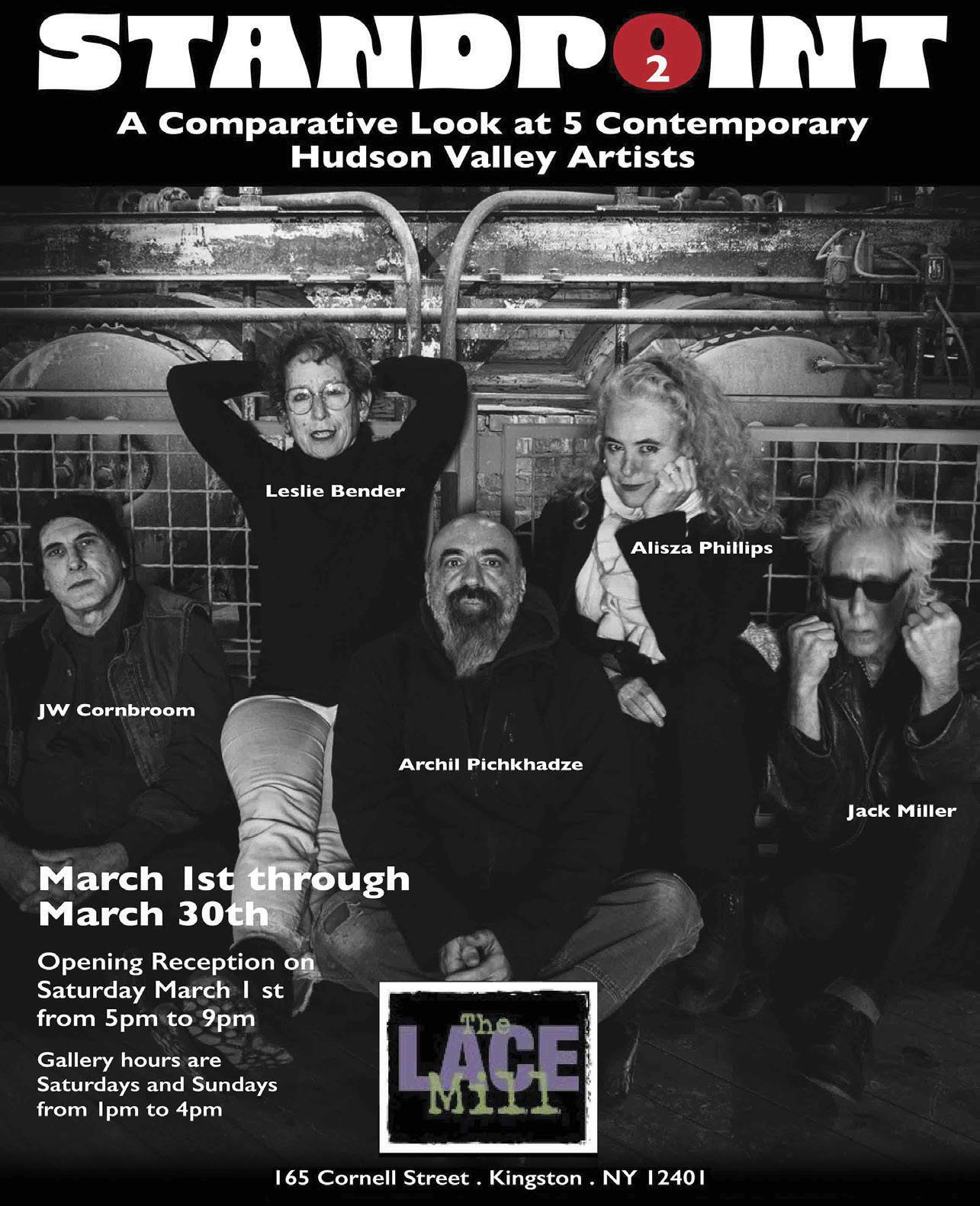




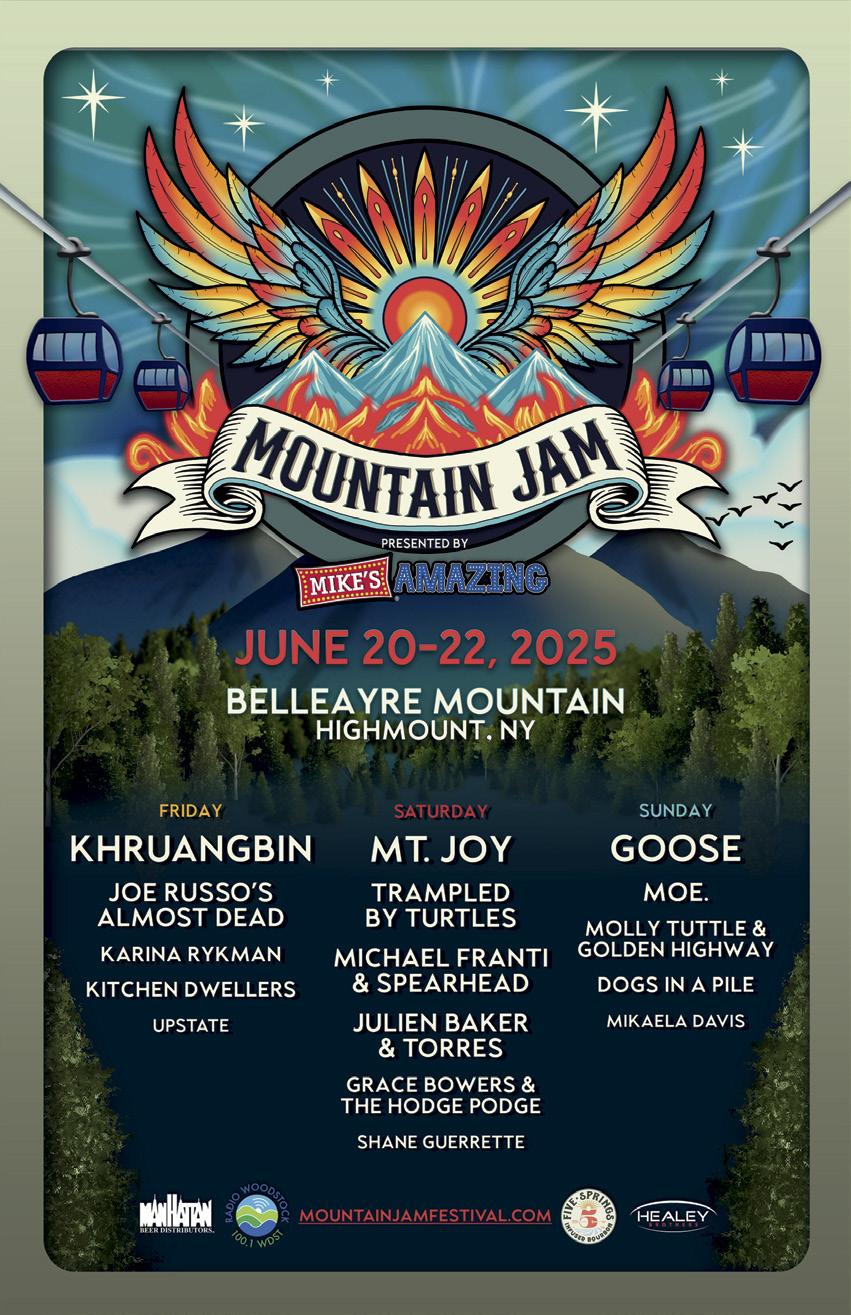




By Cory Nakasue
March always shares the signs of Pisces and Aries; the end of winter meets the start of spring (the equinox arrives on the 20th). This particular March installs a revolving door for Venus and Mercury to enter and exit both signs, multiple times, for approximately two months. Venus stations retrograde in Aries at the first of the month, and prepares for her underworld journey. For 40 days and 40 nights, the planet of consensus and pleasure will dig deep into her heart and psyche to redefine her values, desires, and attachments. In Aries, Venus values her sovereignty, but by the time she backtracks into Pisces on March 27, she’ll begin to question how much independence she truly needs. Mercury enters headstrong Aries on March 3, and prepares for its retrograde journey on the 15th. Words stab like daggers for a few weeks before Mercury backs into poetic Pisces on the 29th. This back-and-forth movement over these two signs describes a desire to take decisive actions based on faith. This could result in crusader-like heroism, collective acts of protest, or martyrdom in the name of higher forms of love.
On March 14, a total lunar eclipse occurs in Virgo. This eclipsed full Moon that sits opposite the Sun and Saturn in Pisces might burst some bubbles of hope and faith. The upshot is that we’ll learn exactly what steps we should take to firm up wobbly intentions or flimsy plans. On March 29, a partial solar eclipse in Aries urges us to pursue our desires honestly, nakedly, and directly. In Aries, there is no time like the present. For better or worse, we’re less concerned with the consequences of our actions. Finally, on the 30th, nebulous Neptune makes its first ingress into Aries, beginning a long process of glorifying and complicating all that is martial and individualistic.



(March 20–April 19)
You are particularly susceptible to love at first sight this month. You’re sure of yourself, and first impressions pack a wallop. You may also be on the receiving end of ardent pursuit. This hot and fast quality is not limited to romance and sex. You could just as easily get hopped up on a new idea or activity, but mostly, you’re just really into yourself right now. This influence is great if you’ve been feeling a lack of confidence, or have been lost in the doldrums. The cosmos is reminding you of all of the gifts you have to offer to yourself.
(April 19–May 20)
There will be some challenges to your typically steady and patient nature. A fire is being lit under your butt, and it’s making you move faster than you want (but it’s also super thrilling). If you’ve been letting a secret crush smolder, or keeping a personal passion on the back burner, it’s time to put that love into action. What is it about spontaneity and urgency that makes you feel embarrassed? Does something have to be permanent and predictable to be worthy of your affection? What are the opportunities that have passed you by because you waited a little too long?

(May 20–June 21)
What makes you you? Does your current coterie validate and support these characteristics, or are you feeling some subtle pressure to conform? The people we habitually surround ourselves with contribute to our sense of self. If you’re feeling friction, or find that you’re being asked to “tone it down,” it may be time to find a new group. This is not the time to compromise, and being yourself to the max will attract people who will want to feed your fire. There’s also a chance that you may find a hot new romance amongst your work colleagues or larger social network.

(June 21–July 22)
Your most important relationships are about to go public— or become more integrated into your public image. You could be having a “power couple” moment or getting a big boost from your affiliation with someone. Conversely, a certain person could be dragging you down. Either way, March will grant you the opportunity to gauge how closely your personal needs in a relationship align with your aspirations and how you’d like to be perceived. Having personal needs that conflict with your outward presentation isn’t necessarily a problem. Being able to identify different needs might help alleviate the pressure of irrelevant relationship goals.

LEO (July 22–August 23)
Communication, learning, and teaching should feel like bold new adventures. If they don’t, what’s stopping you from exploring subjects, ideas, and styles that depart from the familiar? Now is the time to fall in love with new philosophies and perspectives. Forge bonds with people outside your social circle. Find a mentor. If you’ve been toiling in obscurity on a piece of writing or music, it’s time to publish or perform it. This is less about achieving goals and more about expanding your experience of who you are. Follow your curiosities like a hunter. Your prey is anything that will blow your mind.

VIRGO (August 23–September 23)
Ready to take your relationships to the next level? Ready or not, the urge to merge more deeply, take risks, and explore uncharted territory with partners will announce itself quite loudly. I often advise partners, whether they’re romantic, platonic, or professional, that in order to maintain a healthy relationship, you have to risk losing it once in a while. If something isn’t growing it will die. Venus coming to a standstill in Aries will prompt the initiative to try something new by way of boredom. Its eighth-house position might have you asking “is that all there is?” It’s time to find out.

LIBRA (September 23–October 23)
People are after you. Whether it’s someone pursuing you romantically, trying to lure you away from a job to come work for them, or just plain calling you out, you’ve got something people want. This puts you in a position of needing to know what you want. You may be susceptible to attention and flattery. You may feel pressured to please others or not let anyone down. But if someone is coming on strong, buy yourself some time to muster up the courage to make your own demands. This may be difficult because you’re extra empathetic now. Don’t get steamrolled.

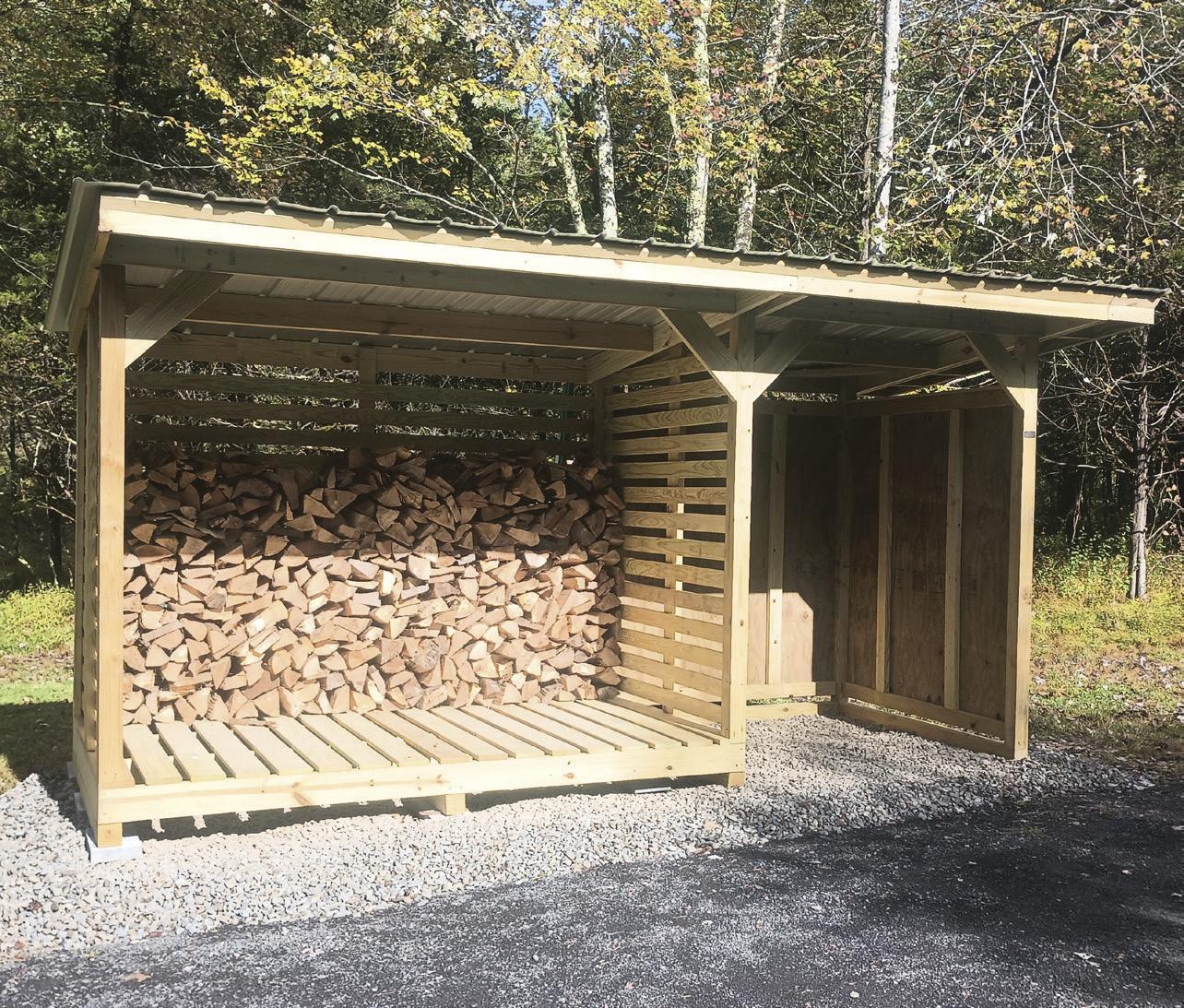








SCORPIO (October 23–November 22)
For you, love is action. It’s taking the initiative to be of service to those you care about. It’s also active problem-solving and the joy of pumping vitality into the daily practice of being a good partner. This month, try not to go overboard. There’s a fine line between being an effective problem solver and a drill sergeant. One of the best things you could do this month is direct some of that love and service toward yourself. Treat yourself to extra attention and care. Start that project that’s been ignored for far too long, or sign up for that martial arts class.

SAGITTARIUS (November 22–December 22)
No one is feeling spring more than you. It’s as if every cell in your body is having a primal awakening to its own life force. What will you create? What will you penetrate with your will? How much will you risk to feel the thrill of being alive? These are the questions that might come up for you, because whatever your answer is, it’s going to be different than what it was last year. There’s a new direction you need to take to find the satisfaction that you crave. New paths to authentic selfexpression, romance, and fun need to be explored.

(December 22–January 20)
There are many pleasures to be found at home. Internal, emotional, and psychological adventures beckon, and you get to cultivate the time and space to commune with yourself. Anyone who interrupts these internal journeys will have hell to pay. You’re embarking on a process of getting right with yourself and making things the way you want them. This may involve a home relocation, redesign, or the addition or subtraction of cohabitants. Whatever you decide to do about your external living space could also be applied to your internal living space. How can your body be a better container for new desires?

(January 20–February 19)
Are your larger values reflected in the things you do everyday? Is it time to step into a leadership role in your community, neighborhood, or family? Or, is it time to go your own way and do your own thing? Over the next couple of months, you have the opportunity to align your loftier ideals and philosophies into daily practice. It’s not a dramatic or glamorous project, but it still could be life-changing. You’re looking to instill your most cherished beliefs into the local culture you inhabit, and you may have to be the one who gets things started.


(February 20–March 19)
You need to spend the next couple of months taking charge of your resources and investing more time, energy, and love in yourself. The more we invest in ourselves, the more self-worth we experience. The more attention we give to the things and people that sustain us, the clearer we get about our values. It’s time to “put your money where your mouth is.” If you’ve been talking a good game about valuing yourself, do your actions align? If not, it’s time to practice. Dare to ask for nothing less than what you truly need, and pay yourself first.
Adams Fairacre Farms Back Cover
The Art Effect 37
Art Now Management 75
Arts Westchester ....................................55
Augustine Nursery 31
Back Home Dispensary 18
Bard College at Simon’s Rock 4
Bardavon 1869 Opera House + UPAC ..68
Beacon Natural Market 23
Berkshire Food Co-op 23
Berkshire South Community Center 36
Bill Arning Exhibitions / Hudson Valley 64
Bistro To Go 24
Black Walnut Farm 46
Brava 57
Cabinet Designers, Inc 31
Cantine Veterans Memorial Sports
Complex Town of Saugerties 45
The Capa Space 55
Caramoor Center for Music and the Arts, Inc 55
Catskill Mountain High 13
The Chapel Restoration 24
Colony Woodstock 68
Curious Jane Camp 36
Custom Window Treatments 31
Cutting Edge Design / Nick Brown Wood Working 32
Dia Beacon 64
Doma 41
Domes Dispensary .................................14
Farmers Choice Dispensary 10, 13, 15
Garrison Art Center 37
Garvan’s Gastropub 25
GKontos Roofing Specialists .................32
Glenn’s Wood Sheds 77
Grounded Dispensary 16
Guido’s Fresh Marketplace 23
Hawthorne Valley Association ...............34
Helsmoortel Insurance & Realty 46 Hempability 13
HERbal Woodstock 19
Herrington’s ............................................28
High Meadow School 37
Horses For A Change 36
Hot Water Solutions, Inc. 1
Hudson Clothier/Canvas + Clothier .........4
Hudson River Maritime Museum 34
Hudson Roastery 24
Hudson Valley Garlic Festival 45
Hudson Valley Native Landscaping 32
Hudson Valley Trailworks 32
Hudson Valley Writing Project 37
J&G Law, LLP .........................................77
Kildonan’s Camp Dunnabeck 35
Kinosaito Arts Center 55
Lace Mills Arts Council 75
Lagusta’s Luscious .................................23
Liminal Bodywork 41
The Local Center for Arts and Culture 49
LotusWorks Wellness/Cannabis Dispensary 17
Mahaiwe Performing Arts Center 57
Mark Gruber Gallery 78
Mark Houghtaling LMT 41
Menla 41
Mid Valley Wine & Liquor 7
Middle Way School 36
Montano’s Shoe Store 45
Mountain Laurel Waldorf School 8, 35
Mountain View Events 4
Mountaintop Waldorf School


“So You Think I’m Too Old To...” at HVMoca in Peekskill
Luis Fonseca’s Selfs Portrait hangs in the “So You Think You’re Too Old To...” at HVMoCA in Peekskill like a visual echo, a conversation across time conducted in light and shadow. The piece, which juxtaposes a self-portrait taken in his early 30s with another in his late 60s, is a striking meditation on time, self-perception, and the persistence of artistic practice.
Fonseca, now 68, has spent a lifetime behind the camera. Though he works in a variety of media, including cyanotypes and mixed media, Selfs Portrait is a return to the fundamentals: an image, a moment, a gaze held across decades.
The original portrait, taken in 1989, captures a younger Fonseca newly shaven, reacting to the inevitable encroachment of hair loss. “I just did not like the pattern of my hair, it was just driving me nuts,” Fonseca recalls. One evening, he simply shaved it all off and, with a photographer’s instinct, documented the transformation. Shot on film with a Petri, the print was developed in his own darkroom, a hallmark of his
black-and-white work at the time.
Fast-forward nearly 40 years. Fonseca recreated the same pose in the same apartment he has called home for nearly four decades. The second image, digital and immediate, contrasts with the labor-intensive process of the first, yet the two remain eerily continuous. A simple Photoshop composite aligned the two portraits, uniting them into a single frame.
The power of Selfs Portrait lies not just in its technical execution but in its emotional resonance. The juxtaposition is not a lament of youth lost but an affirmation of selfhood retained. “It’s the same space, the same angle, same thing,” Fonseca notes, “except instead of that black-and-white film camera, it’s a cell phone.” In a world obsessed with impermanence and reinvention, Fonseca’s diptych insists on continuity—on the notion that we do not shed our younger selves, but carry them forward.
“So You Think You’re Too Old To...,” which features work by 68 artists, aged 62 to 94, makes a compelling
case for the creative resurgence that can accompany aging. Artists like Louise Bourgeois and Phyllida Barlow found their most powerful voices in later years, freed from the constraints of expectation. Fonseca himself credits his recent surge in artistic output to this stage of life, coupled with the shifting perspective brought on by the Covid years. “It was a sequence of events,” he says, “where I started to make work that I would present to galleries, get feedback, and develop with more purpose.”
If Selfs Portrait has a lesson, it’s that the artistic self does not diminish—it accumulates. The eye that framed the shot in 1989 is the same one that framed it in 2023. The hands may have changed, the tools evolved, but the vision remains. In Fonseca’s work, time is not an adversary but an accomplice, bearing witness to a self both constant and ever-becoming.
“So You Think I’m Too Old To...” will be exhibited at HVMoCA in Peekskill through May 3.
—Brian K. Mahoney

Spring to life in New York’s Sullivan Catskills, where the food is plentiful, the craft beverages are flowing, and the fun is never-ending. Tour the Dove Trail— it’s selfie heaven. Indulge at our spas and wellness centers. Roll the dice at Resorts World Catskills. Make a splash at Kartrite Resort and Indoor Waterpark. Sing along at Bethel Woods Center for the Arts.
Restaurant Week March 31-April 13
Catskills BBQ June 7
Jazz


June 22
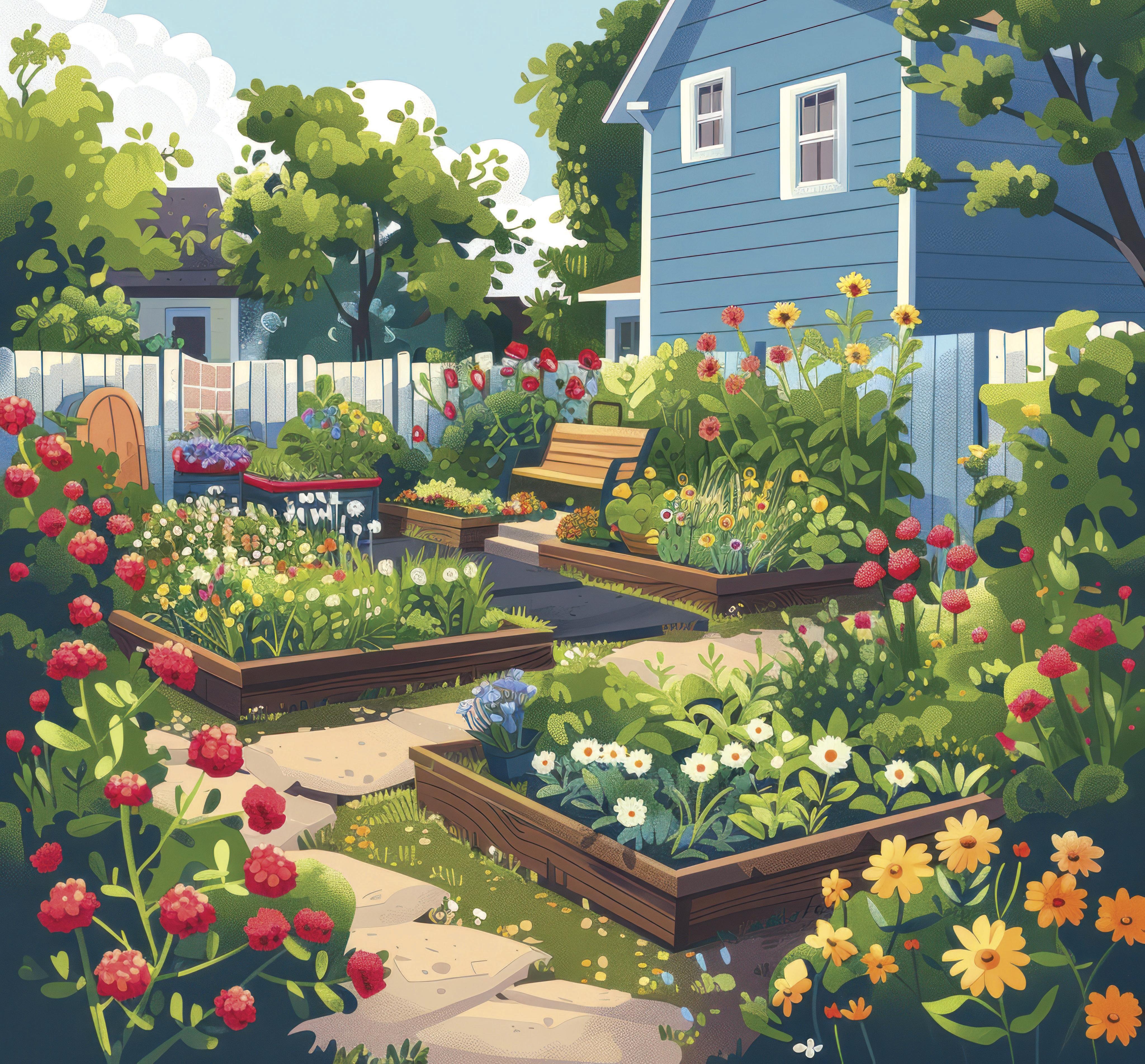
Can you feel it? Spring is near – it’s time to dust off the winter blues and at Adams, we’re ready to help your garden dreams bloom into reality! It’s the perfect time to start a big, beautiful, and bountiful season. At Adams, we pride ourselves on offering plants, supplies and expertise you won’t find anywhere else, just waiting to make your garden the talk of the town. In addition to hundreds of plants, imagine your home and garden adorned with the rich colors of Azalea and Hydrangea bushes, flowering and shade trees and lush greenery. Add a stone walkway or privacy fence and complete your dream garden goals! Visit our Garden Centers and Backyard Businesses today, and let us help make your garden dreams come true!